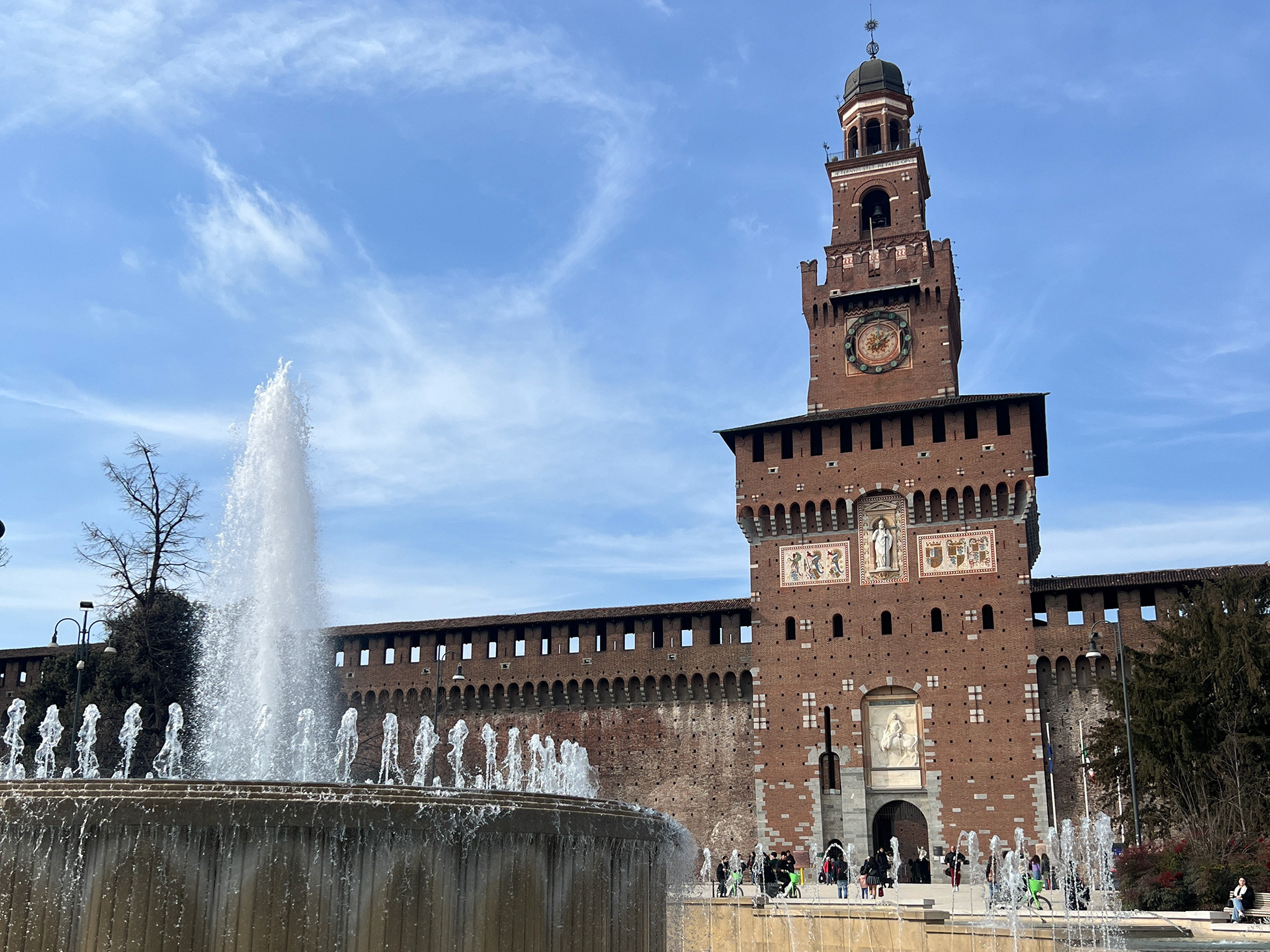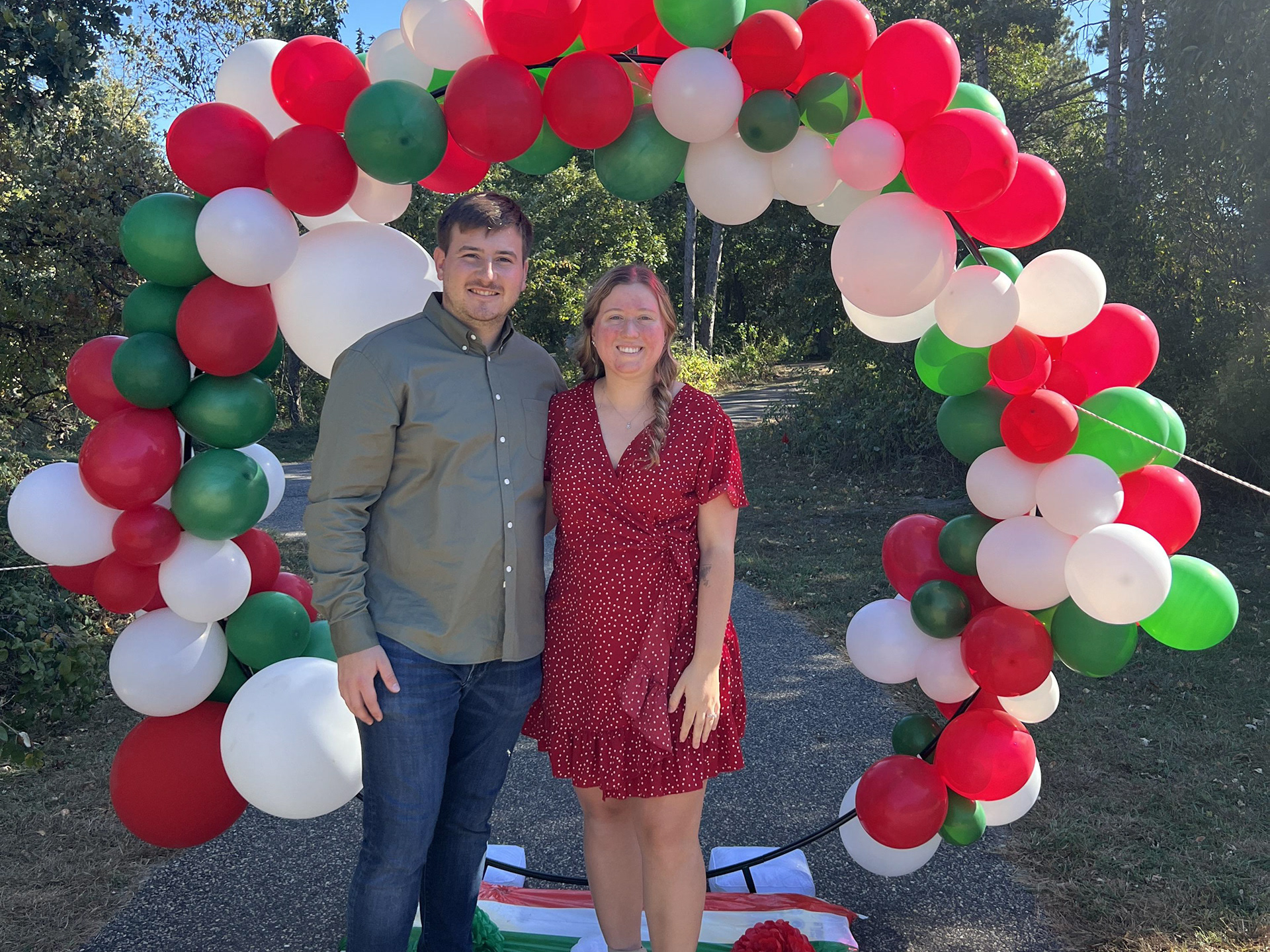Arriving and the Streets of Verona
On our first Thursday in Milan, we woke up early and headed to Milano Centrale where our regional Frecciarossa (Red Arrow) train was waiting for us. There are various ways to get around Milan without a car, but at this point, we had yet to use anything but Uber, which is the most expensive.
The closest Metro, Porta Genova, is about 10 minutes away if you walk somewhat fast. We had a backpack’s worth of stuff for a one night trip.
We arrived at Milano Centrale, found our platform and got comfortable on the train. The trip from Milano Centrale to Verona is only about 90 minutes on the faster train. But, considering walking from our apartment to Centrale, then from Verona to our AirBnb, it probably was about 3 hours to travel.
Verona is beautiful. It is an old city that dates back to at least 89 BC when it became a Roman colony. It served as a junction of many roads between Europe and northern Italy. The Adige River flows through Verona, the 2nd longest river in Italy. In the old city area, you will find narrow roadways and walking streets between quaint buildings no more than 7 stories tall. Modern shops and restaurants surround you as you walk throughout the town.

I Portoni della Brà, the primary entry point for pedestrians and vehicles moving into the city from Piazza Bra
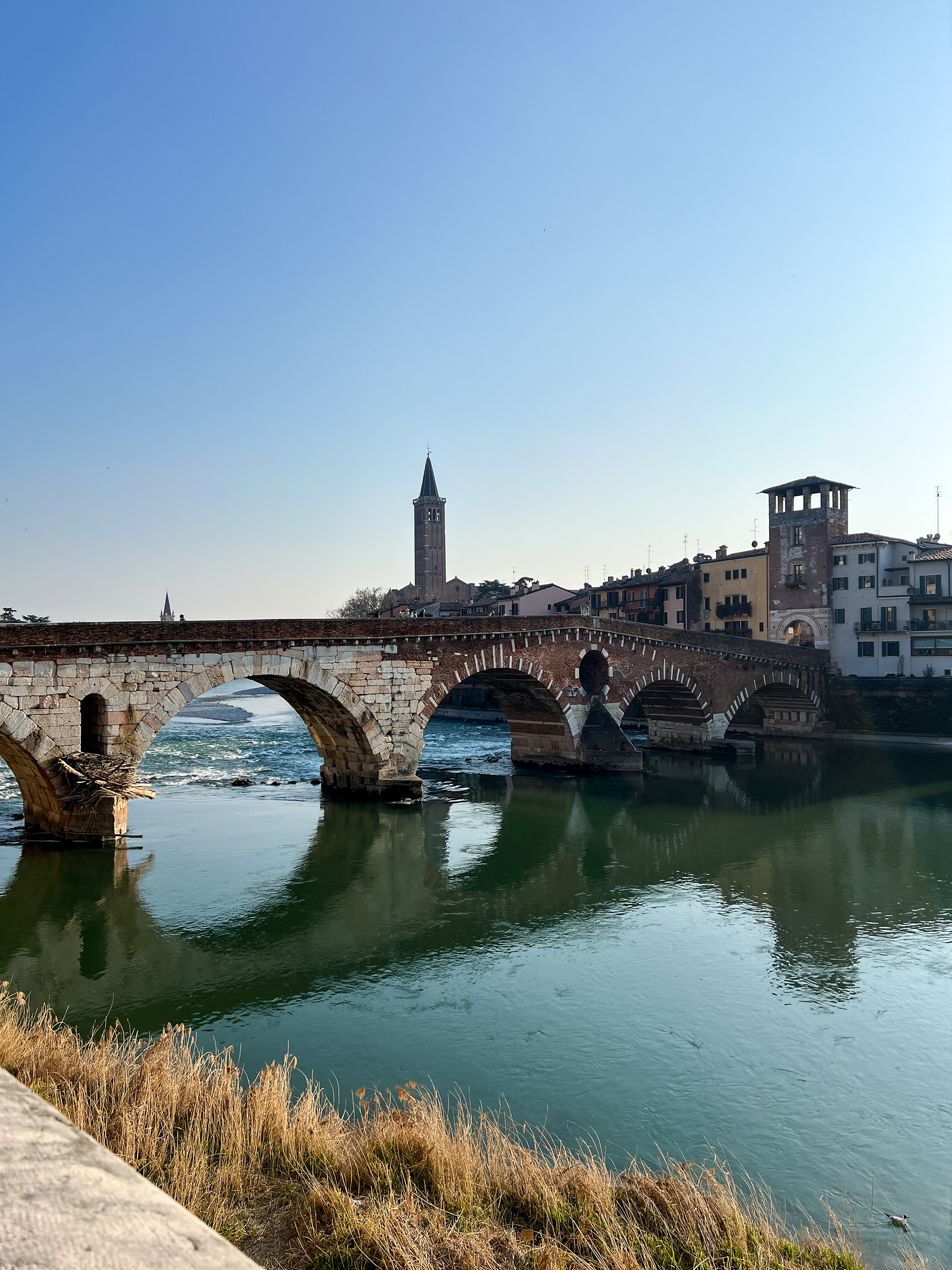
Ponte Pietra
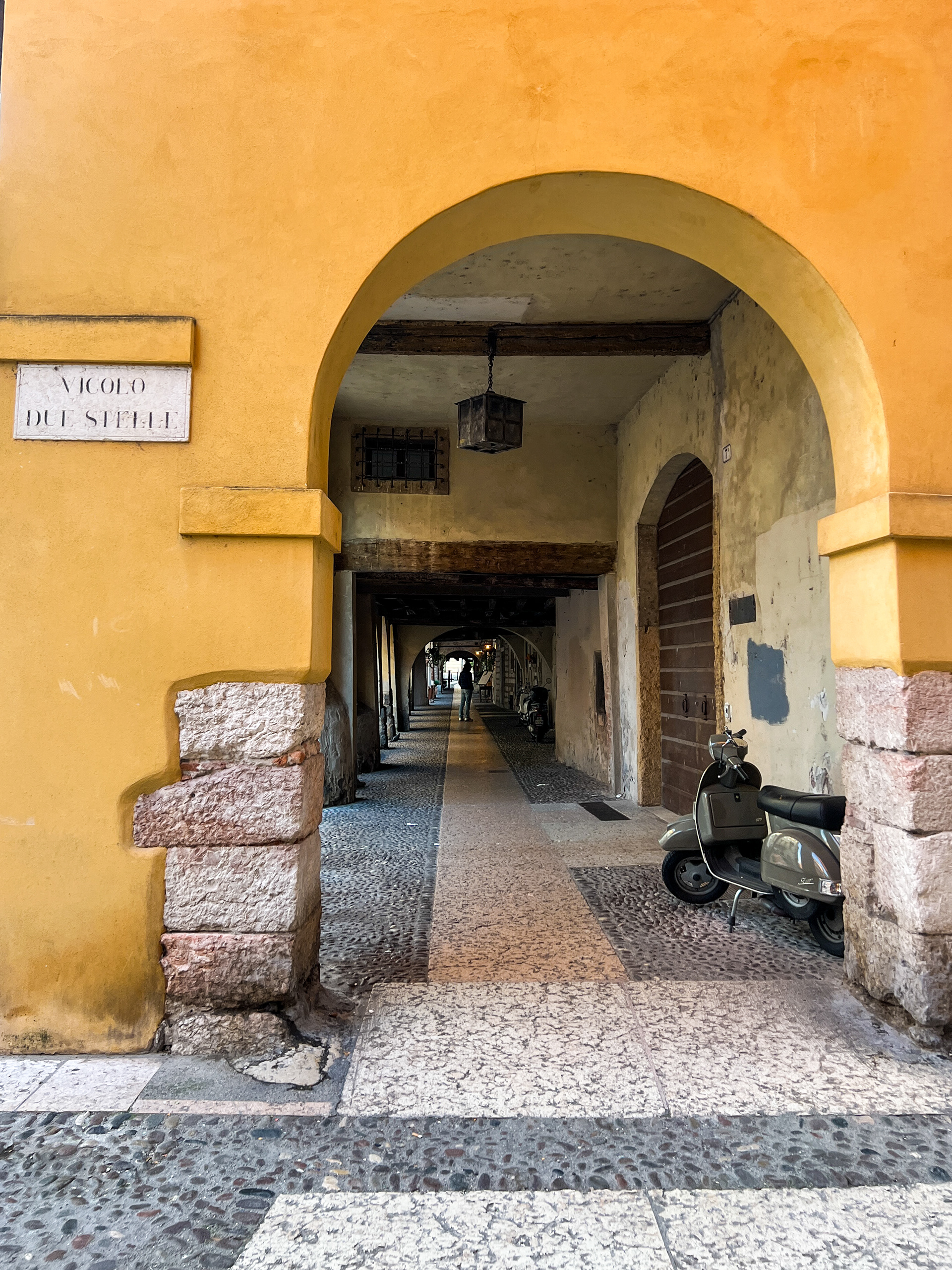
An alleyway in Verona
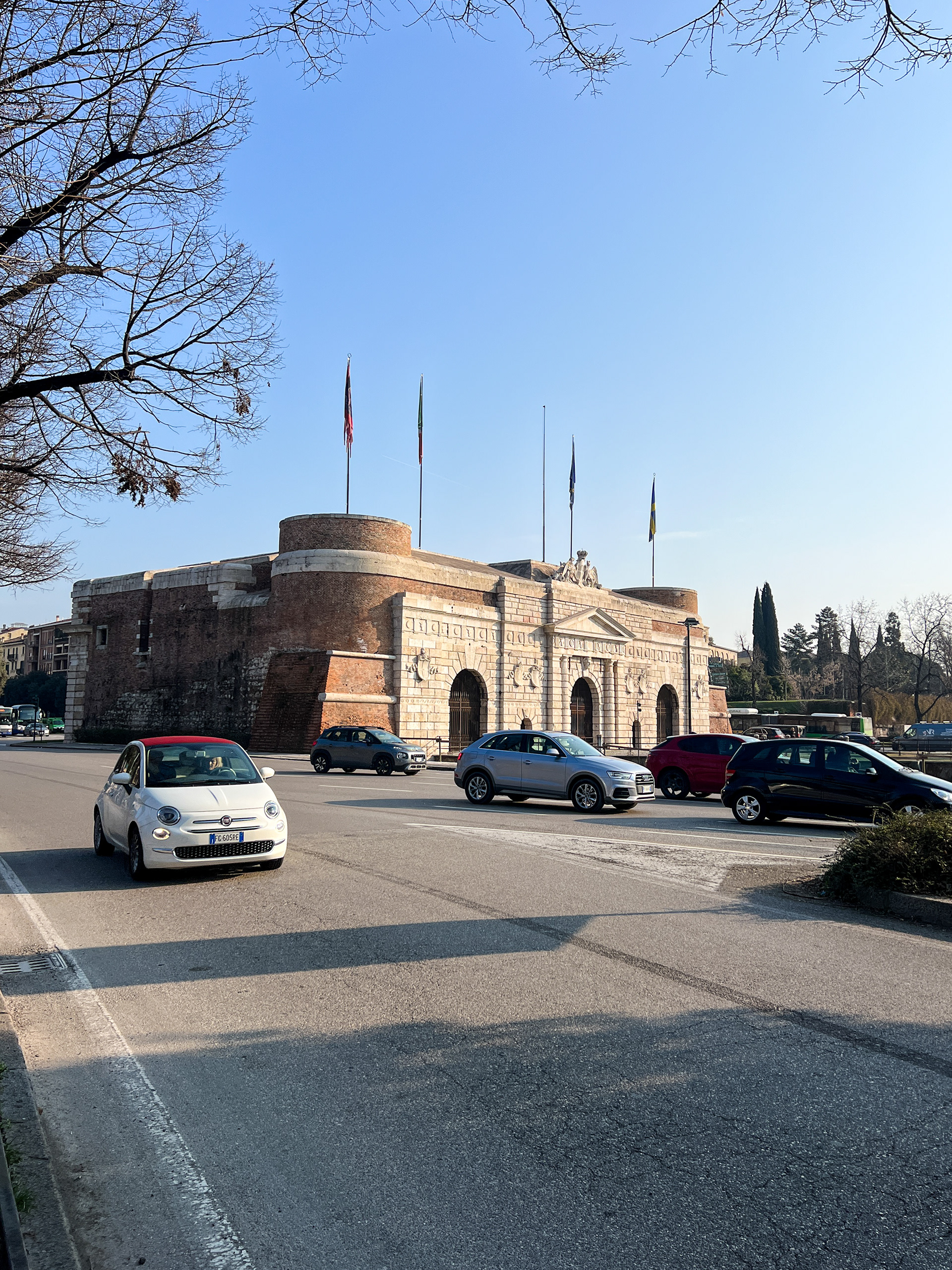
Porta Nuova, a gateway to the historic center of Verona

Blue vintage car in Verona

Porta Borsari, an ancient Roman gate in Verona
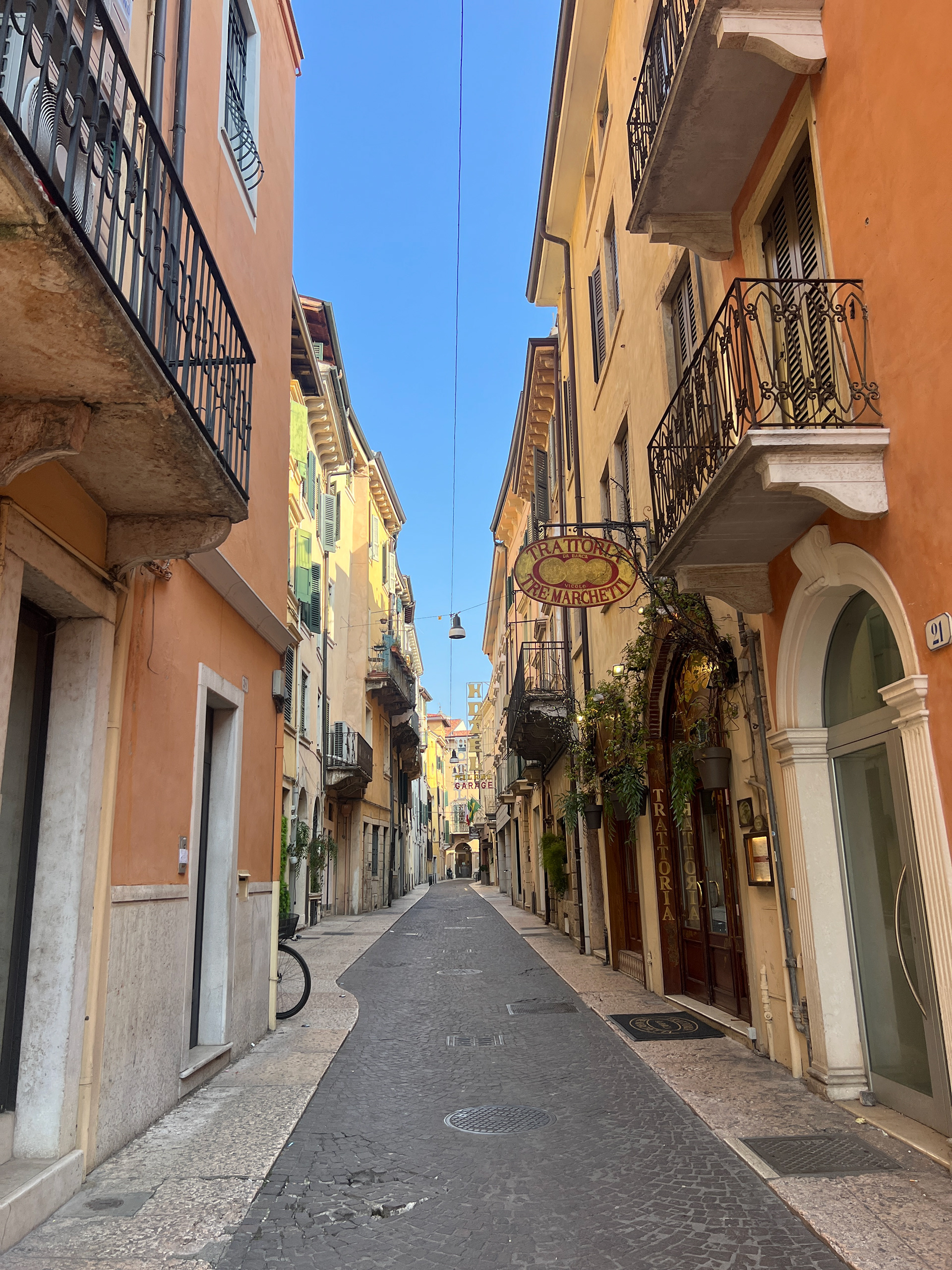
An alleyway in Verona

Arco dei Gavi
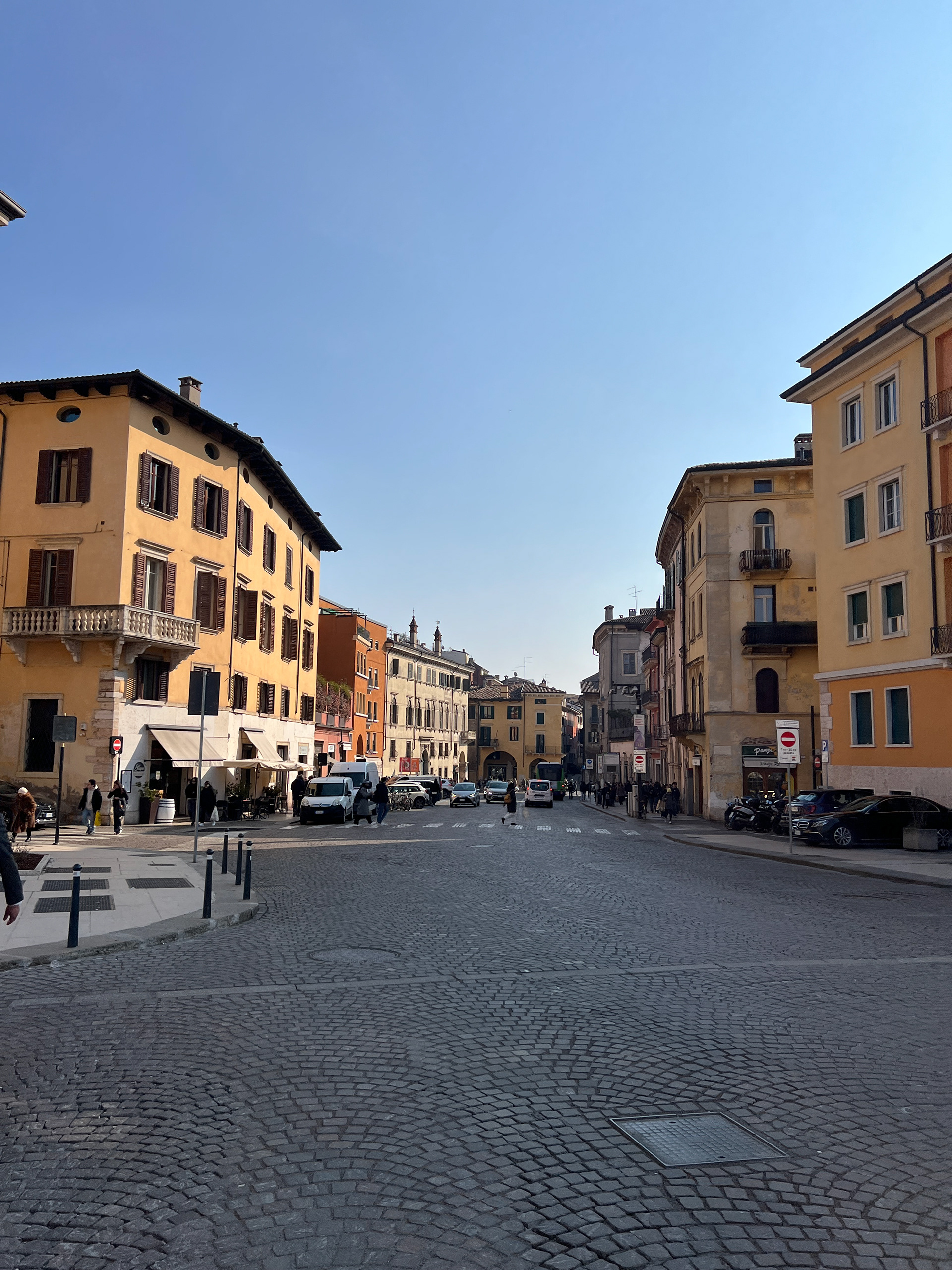
A street in Verona

Emilie and Daniel with the Adige river and Santuario Madonna di Lourdes in the background
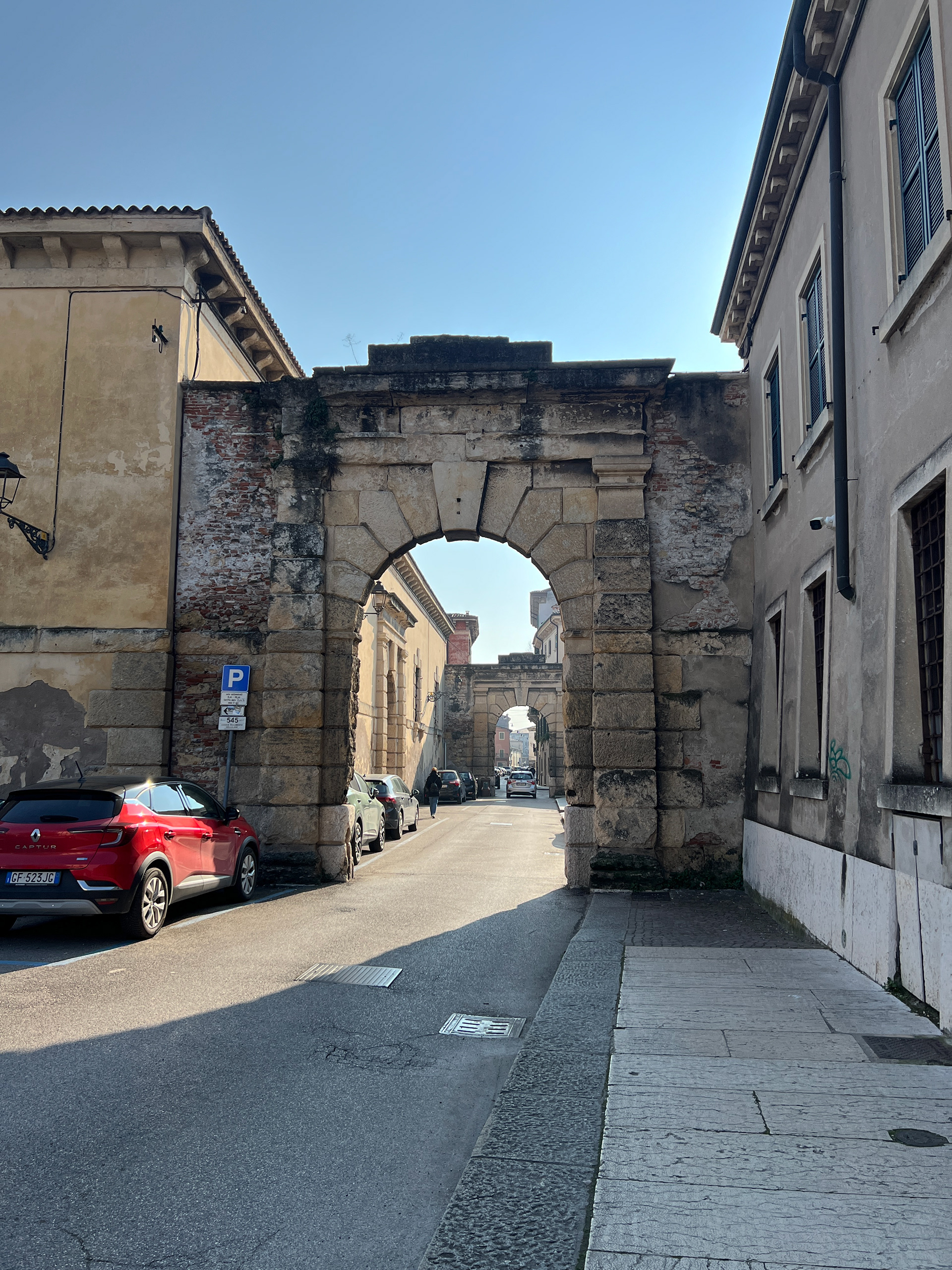
An arch in Verona
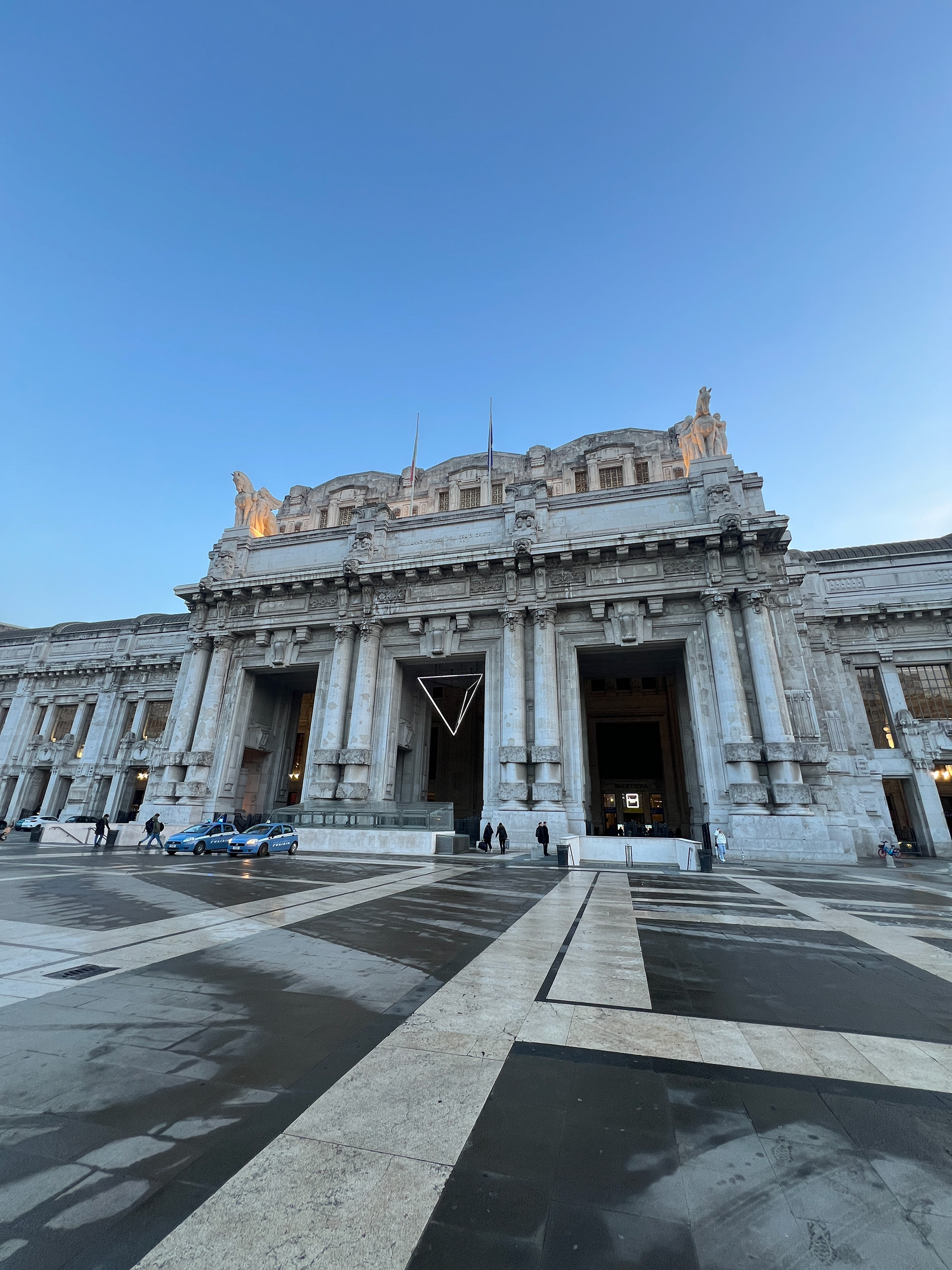
Milano Centrale, our regional and international train station
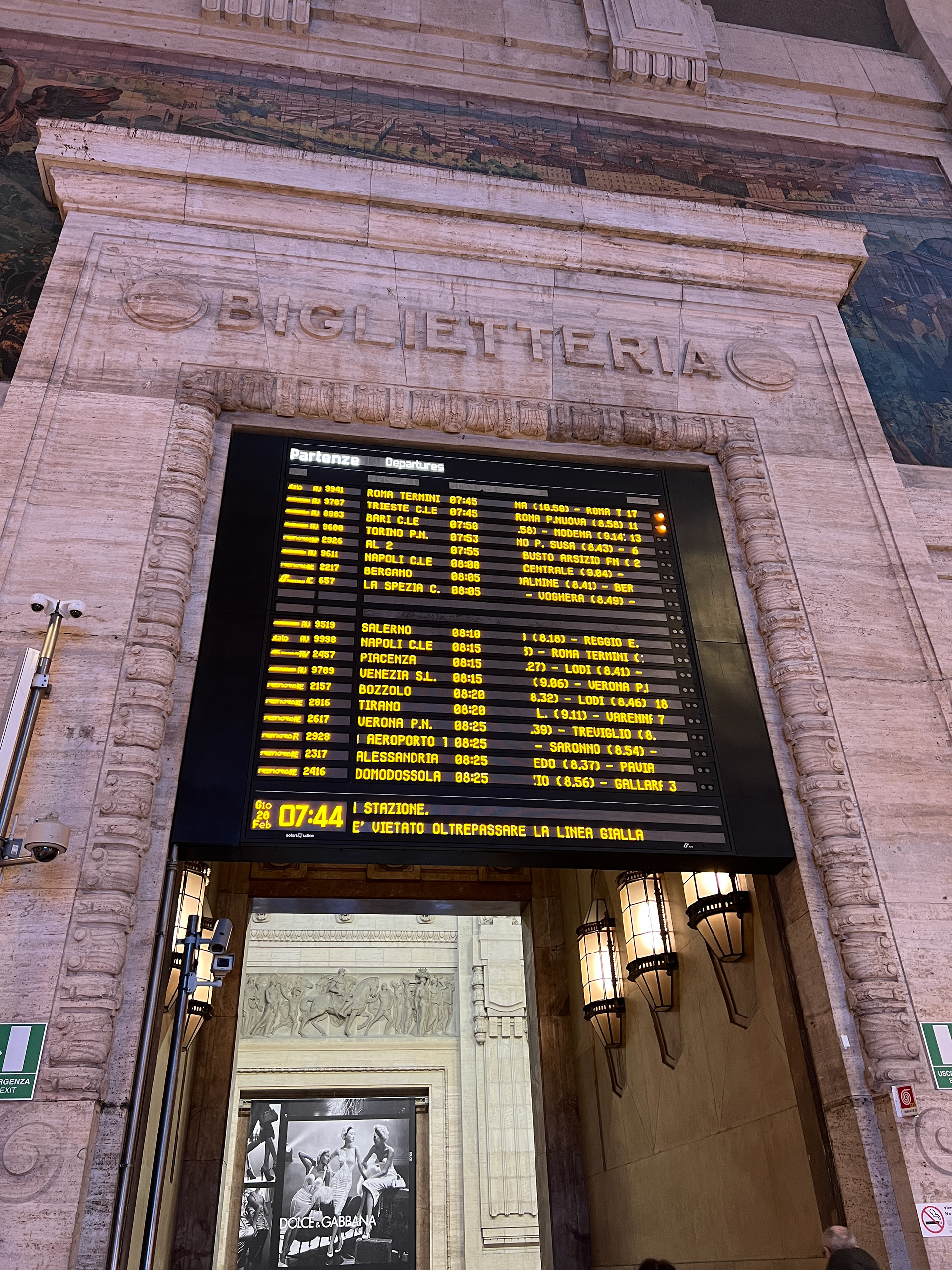
The platform display board in Milano Centrale
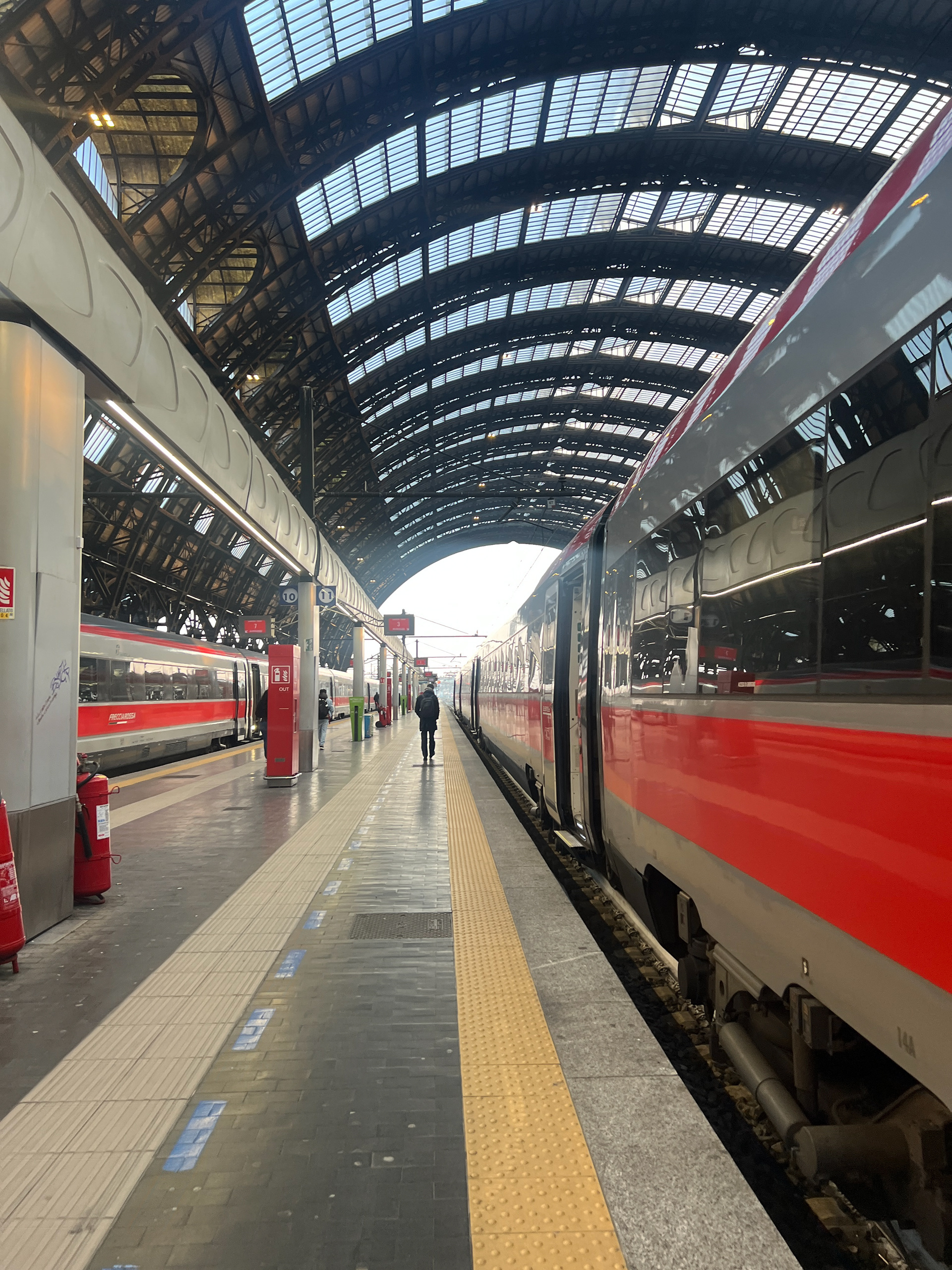
Our train to Verona
Arena di Verona
Verona houses the third largest and likely the most well kept amphitheater in Europe. Built by the Romans in AD 30, the Verona Arena originally sat 30,000 people for various events throughout history, such as gladiator contests, jousts, and exotic animal exhibitions. It is still used today for shows and operas. When it is not in use, visitors can pay a small entry fee to explore the preserved architecture.
We were visiting in the off season, still February. We found the weather to be nice and refreshing, since it was not -20 degrees fahrenheit like we were used to. However, it was not very busy during our time there, which was nice.
We spent some time walking around the Arena. Today, there are seat numbers on some of the square rocks for events they will be hosting soon. Standing on top of the arena gives you a cool view of the city.
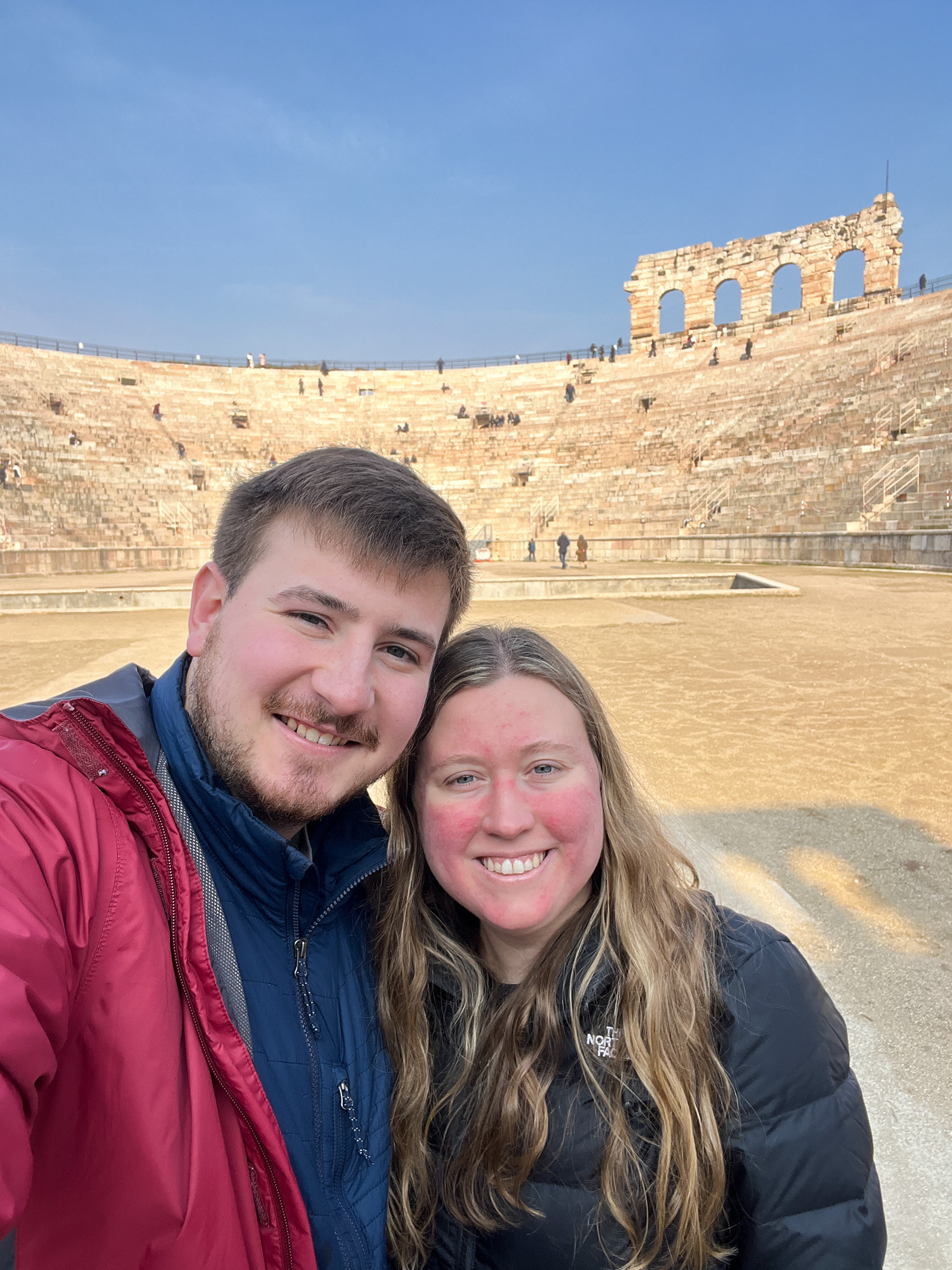
Daniel and Emilie in Arena di Verona

Arena di Verona
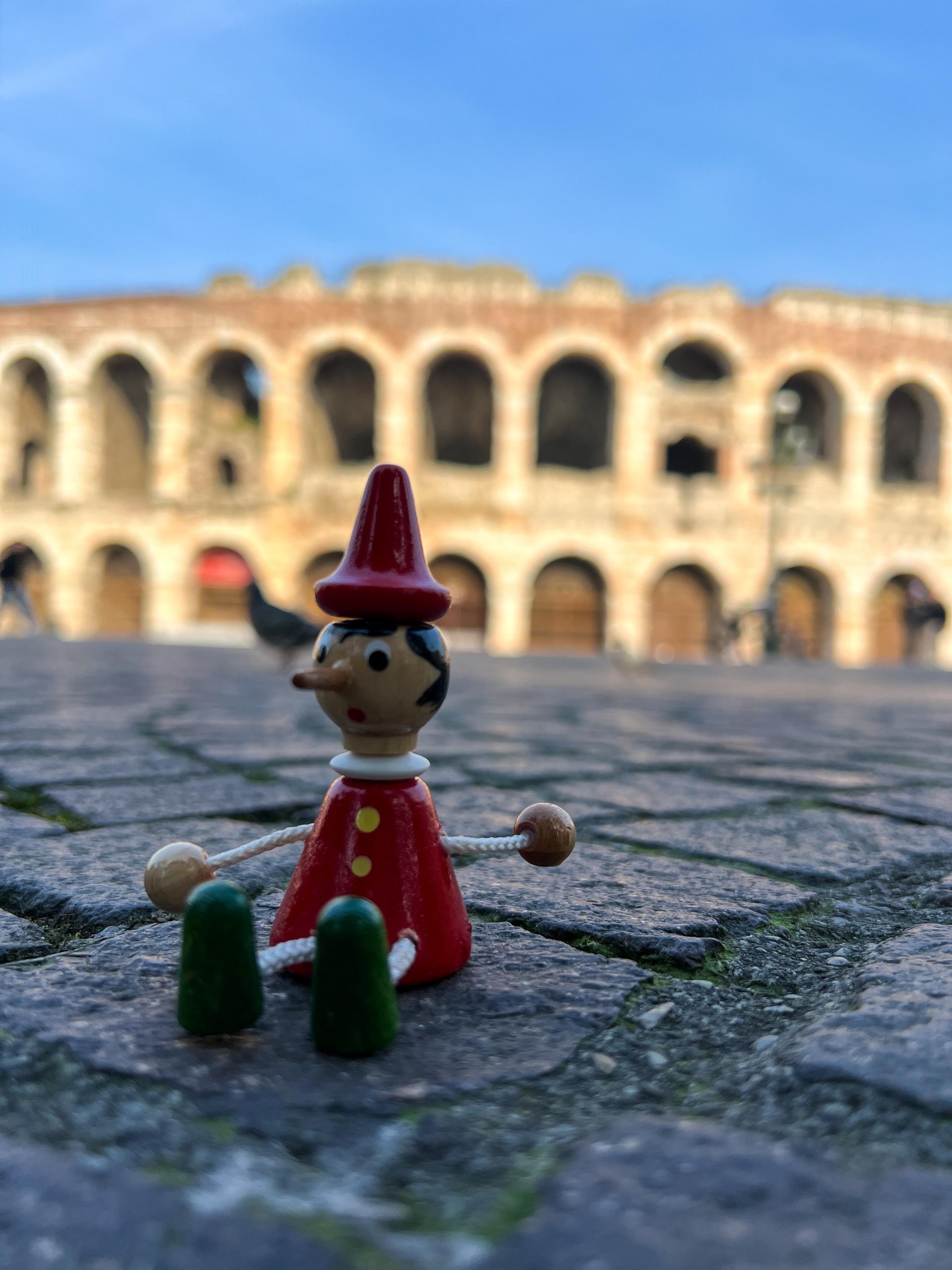
Pinocchio in front of Arena di Verona
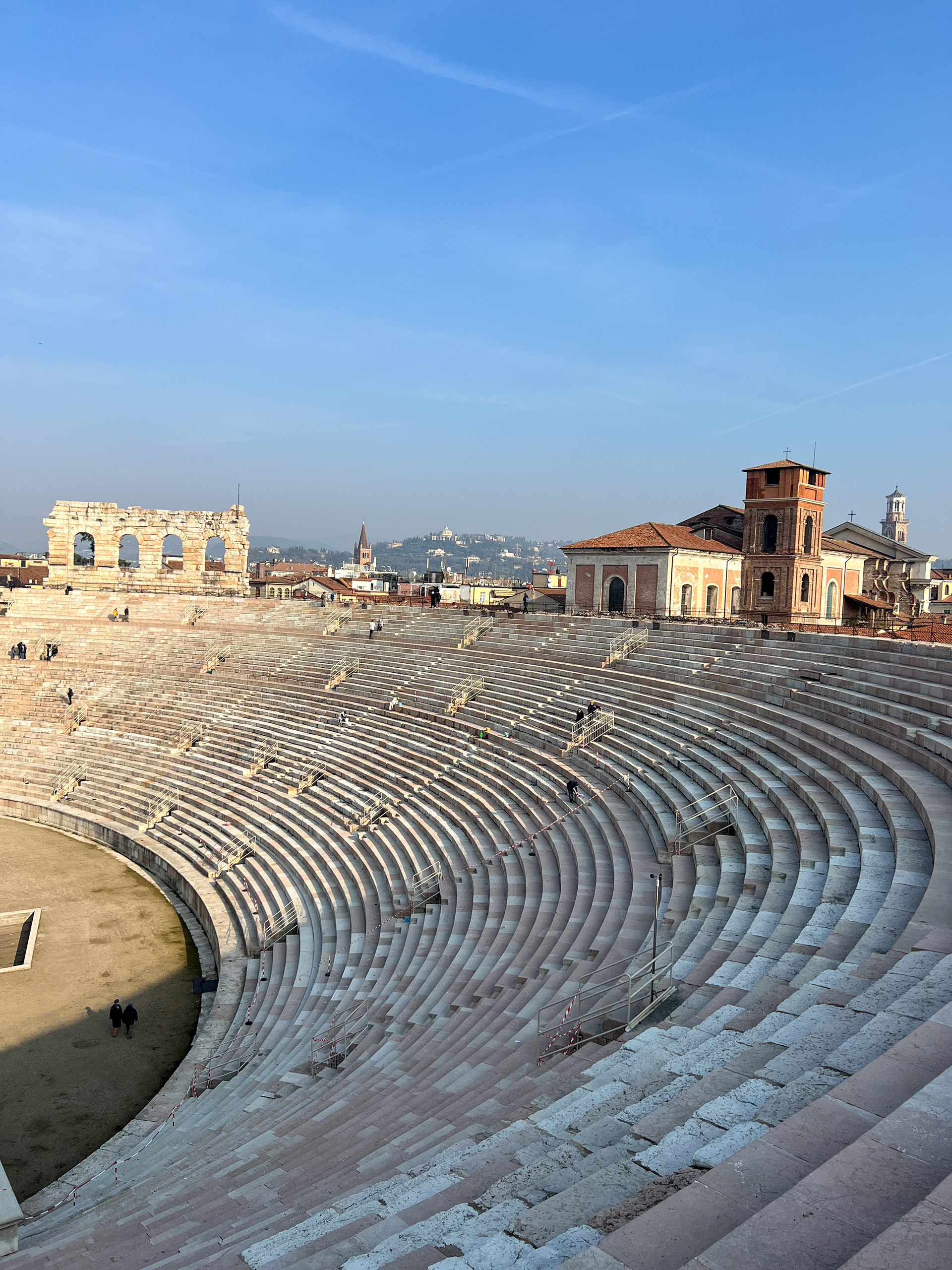
Inside Arena di Verona

A city view from the top of Arena di Verona
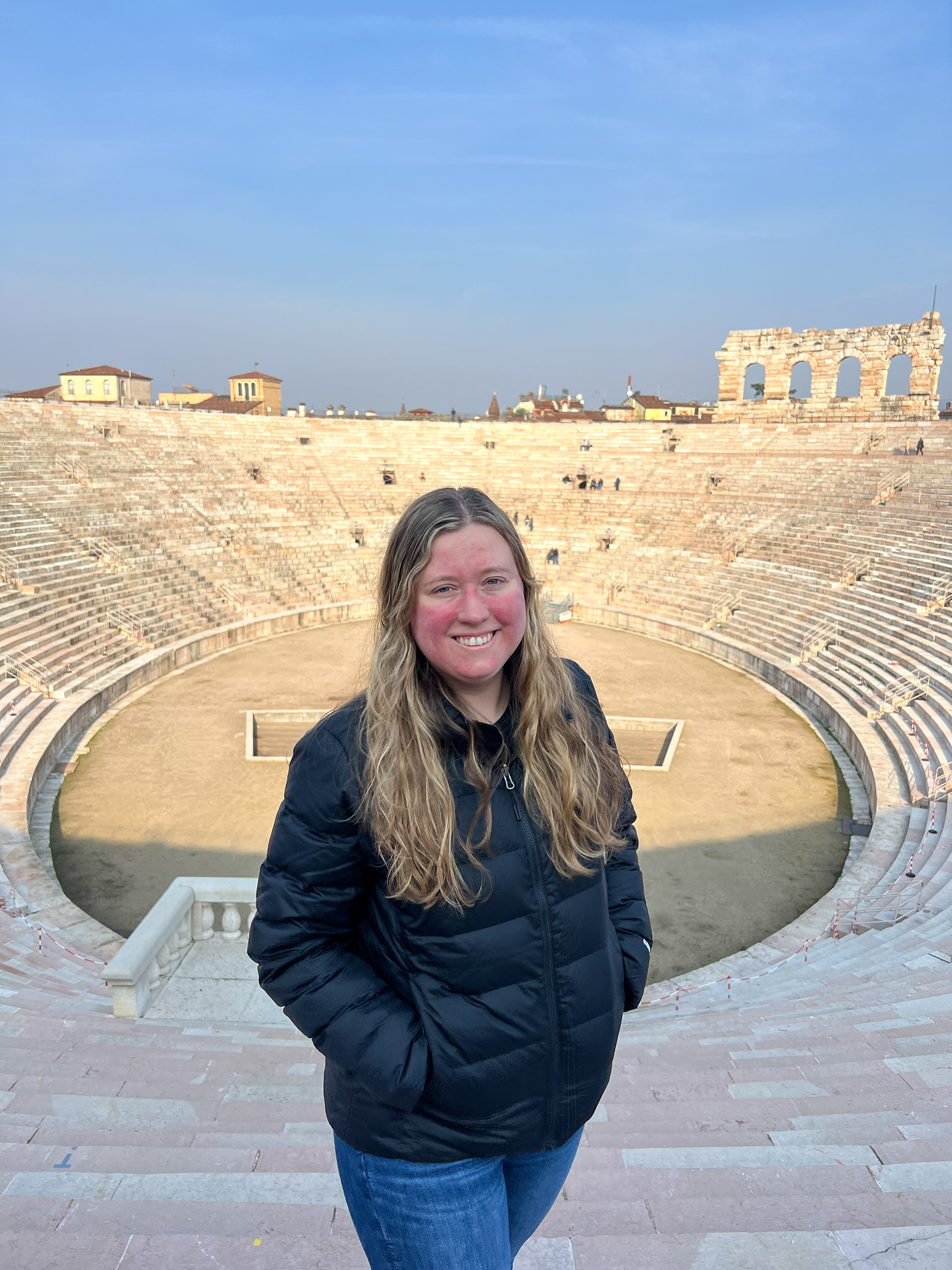
Emilie inside Arena di Verona

A city view from the top of Arena di Verona
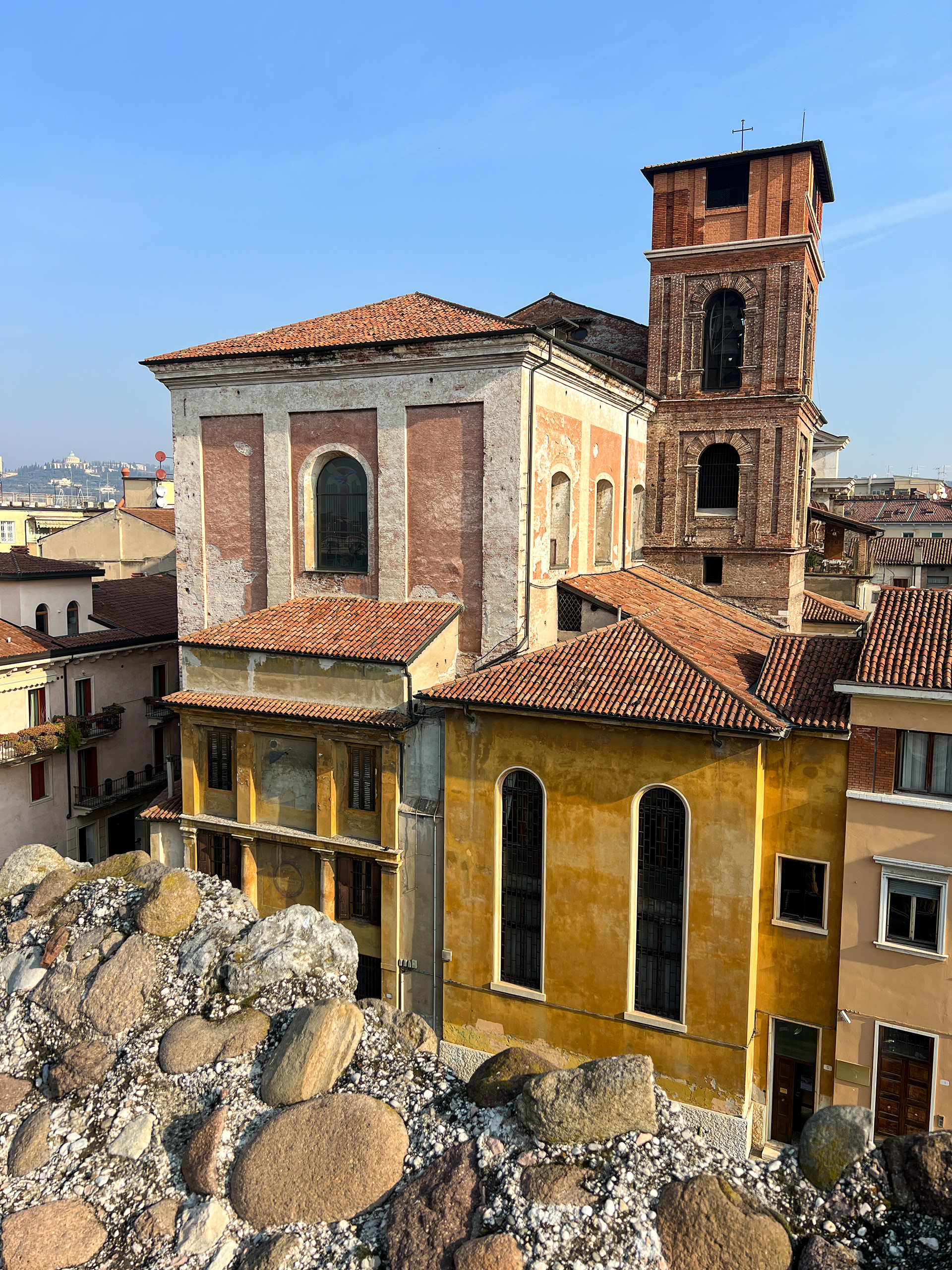
A view from the top of Arena di Verona
Castelvecchio & Scaliger Bridge
Castelvecchio (Old Castle) is, you guessed it, a castle in Verona. Visitors can walk inside that main courtyard and other parts of the castle, the walls, and the attached Scaliger Bridge for free, but you can pay to visit the museum. We did not.
The castle dates back to 1355, built by the Della Scala family, a ruling dynasty of Verona in the Middle Ages. It was designed to be both a defensive fort and a home, but was used for various uses after being invaded by the Venetians, the French, and the Austrians. During Napoleonic and Austrian rule it was used as a barracks.
It underwent a major refurbishing in 1928 and now it houses Veronese art and sculptures from the Middle Ages onwards.
The original bridge, built by the Scala family as well in 1356, stretches across 120 meters. It was supposedly built to grant Cangrande della Scala a safe escape in case of rebellion of the population against his tyrannical rule (according to Wikipedia). In 1945, retreating German troops destroyed the bridge but it was reconstructed in 1951.
Legend has it, the designer of the bridge, Guglielmo Bevilacqua, arrived at the inauguration on horse, ready to flee away in case it came crumbling down.
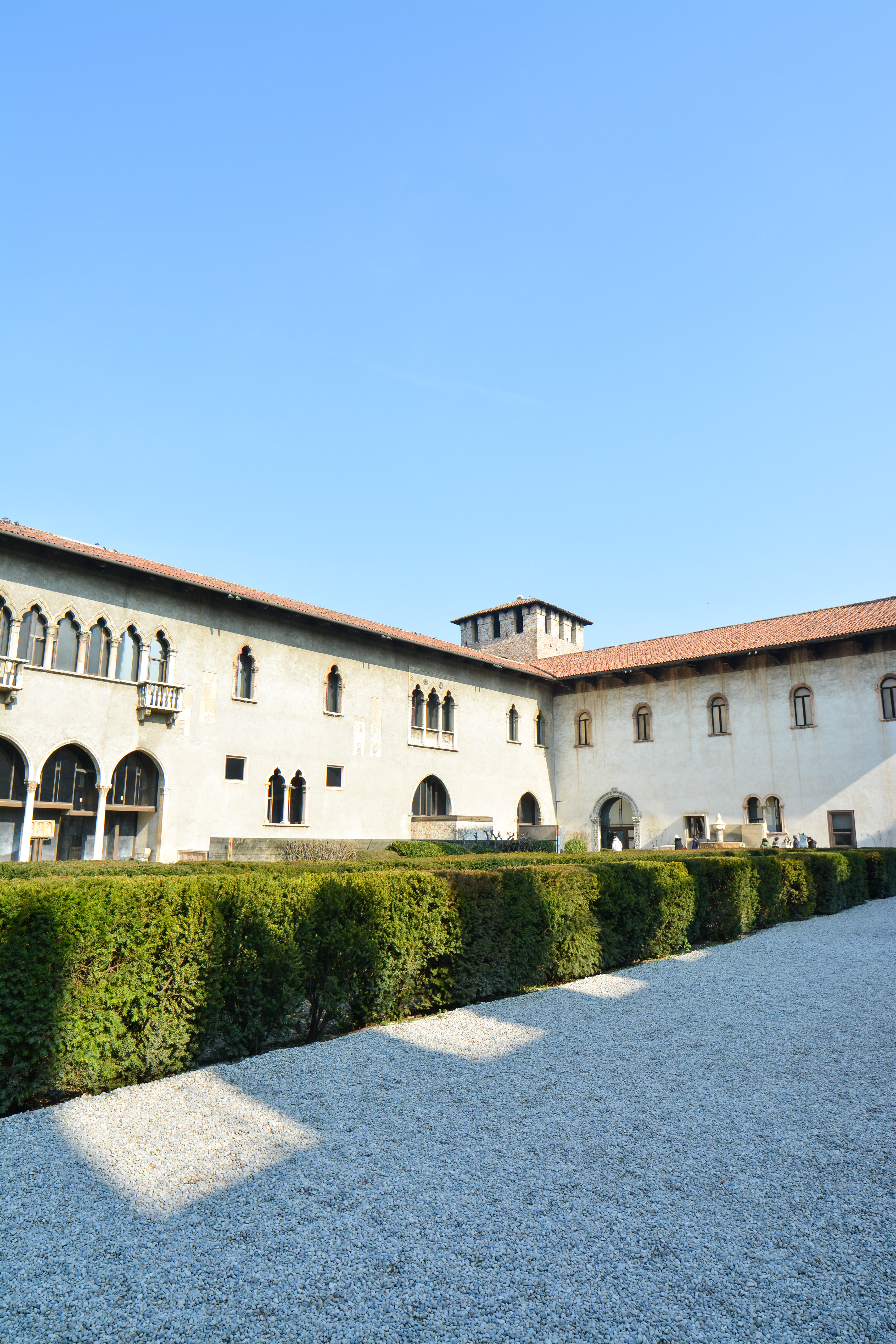
Castelvecchio Museum
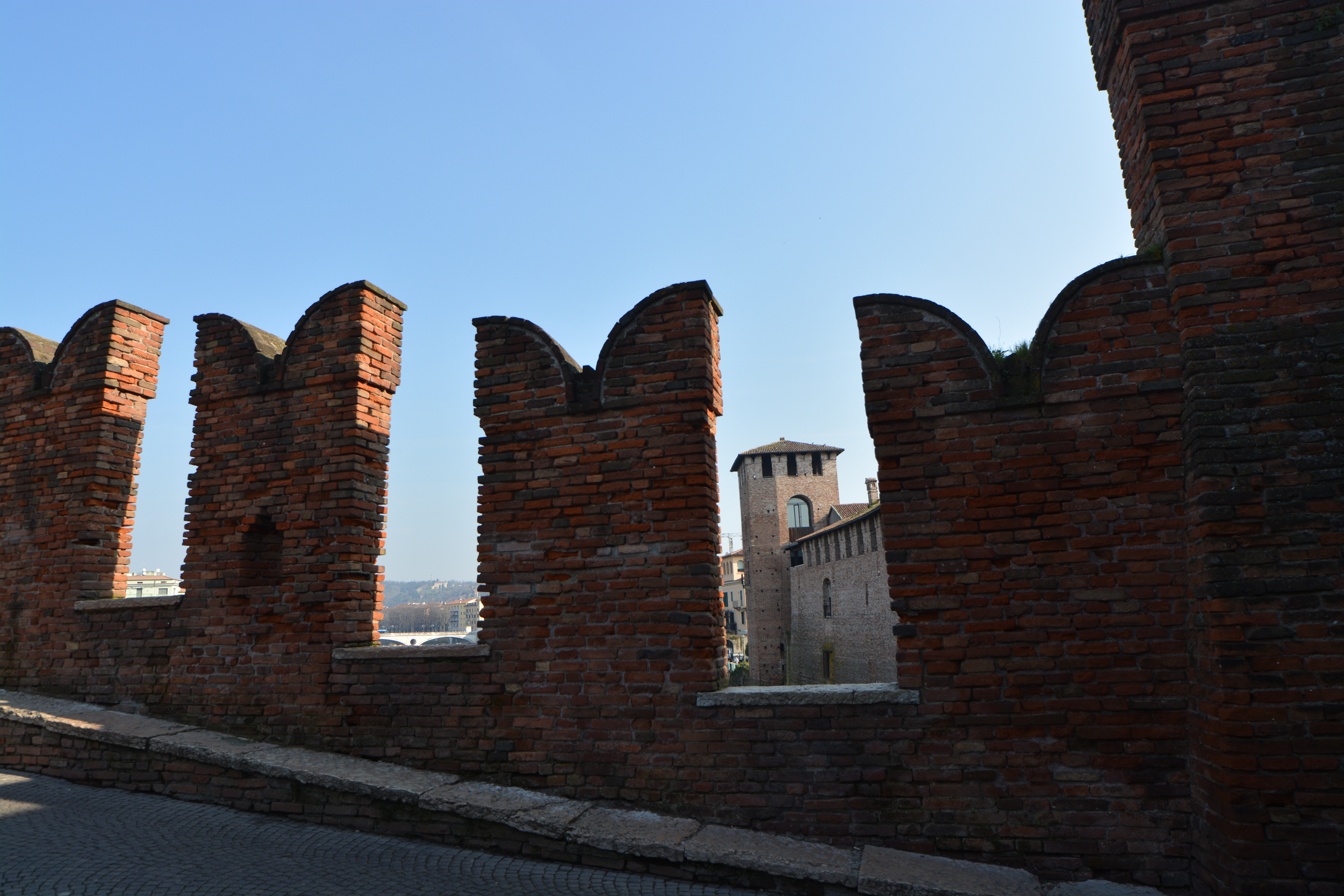
On the Scaliger Bridge
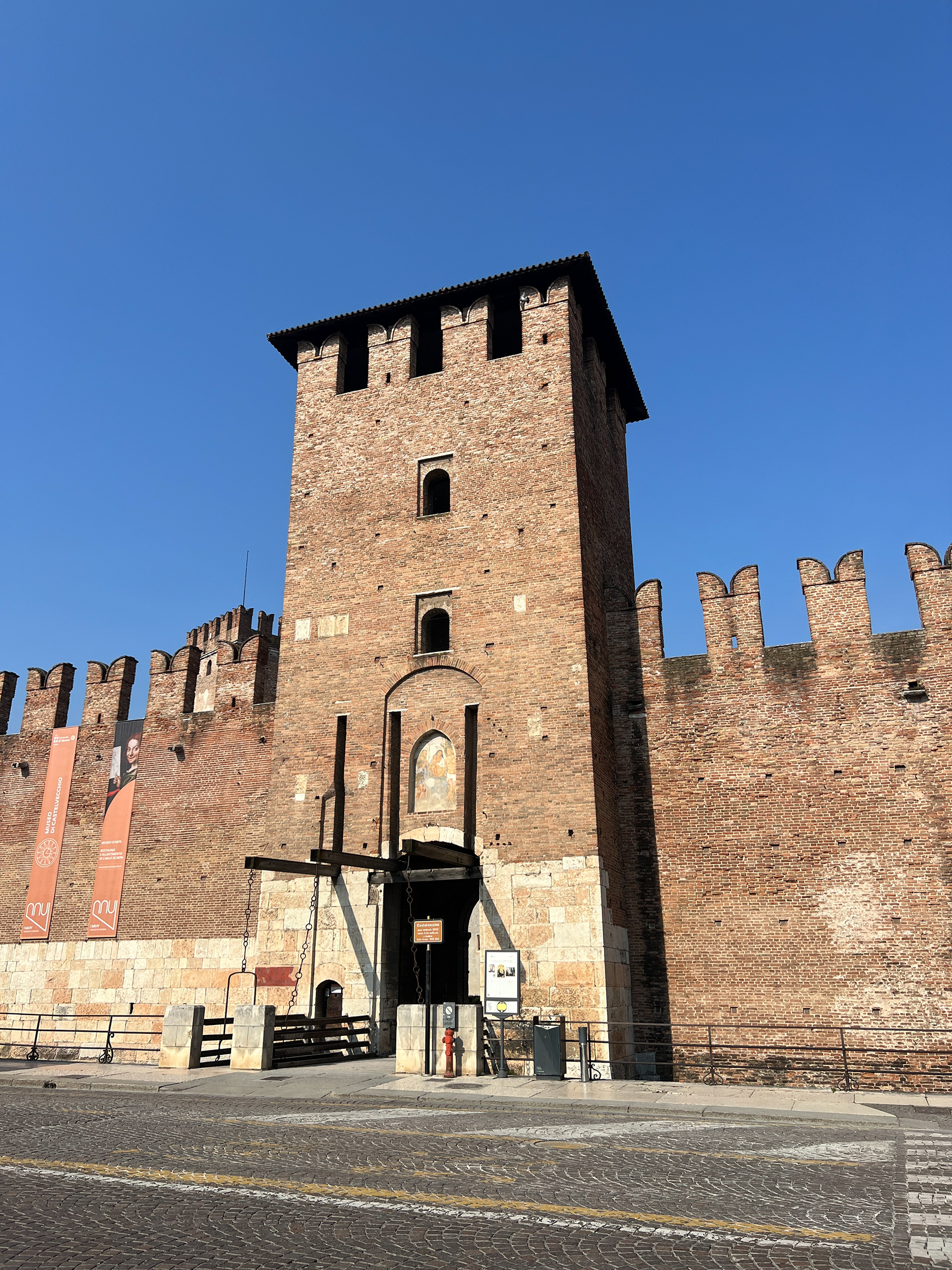
Castelvecchio

Emilie and Daniel with the Scaliger Bridge in the background
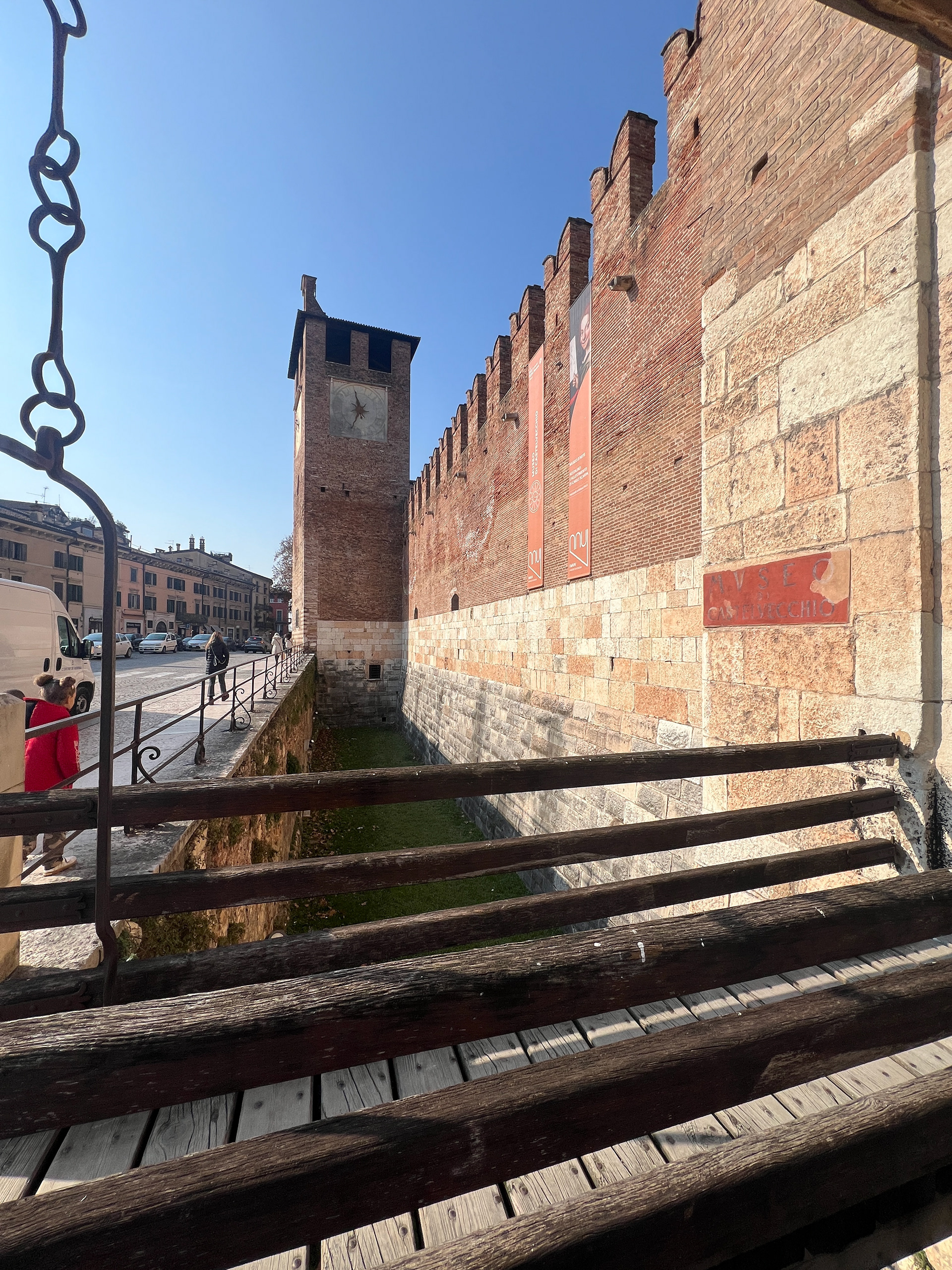
Walking into Castelvecchio
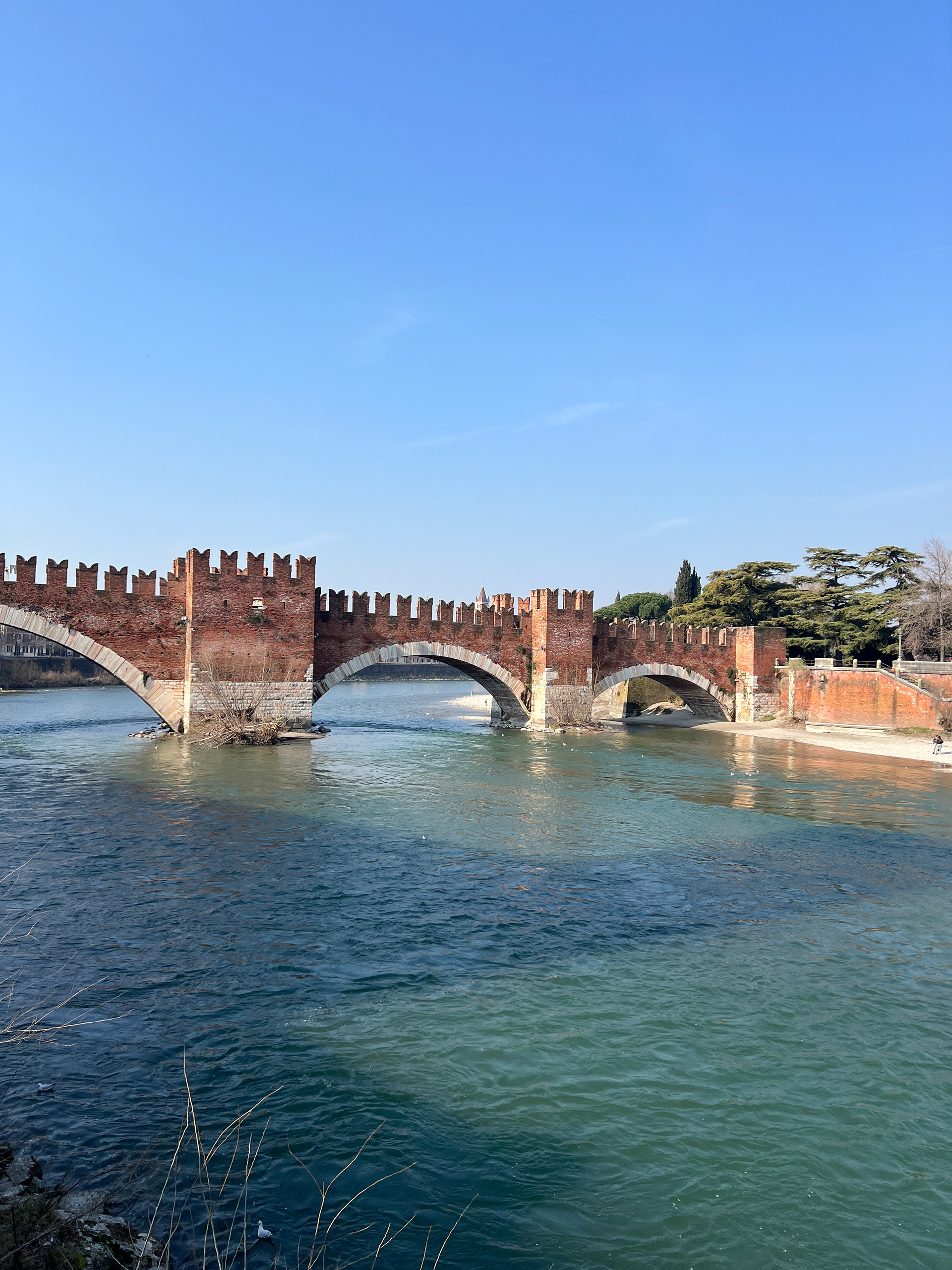
Scaliger Bridge

A view from Scaliger Bridge
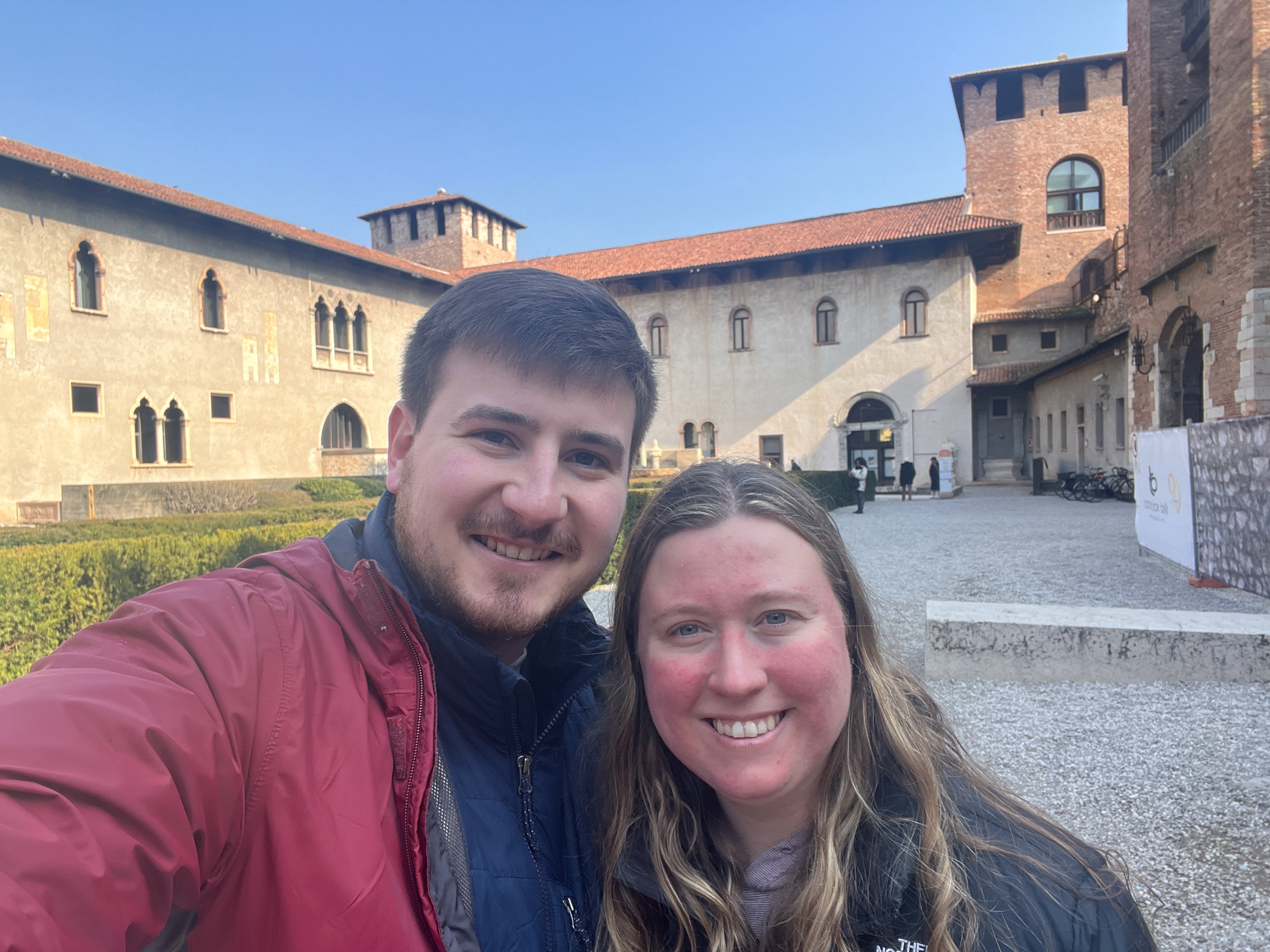
Daniel and Emilie in the courtyard of the Castelvecchio Museum
San Pietro
Visitors and locals can hike or take a funicular up to Castel San Pietro for a panoramic view of the city. In 1398, the fortress was first built on ruins of an earlier fortress built in the 9th or 10th century. The Castel San Pietro is another example of European history of something old destroyed and then rebuilt. In 1801, French soldiers destroyed spome parts, then in 1840, Austrians destroyed what was left.
The current castle was constructed in 1851. Apparently you can’t go inside anymore because the building was neglected, but it offers nice views outside and there is a bar at the top of the hill.
We took the funicular and met some other Americans who were touring spots for their upcoming wedding. We spent some time enjoying the views before heading down for dinner.
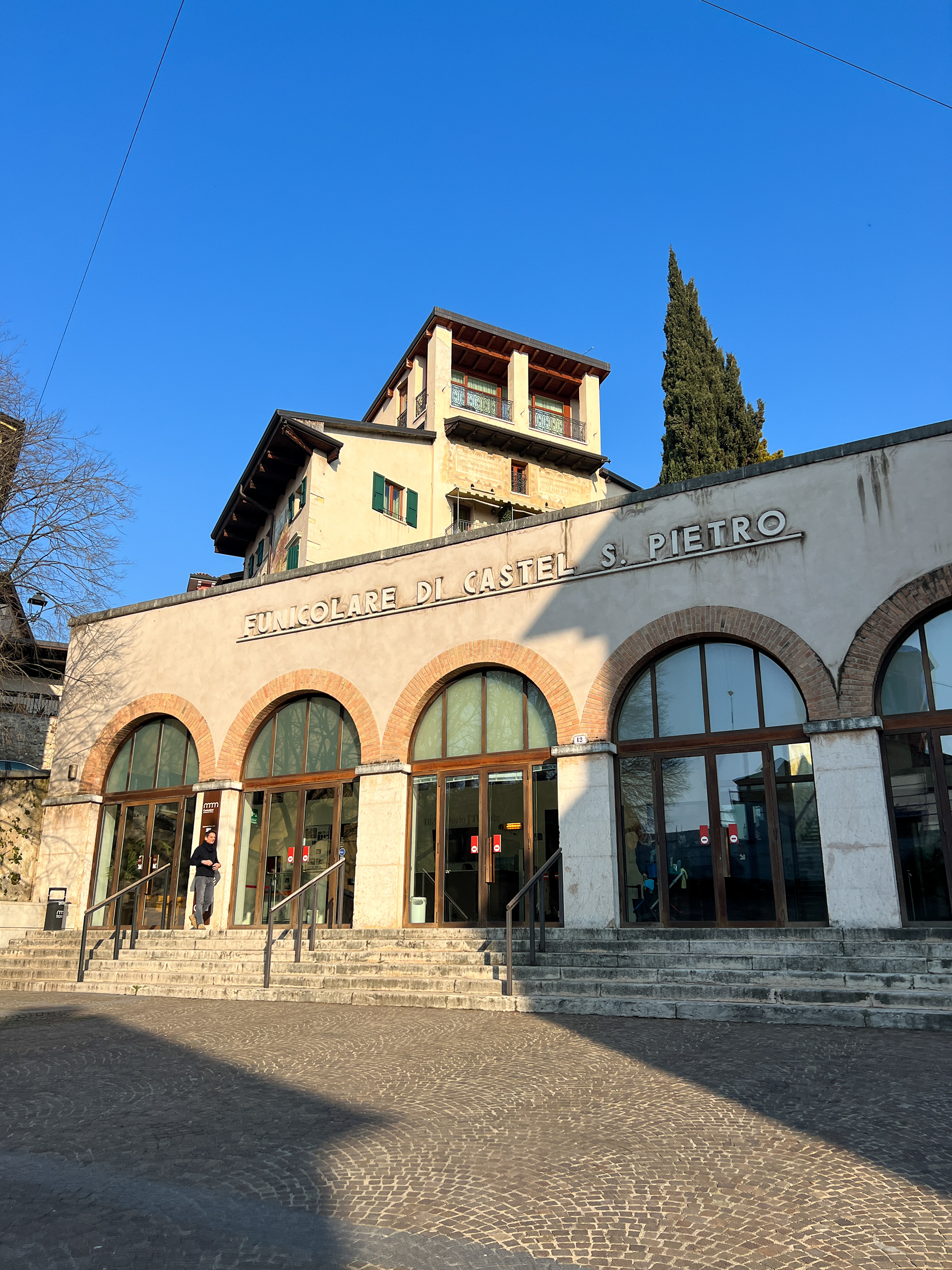
Funicular up to Castel San Pietro and viewpoint
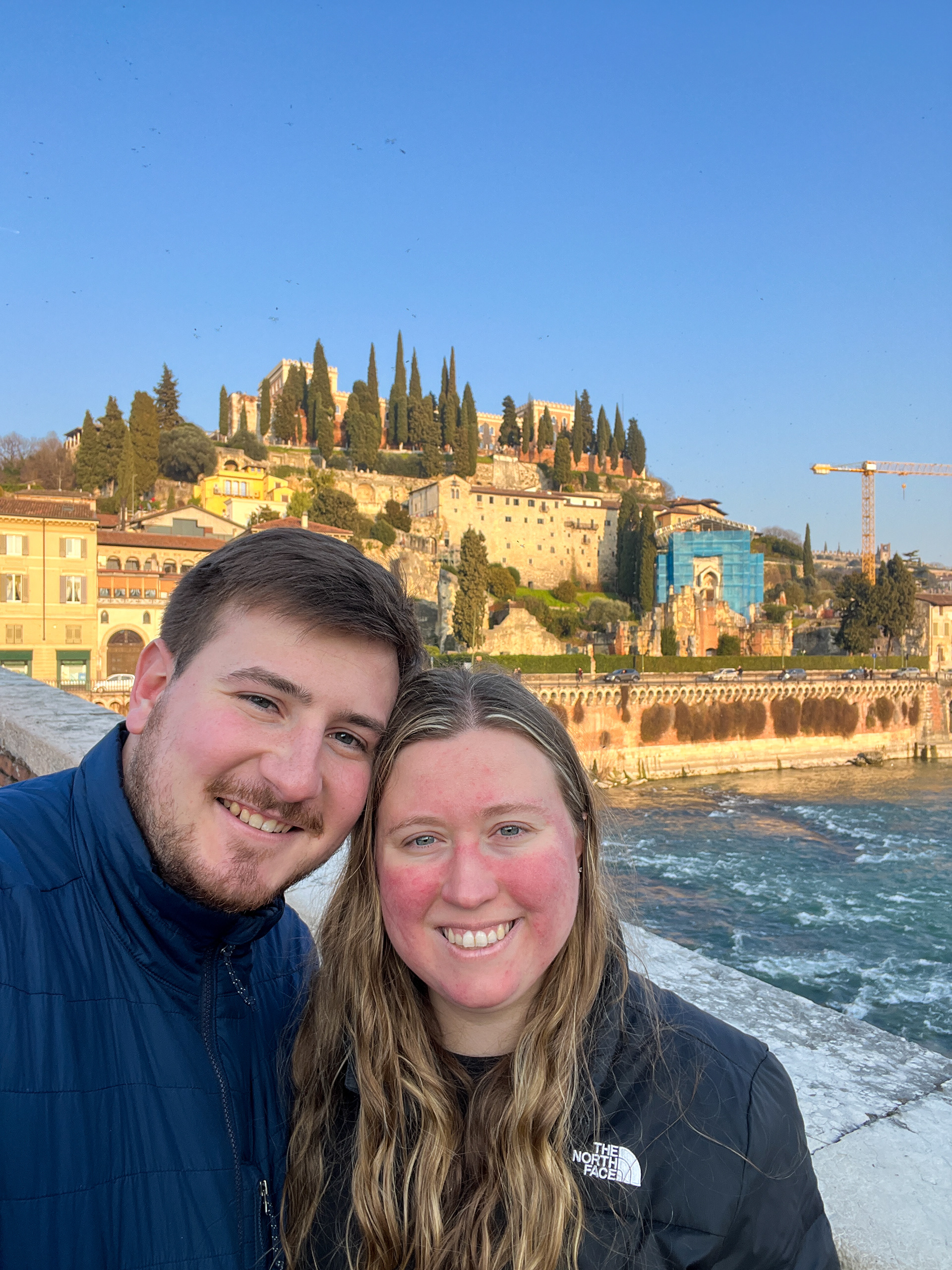
Daniel and Emilie with Castel San Pietro and the Adige river in the background
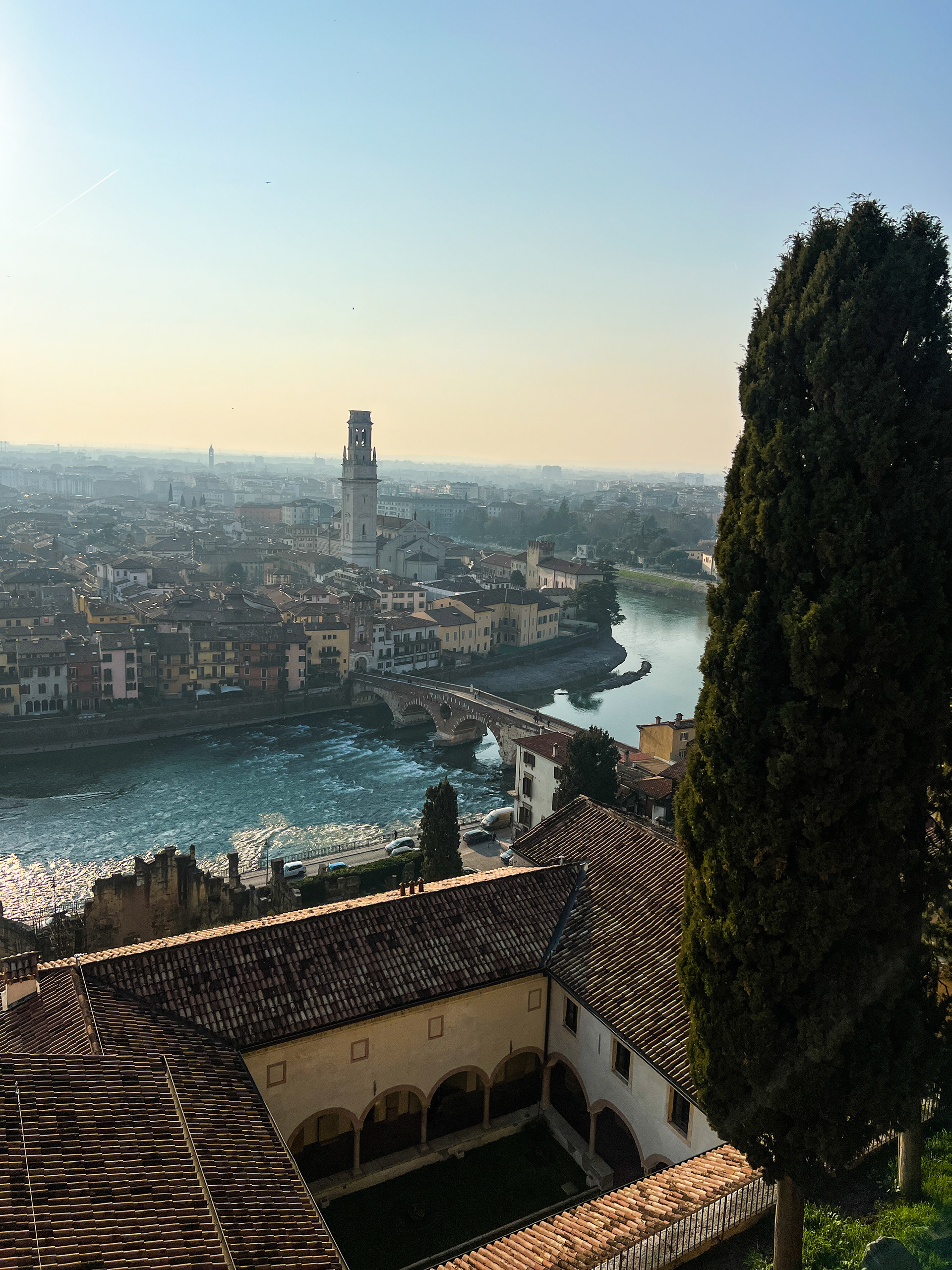
View from Castel San Pietro viewpoint

Daniel and Emilie with Verona in the background
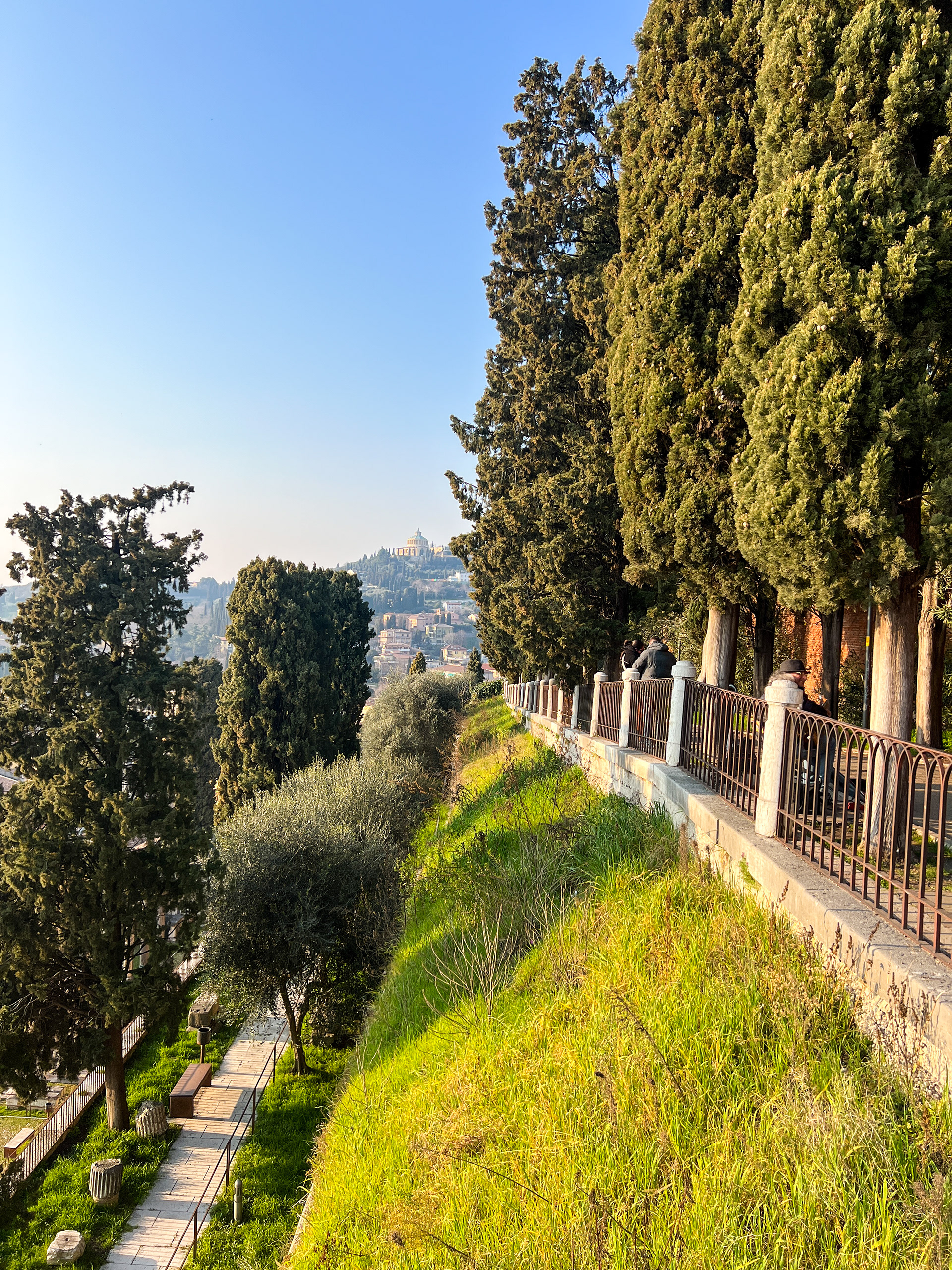
View from Castel San Pietro
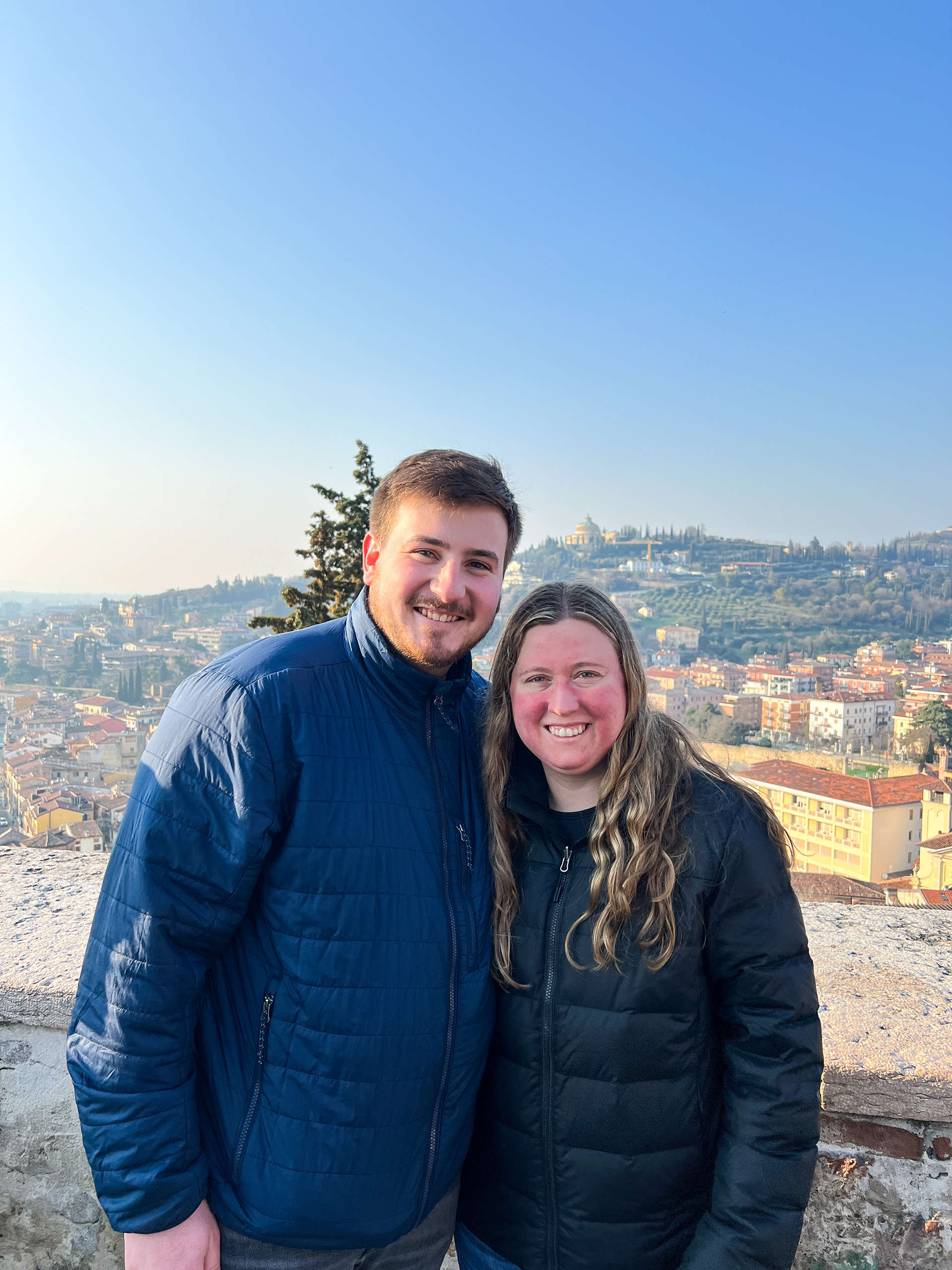
Daniel and Emilie with Verona in the background
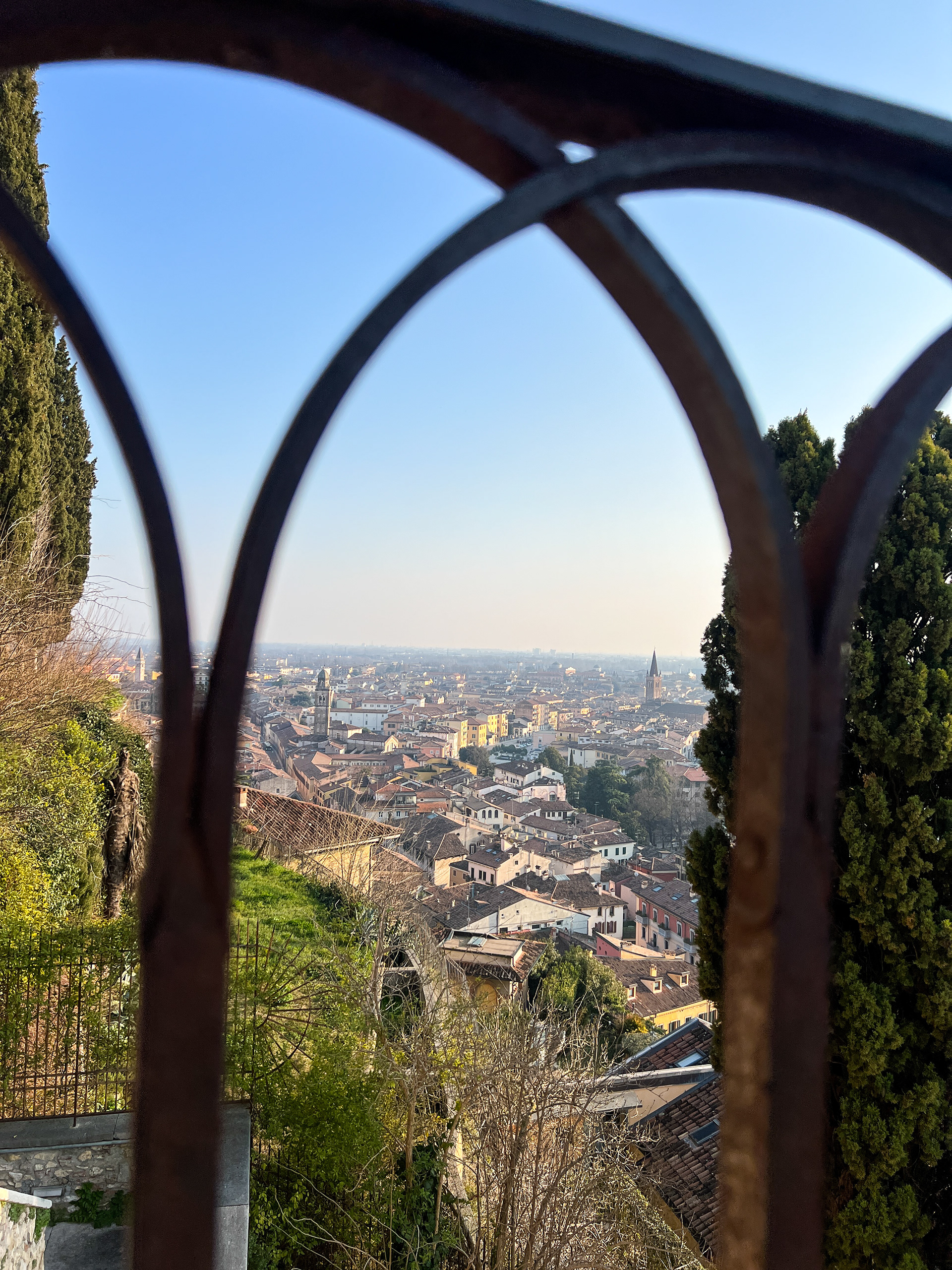
View of Verona

Daniel with Verona in the background

A duck with Castel San Pietro and the Adige river in the background
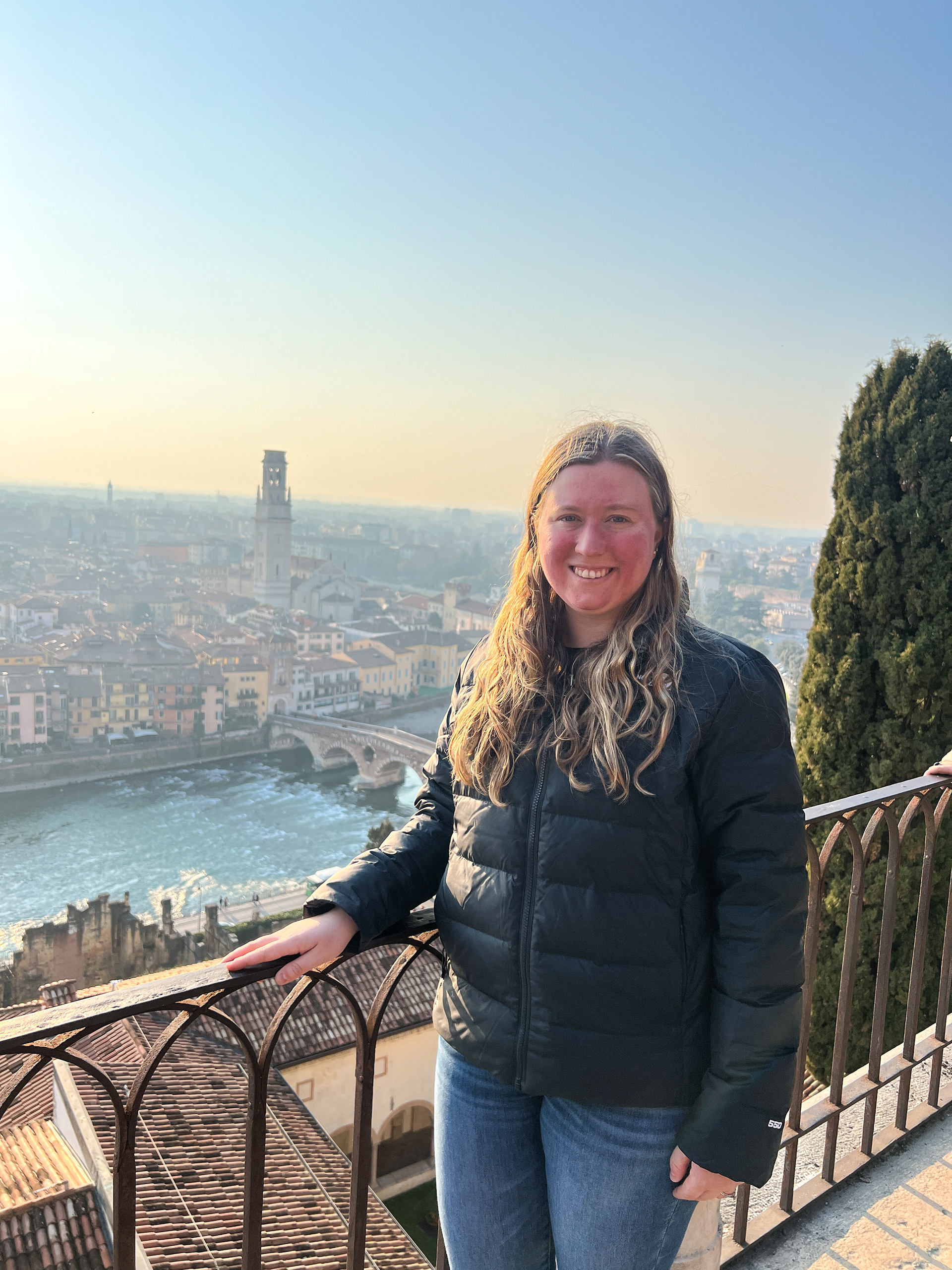
Emilie with Verona in the background
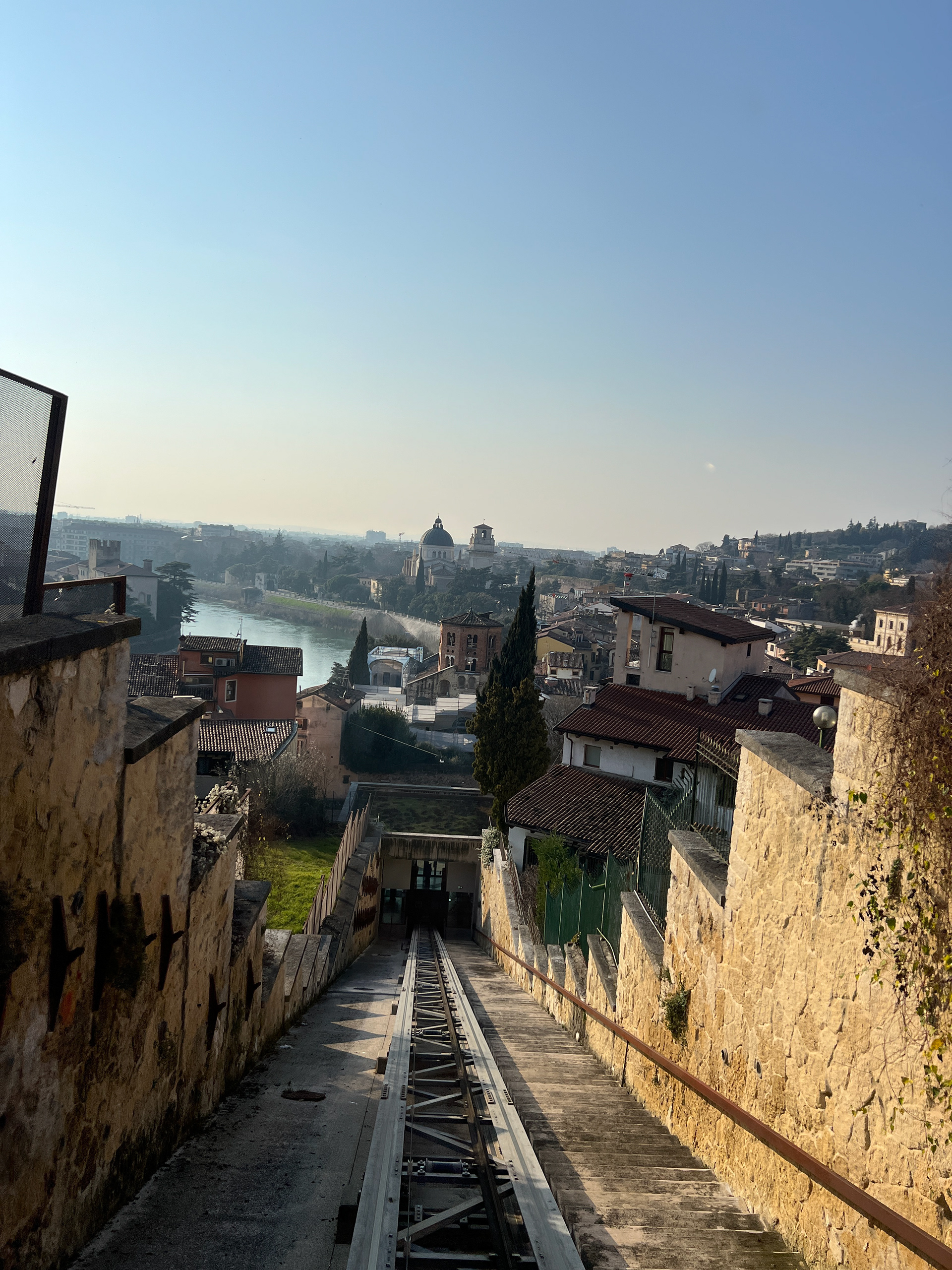
A view from the funicular
Basilica di San Zeno Maggiore
We took a self tour of four churches in Verona. The first was Basilica di San Zeno Maggiore, named after Saint Zeno of Verona, patron saint of the city. The church dates back to the 4th century, but the current basilica was constructed in the 9th century and rebuilt in the 12th century.
Zeno was the 8th bishop of Verona and lived in the 4th century, known well for his sermons and efforts to spread Christianity in the region. You can find the crypt of St. Zeno in the bottom floor containing his remains.
The most recent construction (from the 12 century) is Romanesque with a noteworthy bell tower that some consider the most beautiful in Italy.
On the inside of the basilica, one finds a small square grass area surrounded by walls filled with frescoes and round arches.
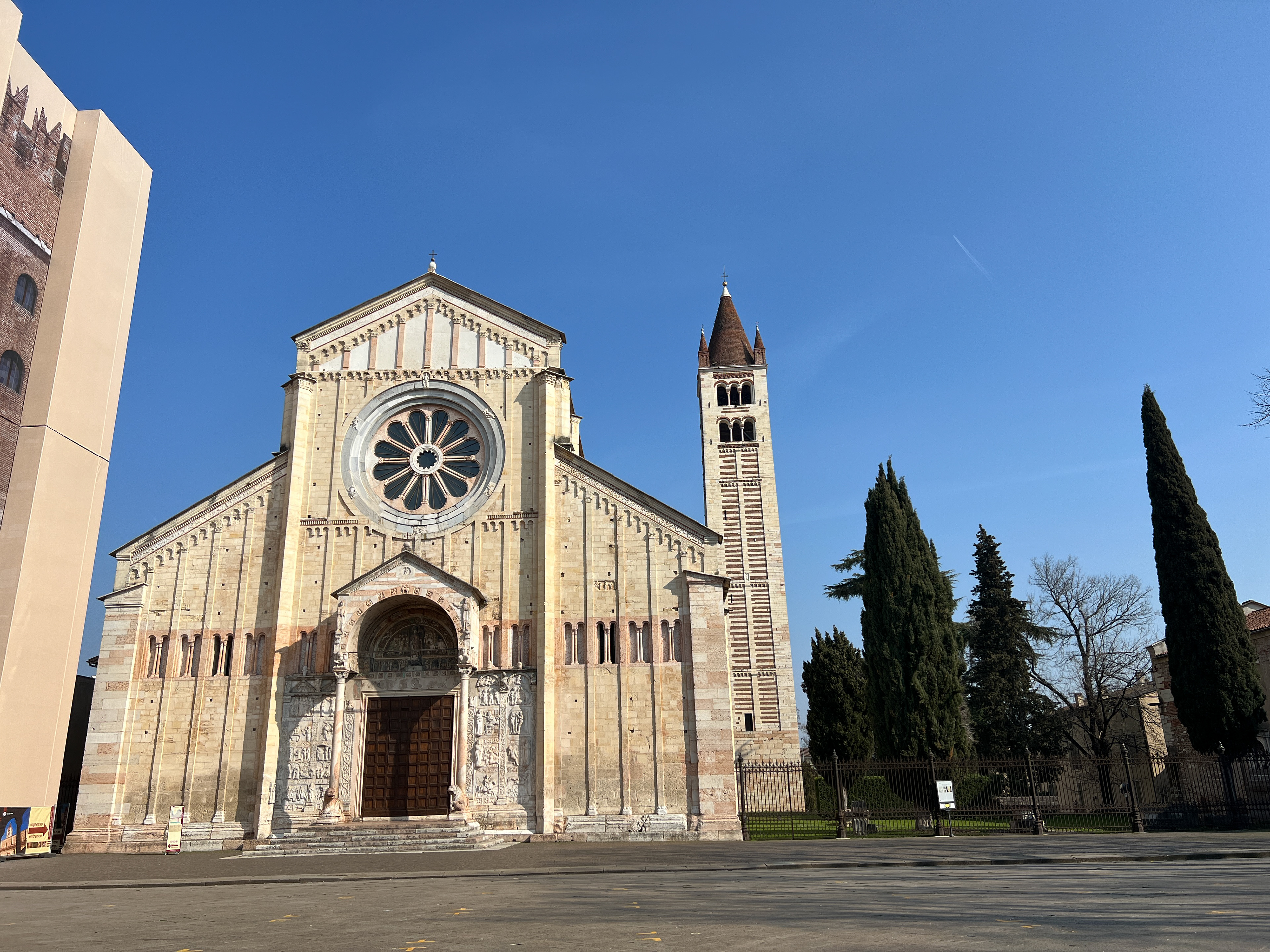
Basilica di San Zeno Maggiore
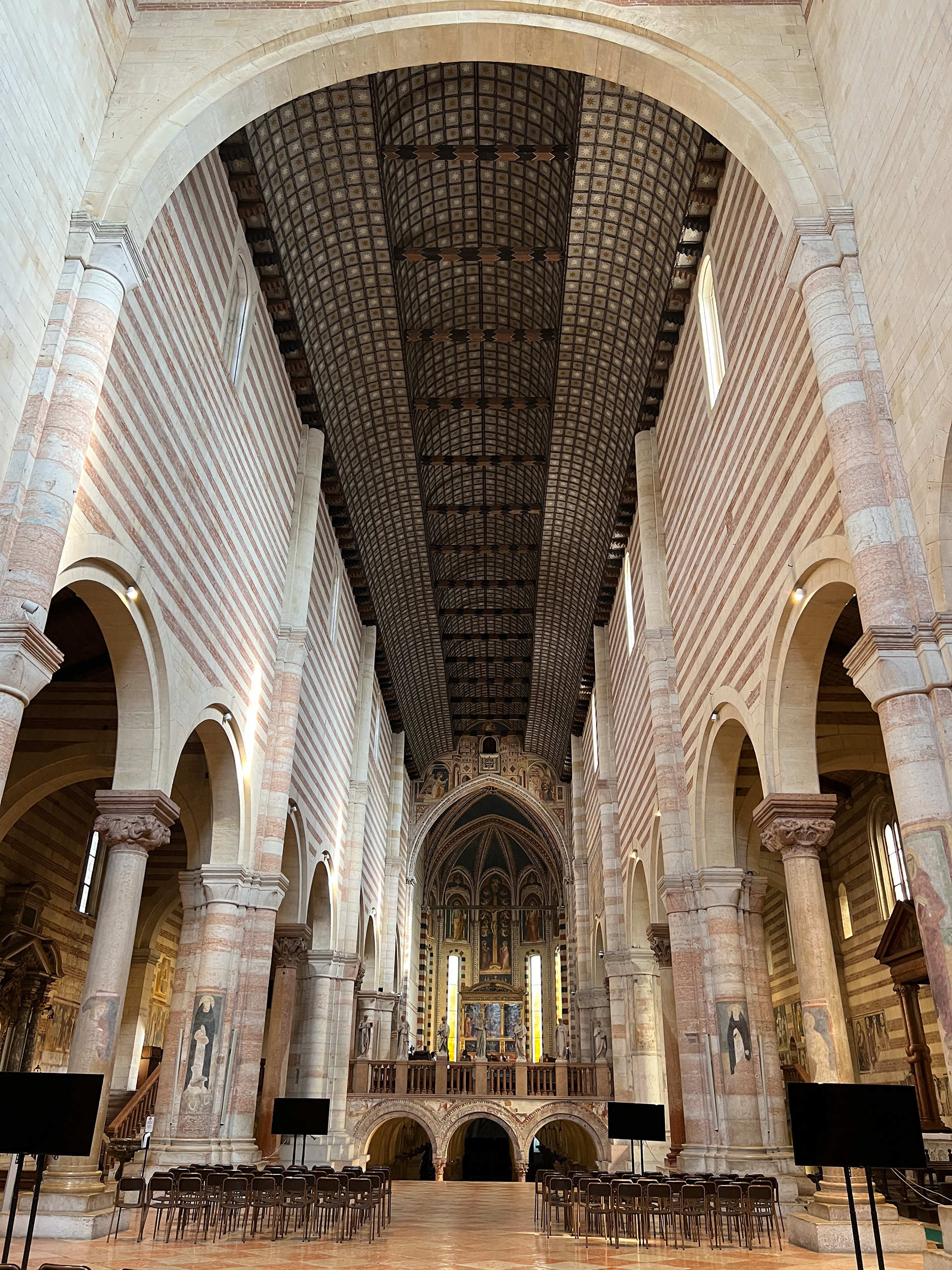
Inside of Basilica di San Zeno Maggiore
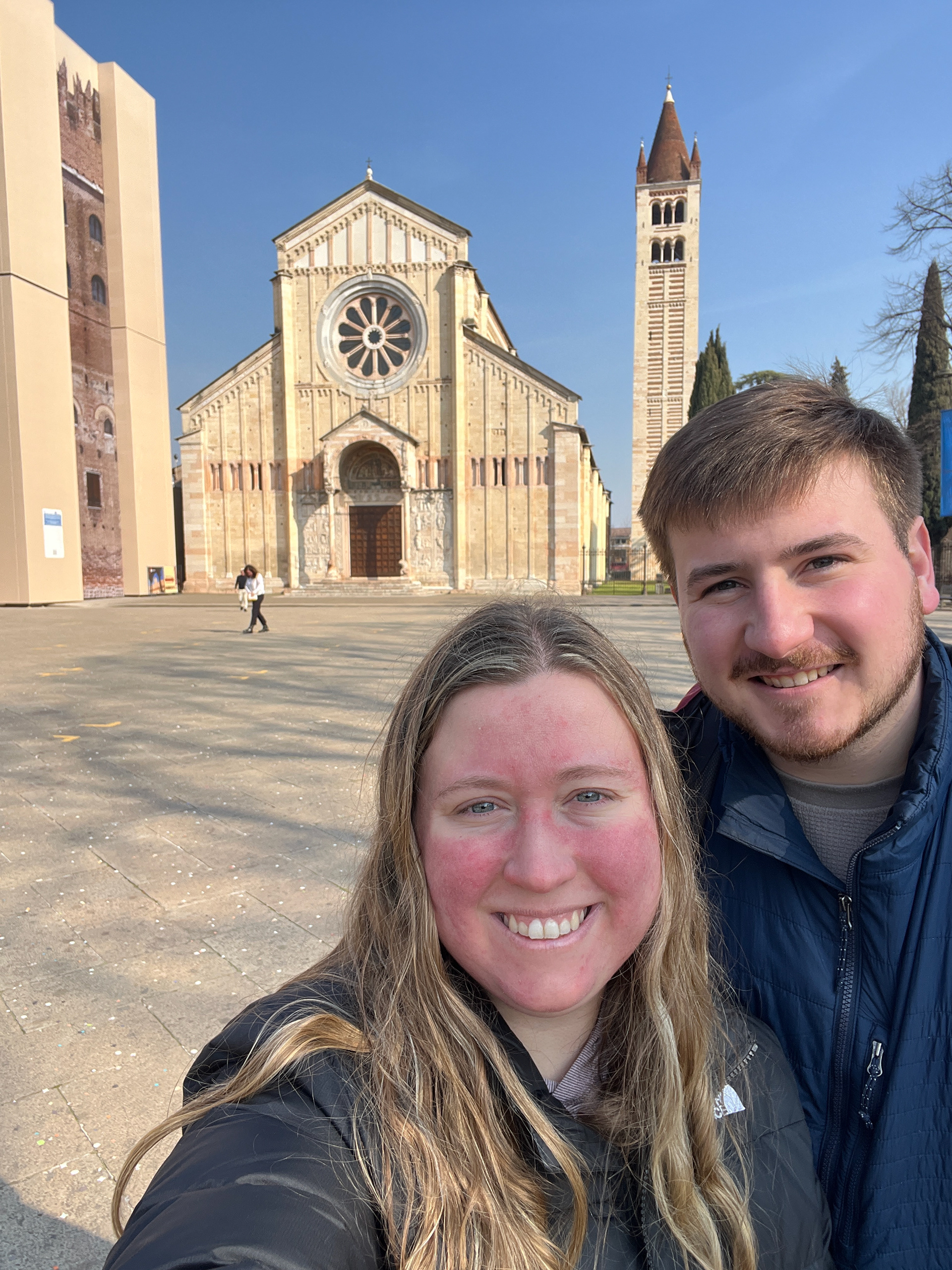
Emilie and Daniel with Basilica di San Zeno Maggiore

Courtyard of Basilica di San Zeno Maggiore
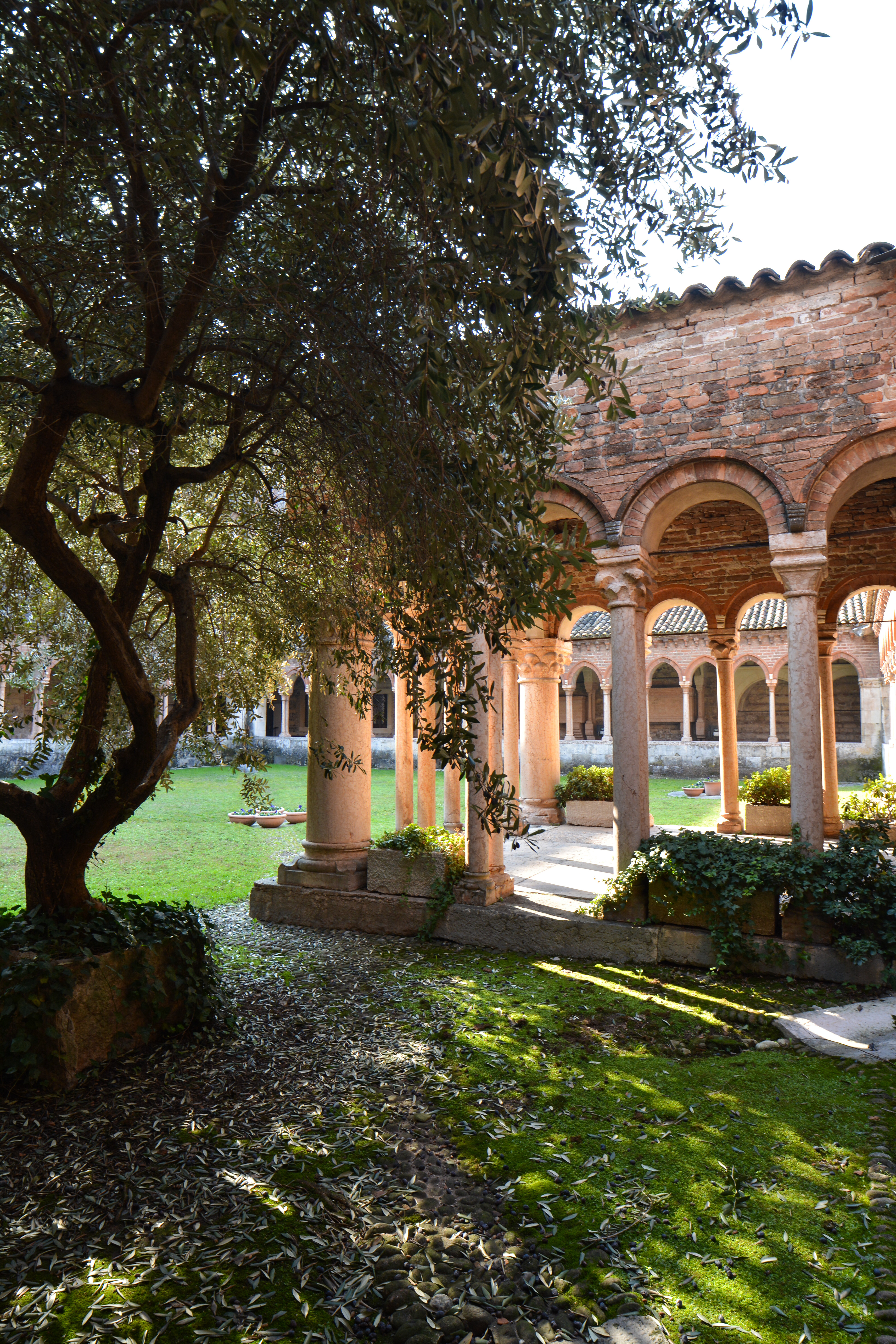
Courtyard of Basilica di San Zeno Maggiore

Crypt of Basilica di San Zeno Maggiore
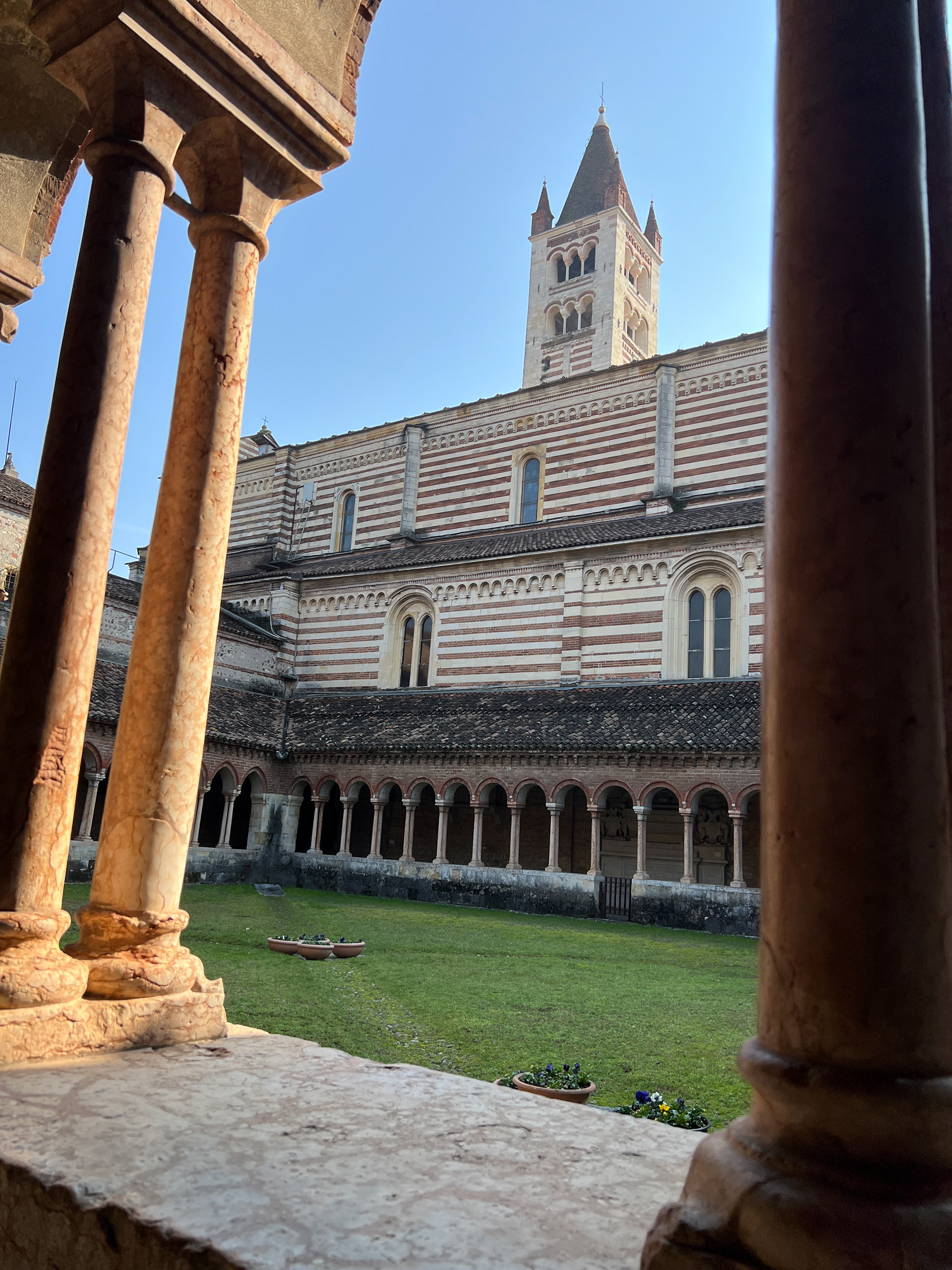
Courtyard of Basilica di San Zeno Maggiore

Art inside Basilica di San Zeno Maggiore
Cattedrale di Santa Maria Matricolare
The Cattedrale di Santa Maria Matricolare, also known as the Duomo of Verona, attracts thousands of visitors per year as it is considered one of the most sacred Catholic sites one can find.
The current church stands on the site of two Palaeo-Christian churches which were destroyed by an earthquake in the 12th century. The current cattedrale was consecrated in 1187. Like many of these churches, it is filled with various art pieces all throughout.

Cattedrale di Santa Maria Matricolare
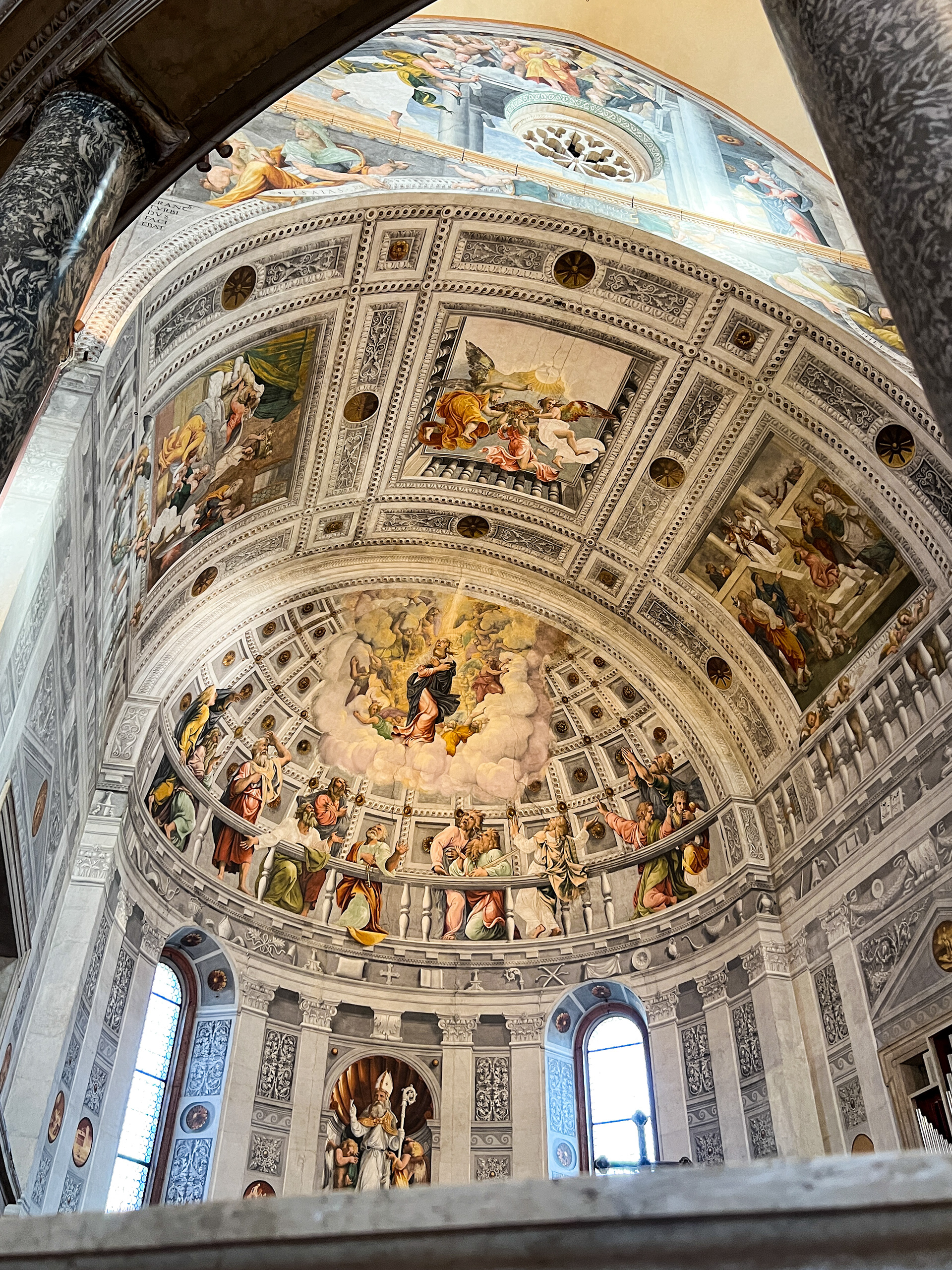
Painting inside Cattedrale di Santa Maria Matricolare
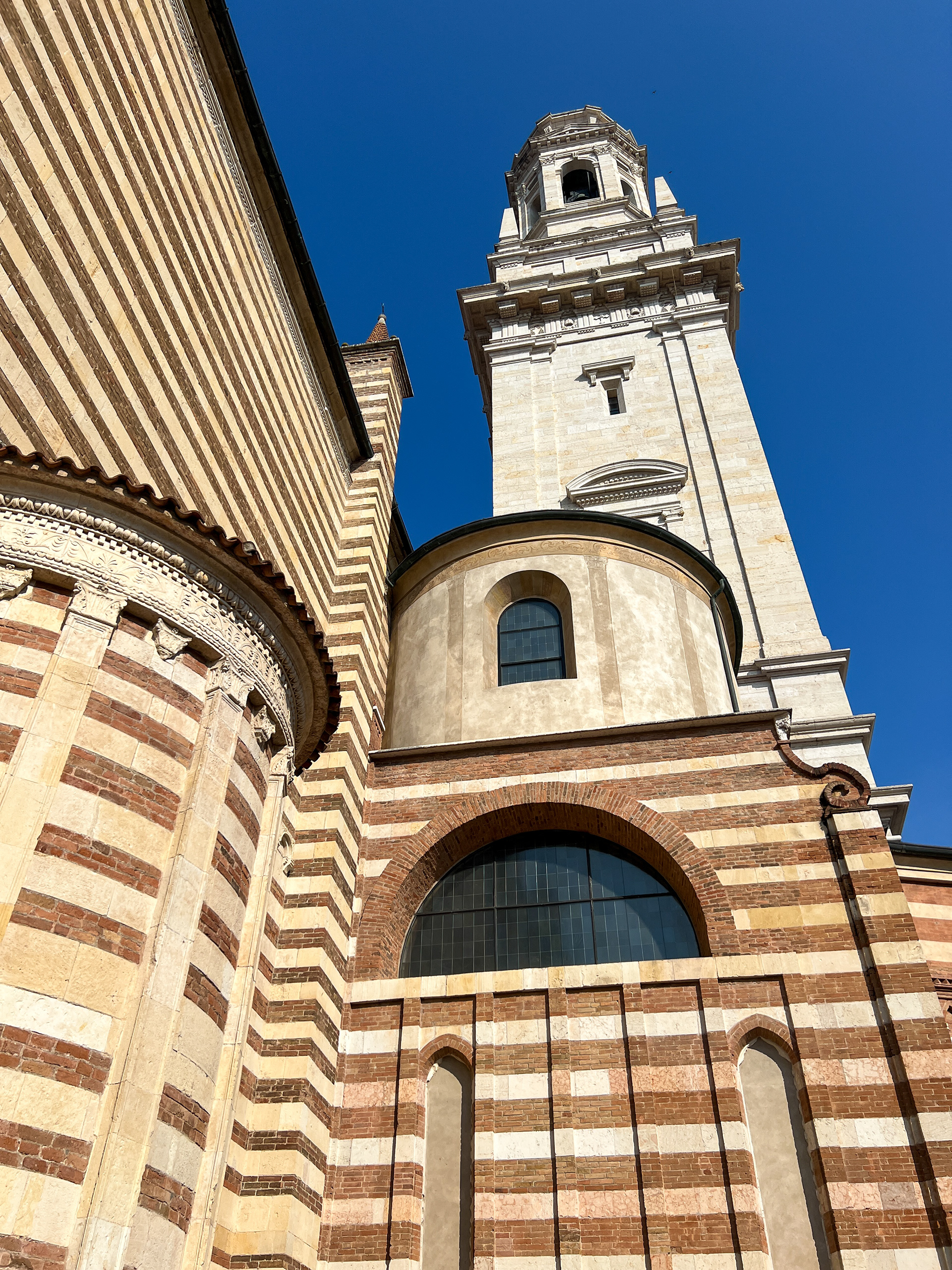
Cattedrale di Santa Maria Matricolare

Inside Cattedrale di Santa Maria Matricolare

Baptismal font inside Cattedrale di Santa Maria Matricolare
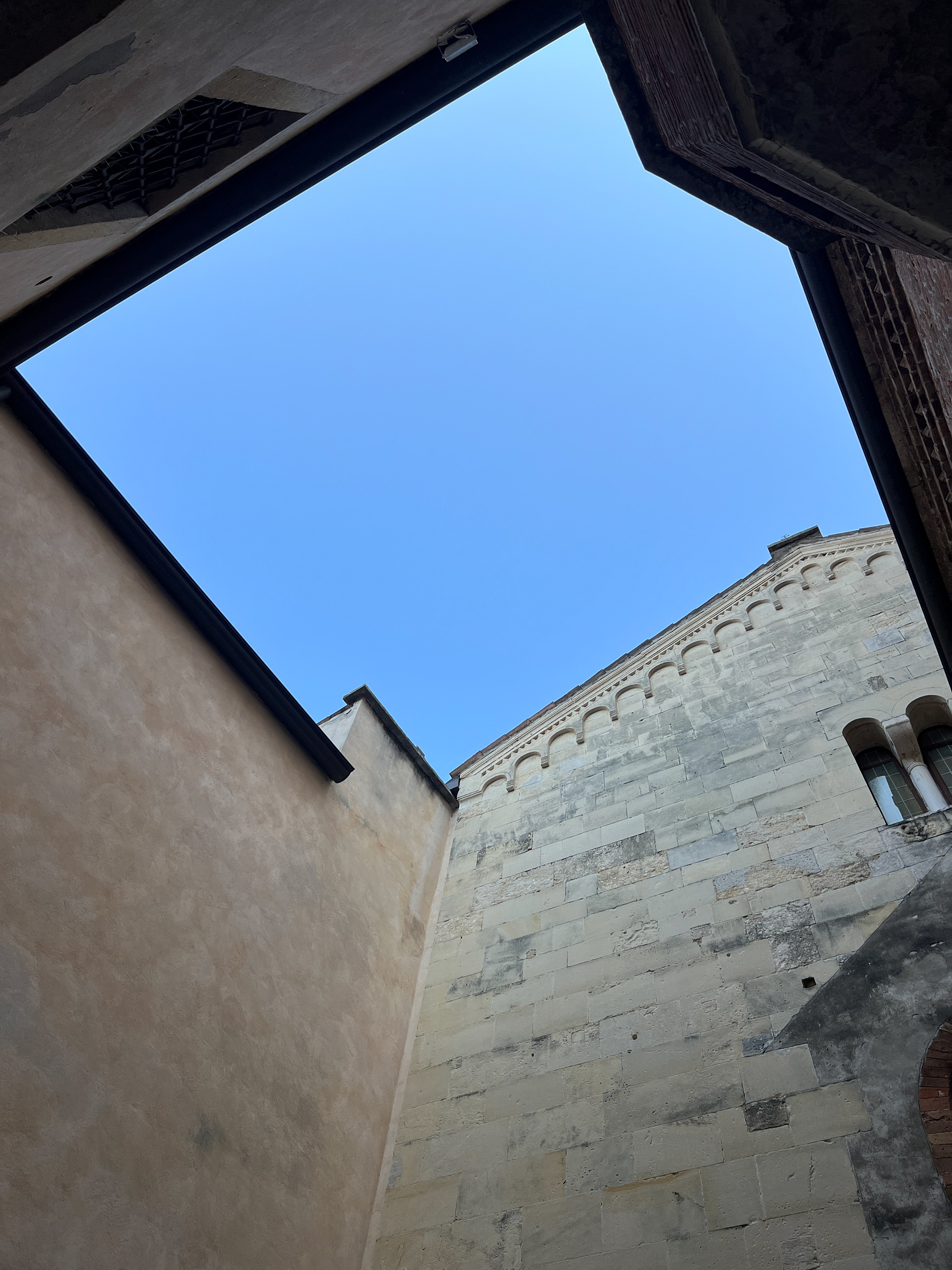
Inside Cattedrale di Santa Maria Matricolare
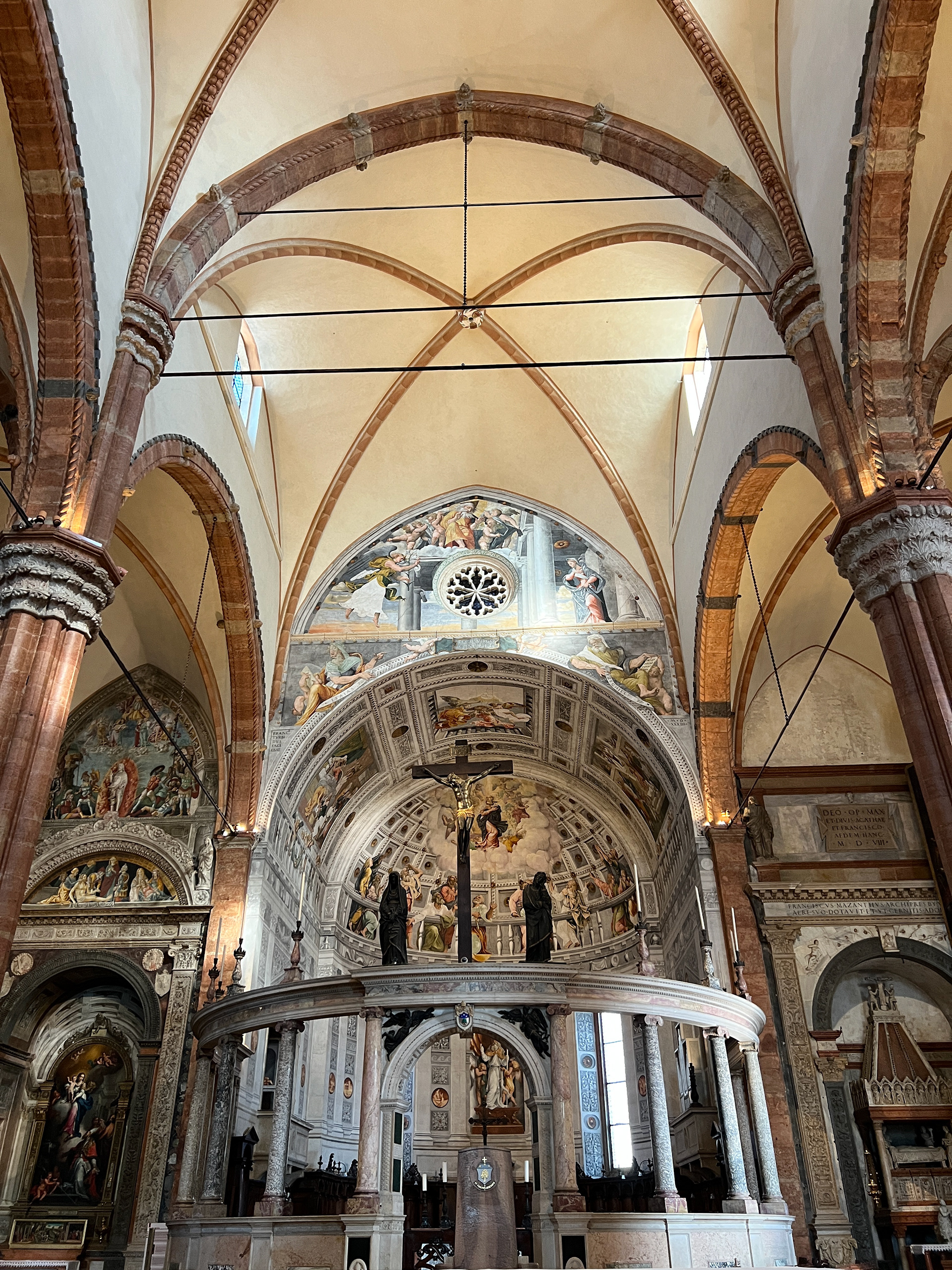
Inside Cattedrale di Santa Maria Matricolare
Basilica di Santa Anastasia
The largest of all Verona churches, Basilica di Santa Anastasia was paid for by the Della Scala family and others, beginning in 1290. The architecture follows the Italian Gothic style and was Daniel’s favorite church we visited for its size, style, and art.
When we visited, an organist was practicing something, playing the same part of what we guessed was a hymn for maybe an upcoming service. The music added a nice vibe to the environment.

Basilica di Santa Anastasia
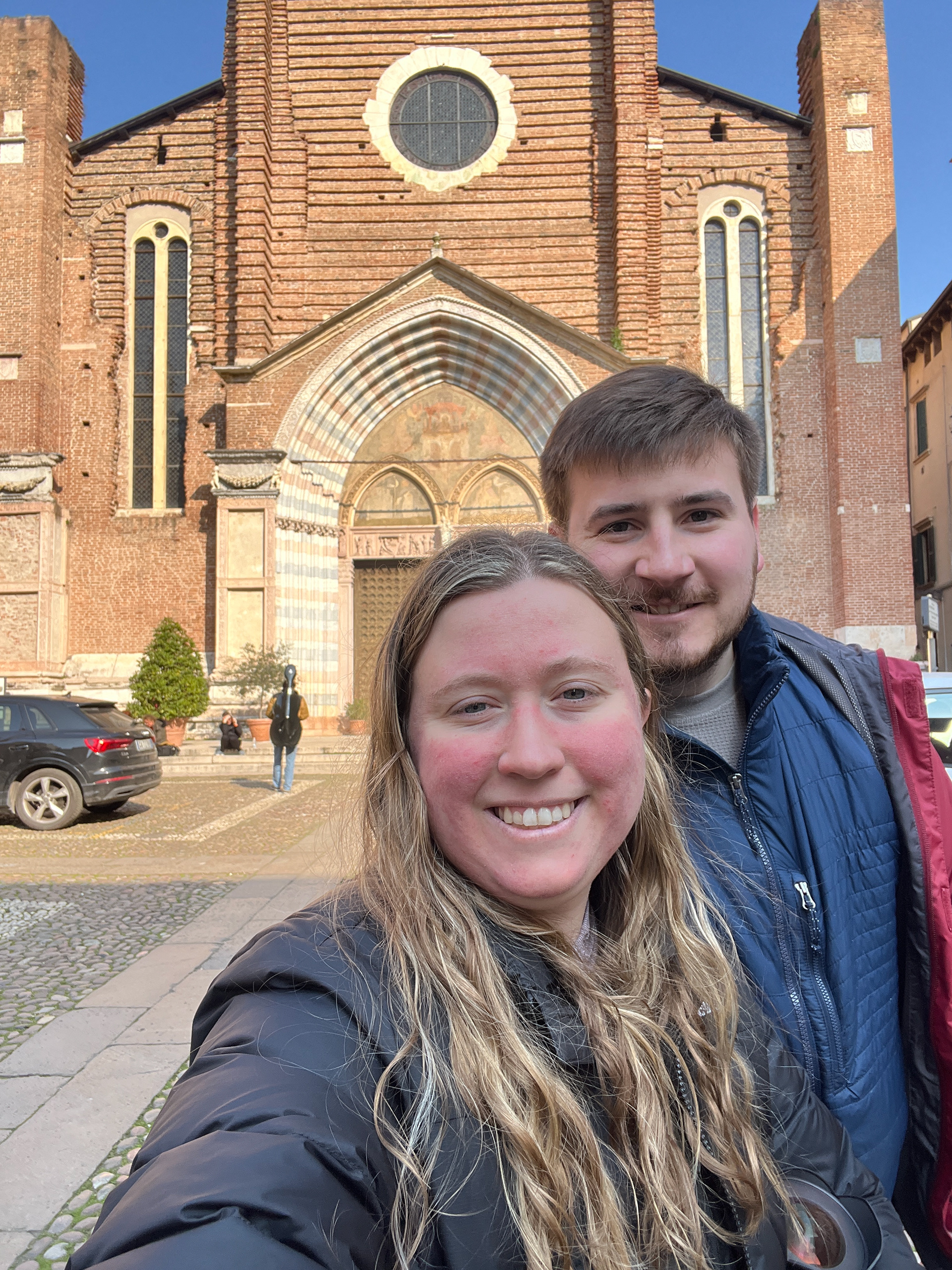
Emilie and Daniel in front of Basilica di Santa Anastasia
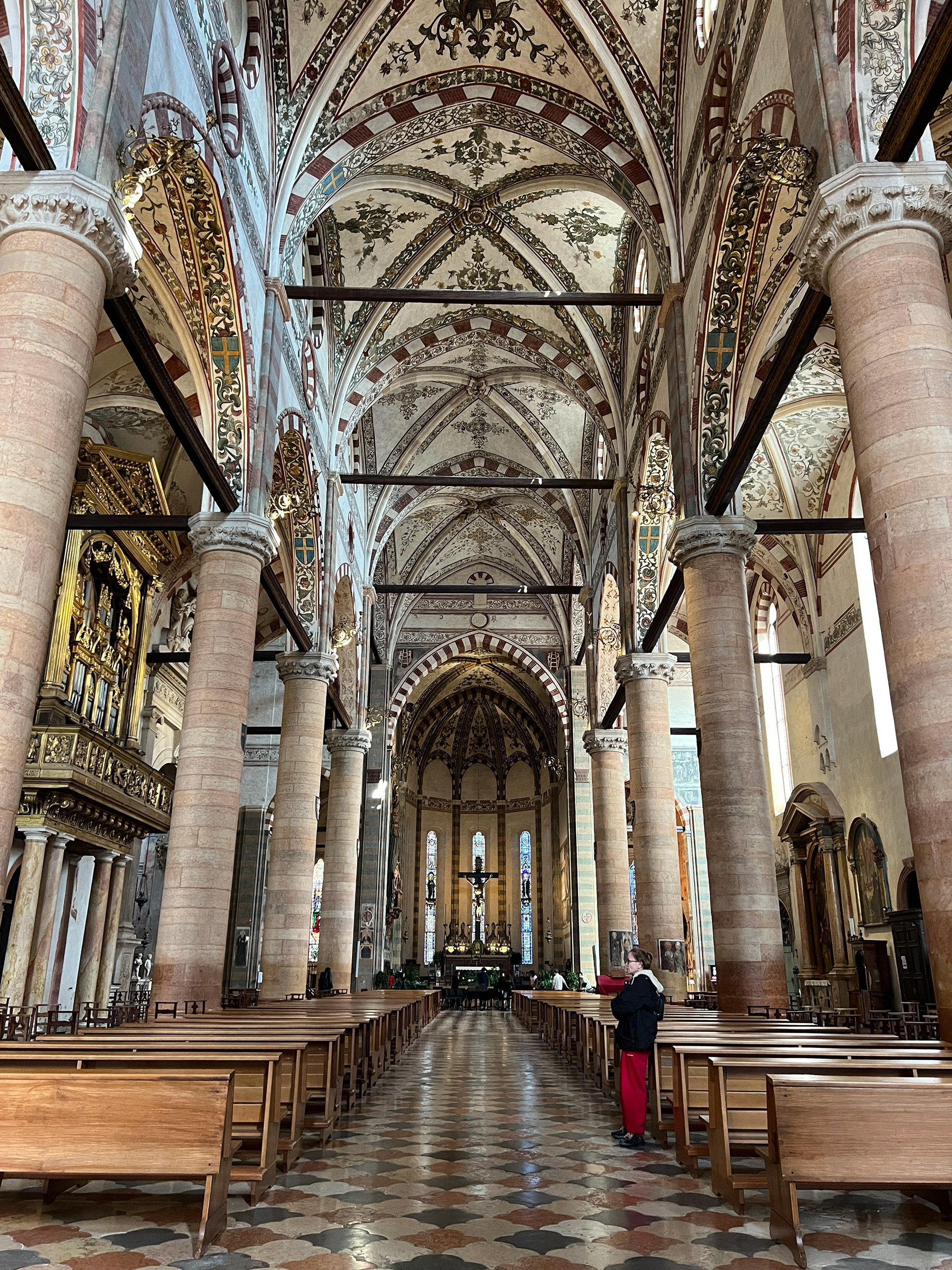
Inside Basilica di Santa Anastasia
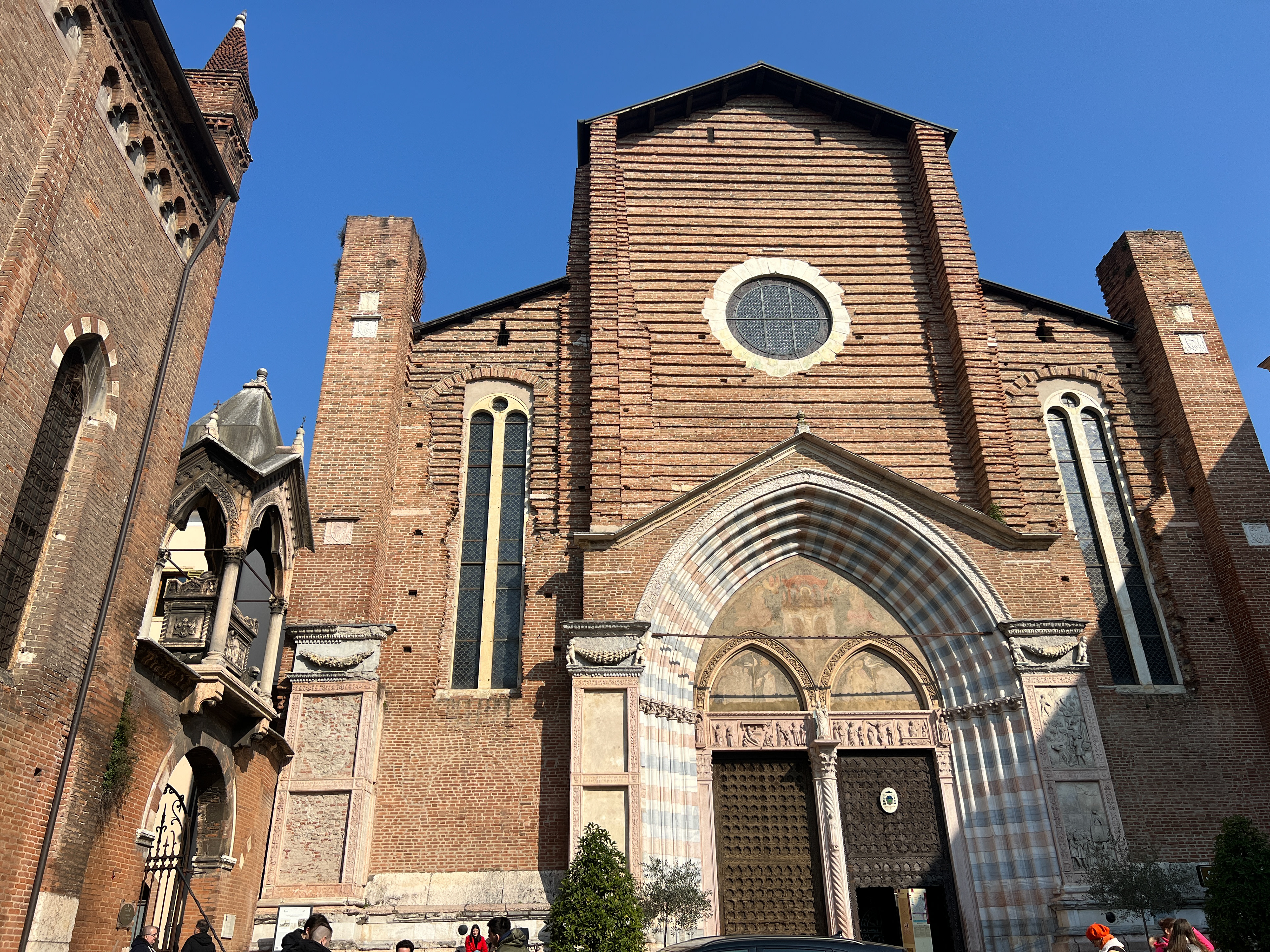
Basilica di Santa Anastasia

Basilica di Santa Anastasia

The ceiling of Basilica di Santa Anastasia
Chiesa di San Fermo Maggiore
Our last church we visited was San Fermo Maggiore, a Romanesque and Gothic church in the center of Verona. It was dedicated to local martyrs, brothers and saints Firmus and Rusticus from the 3rd century.
The church can be traced to the 8th century, with additions added by the Benedictine order in the 11th century.
Florentine sculptor Nanni di Bartolo, also known as il Rosso (the redhead), sculpted a wall monument including The Resurrection, which showcases Christ, four sleeping soldiers, three angels, and two putti (the little babies with wings; think of cupid, I think…) who hold back large canopy curtains.
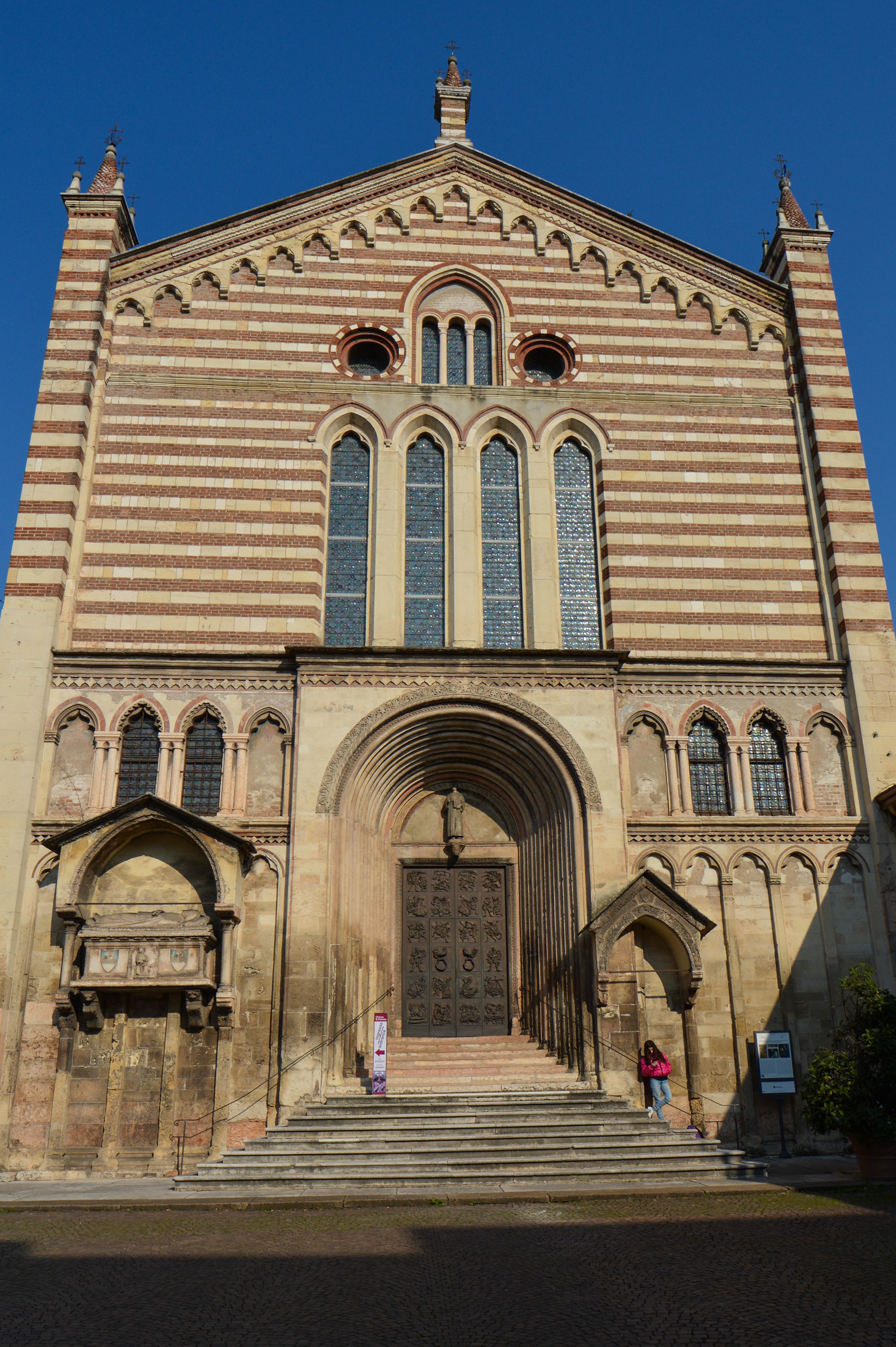
Chiesa di San Fermo Maggiore
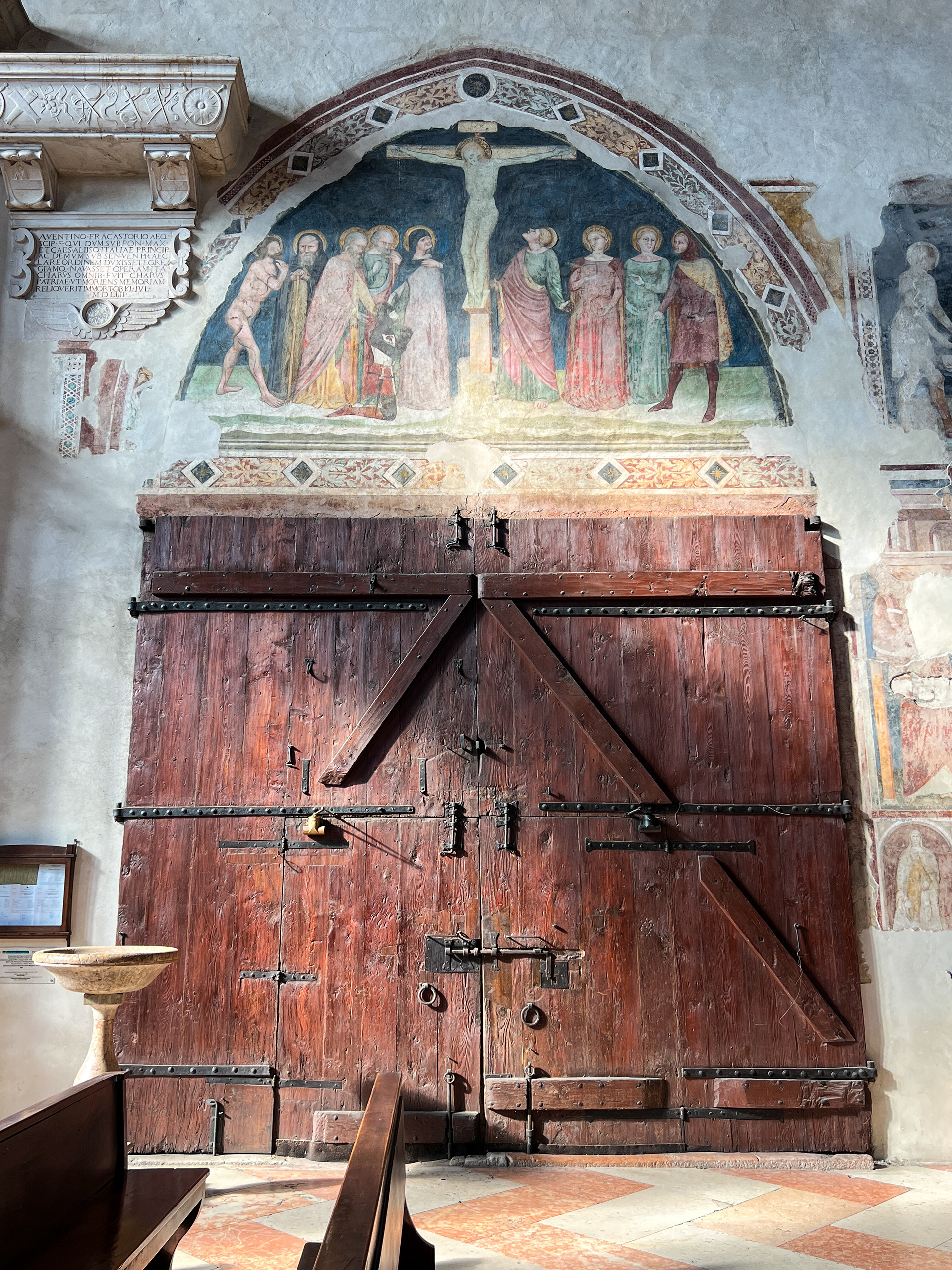
Art inside Chiesa di San Fermo Maggiore
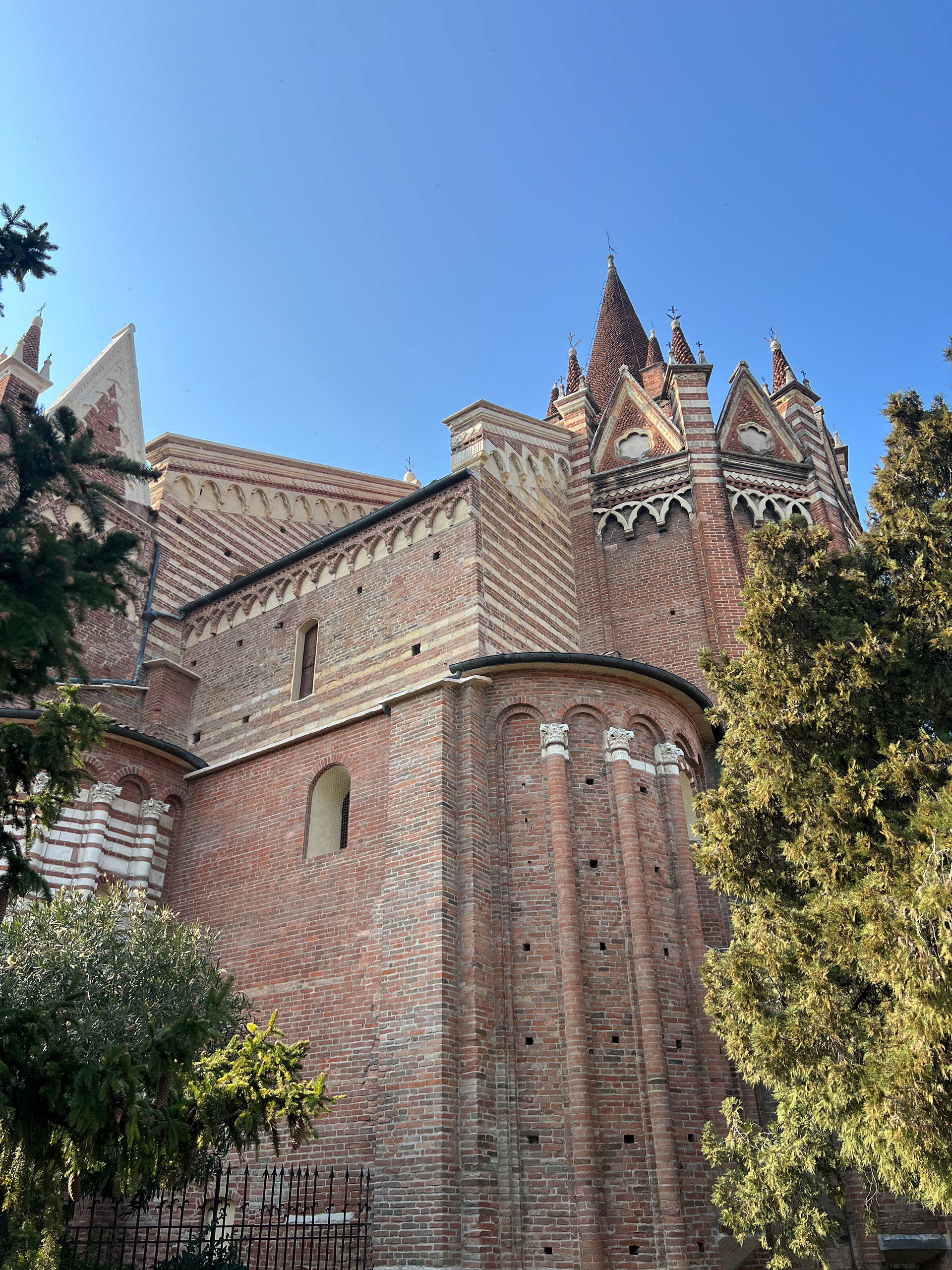
Chiesa di San Fermo Maggiore
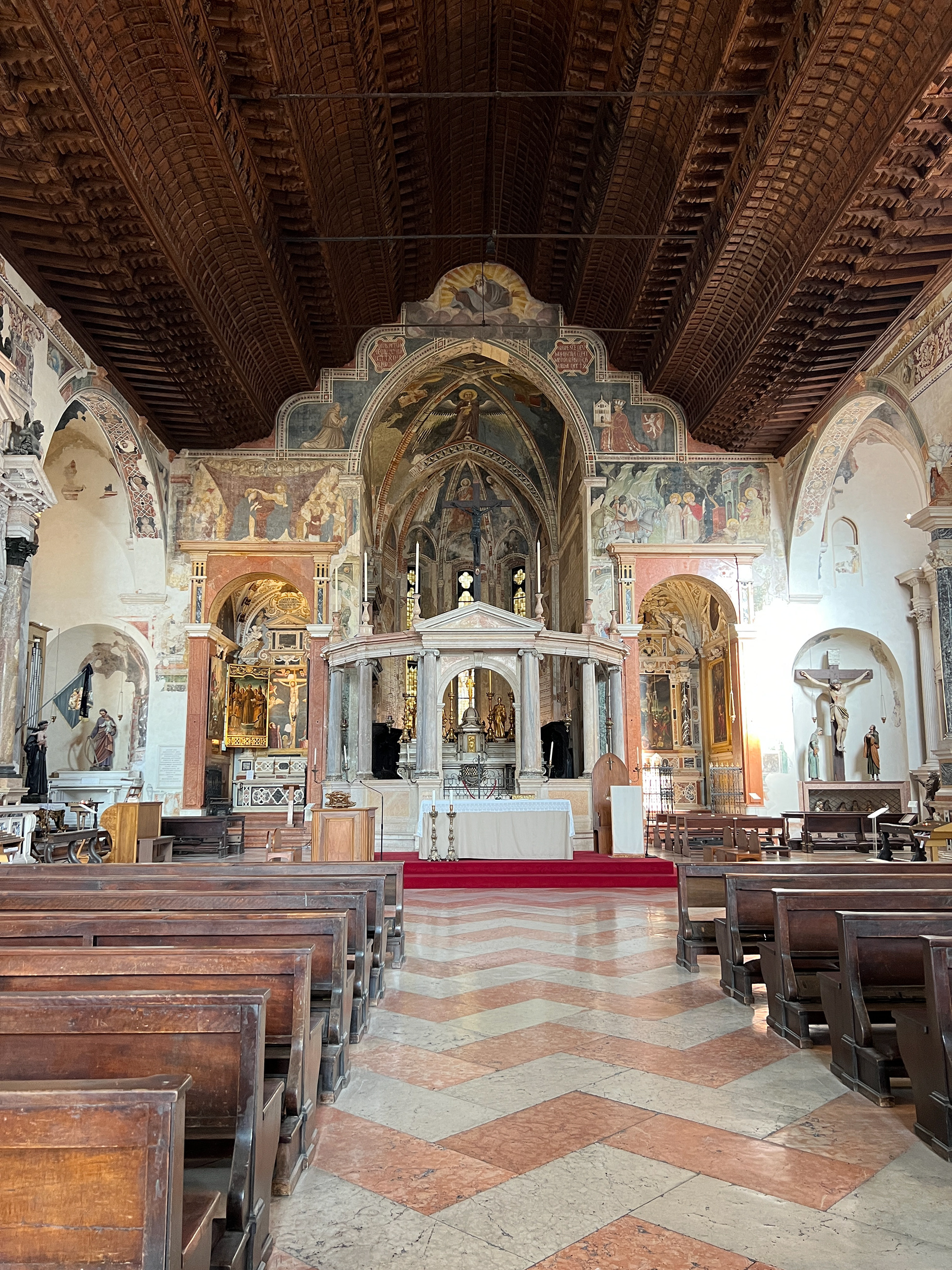
Inside Chiesa di San Fermo Maggiore
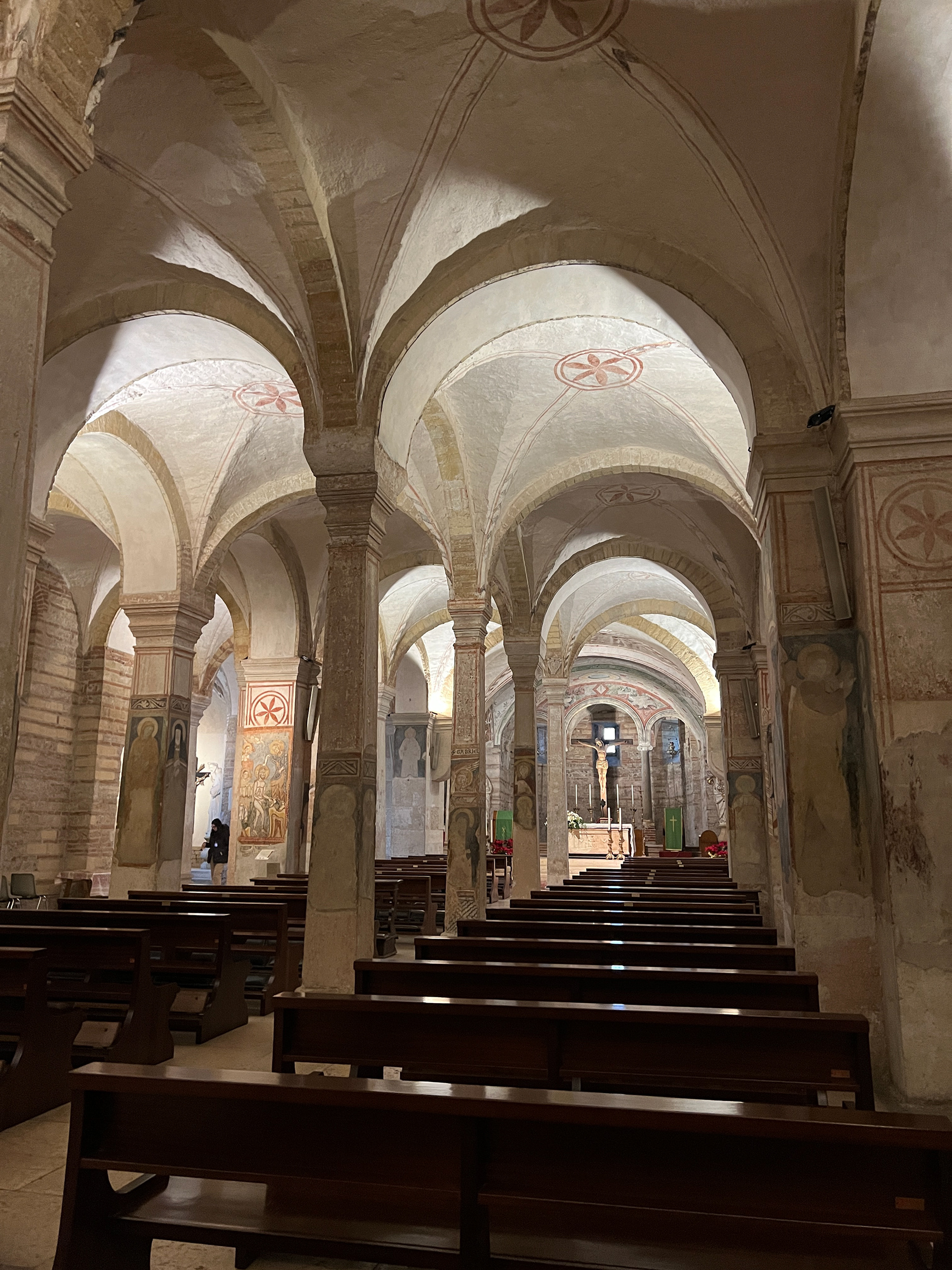
Lower Church in Chiesa di San Fermo Maggiore
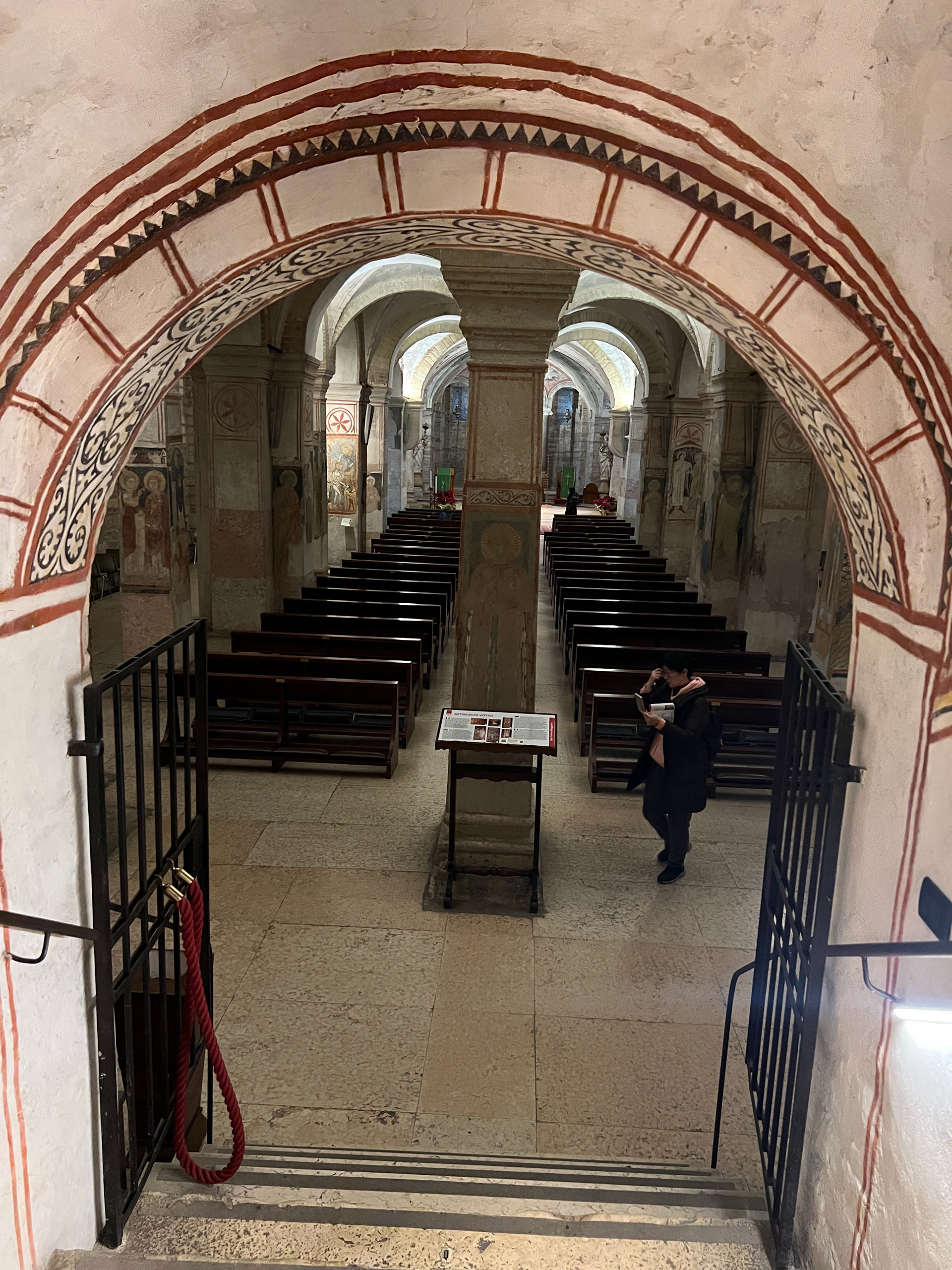
Lower Church in Chiesa di San Fermo Maggiore
Piazza delle Erbe, Piazza dei Signori, & Piazza Mercato Vecchio
These areas we walked through, some a few times, during our time in Verona. You can find old buildings, beautiful squares, and little pieces of history at every corner. You also can find shopping and restaurants.
Verona was very beautiful, lots of cool spots, some on the main path, some others which are streets you wouldn’t think to stop and check out.

Piazza delle Erbe
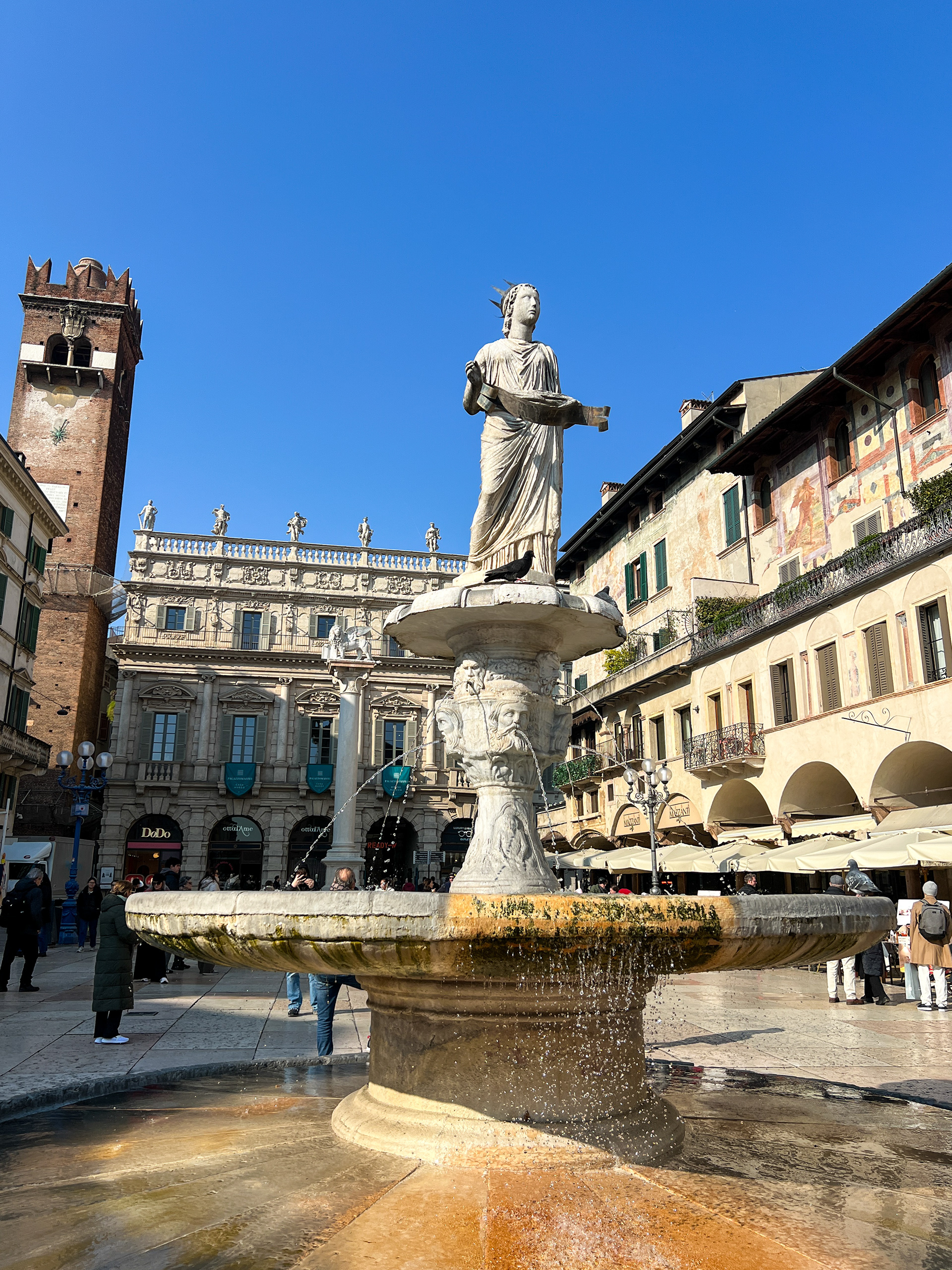
Madonna Verona Fountain, Piazza delle Erbe

Piazza delle Erbe
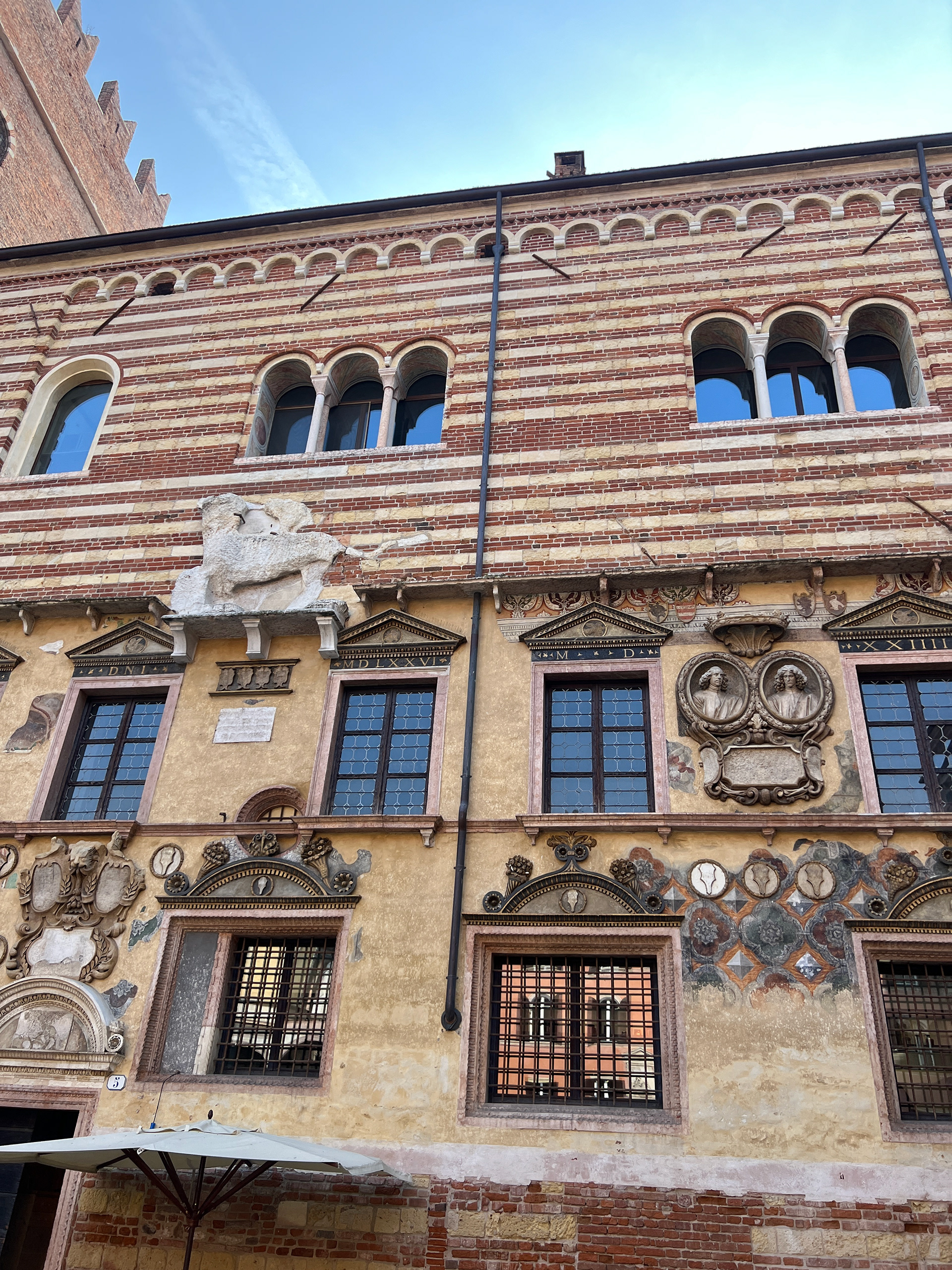
Piazza dei Signori
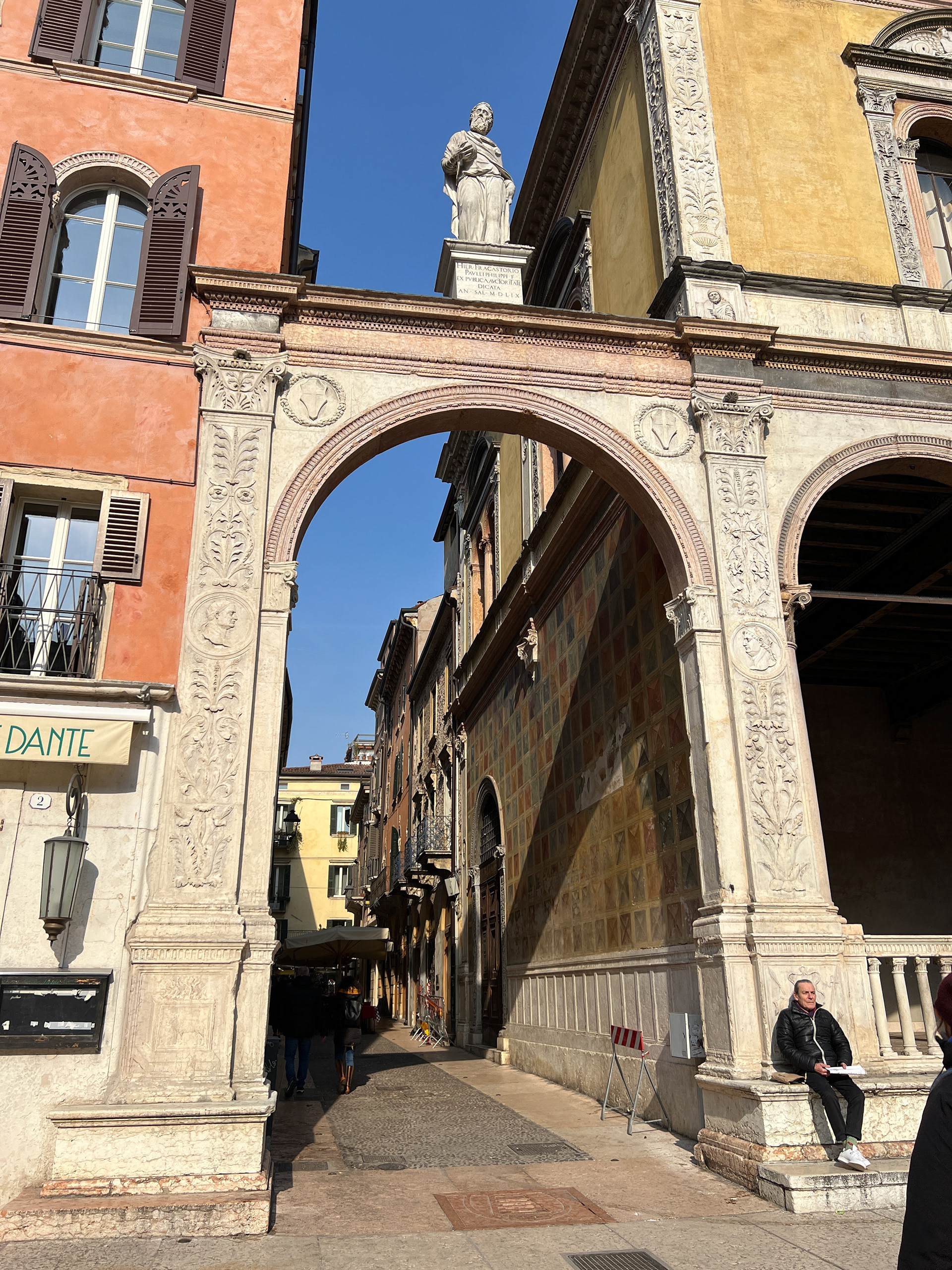
Piazza dei Signori
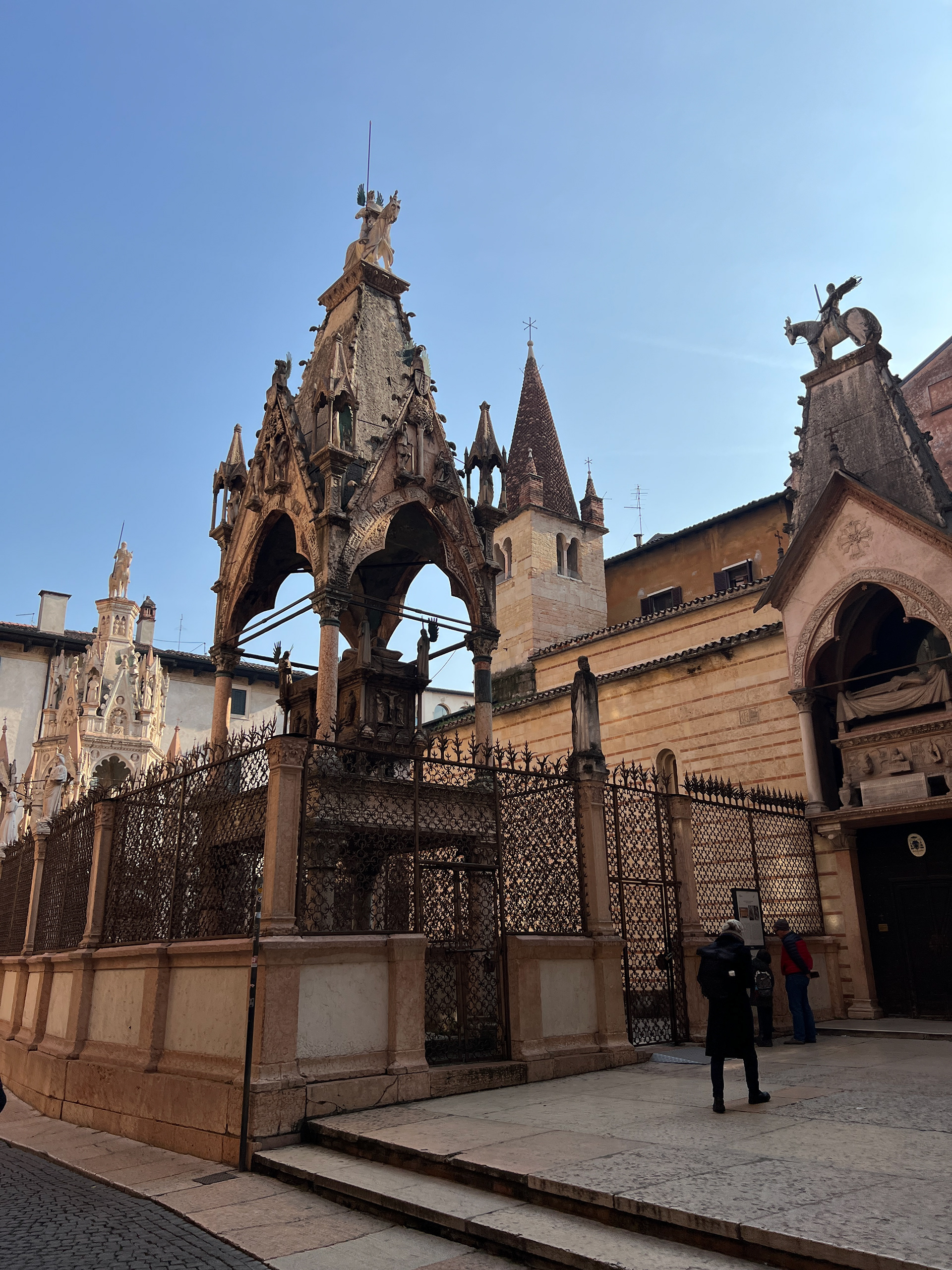
Scaliger Tombs

Piazza dei Signori
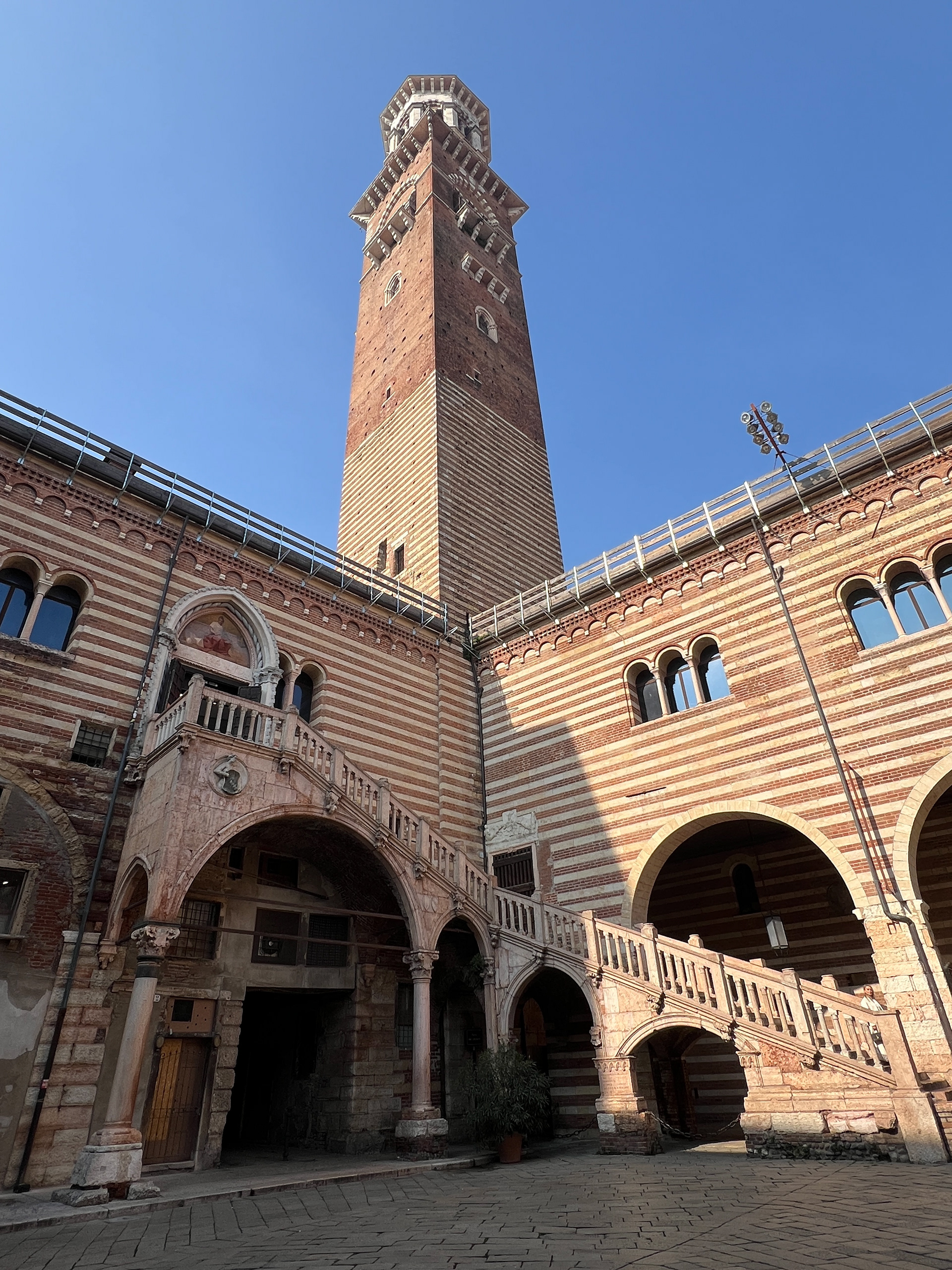
Piazza Mercato Vecchio
Food
We, of course, did our best to get a taste of the local food. We were recommended Cafe Martel where Daniel got a sandwich and Emilie, a strawberry tart. Daniel did his best using what he knows of Italian, and is starting to get somewhat good at ordering, with the patience of the waiter. We would recommend Cafe Martel for its quaint vibe, friendly staff, and yummy morning snack.
Tripadvisor highly recommended Pizza Da Vincenzo which was a small hole-in-the-wall joint with one worker, Vincenzo himself, who did not speak any english, but was very intrigued to learn as much as he could about us, which was another friendly moment for us to try out Italian with the help of Google Translate. The pizzas offered there were unique, probably more traditional for the area, we aren’t sure. It probably deserves the high rankings it gets online, but it is simply not our favorite style of pizza.
At the recommendation of our host, we went to Osteria La Fregola for which must have been an early dinner because we were the only ones seated in the restaurant. From the outside, you can see a small, nice seating area with tables, but our waitress took us downstairs to a much larger space kept up by brick arches and white plaster walls.
We were recommended to try the traditional dish Verona is known for, slow-cooked horse, and Daniel seriously considered it, but couldn’t find the courage to do it. We split gnocchi with speck and tortellini in a butter-rosemary sauce filled with an unknown meat; maybe it was horse.
Daniel felt silly not trying the horse when he shared about his weekend with his coworkers who raved about how good horse tastes.
We really enjoyed this restaurant, we would highly recommend it and if we go to Verona, we might go again. What we really enjoyed was the house wine, which one can get a glass for 3 or 4 euro, or buy the bottle for 9 euro. All locally sourced and made. Daniel was surprised by the cheap price, and when he exclaimed that surprise, the waitress had a confused look on her face and said, “it’s just the house wine.”
Our food experience was very good on this trip. One last thing to note was the gelato. Emilie found a well rated place called Gelateria la Romana which was a little bit of a walk outside of the ancient city area, but it was worth it. Some of our favorite gelato so far. We also discovered there is one in Milan very close to the apartment.

Osteria La Fregola
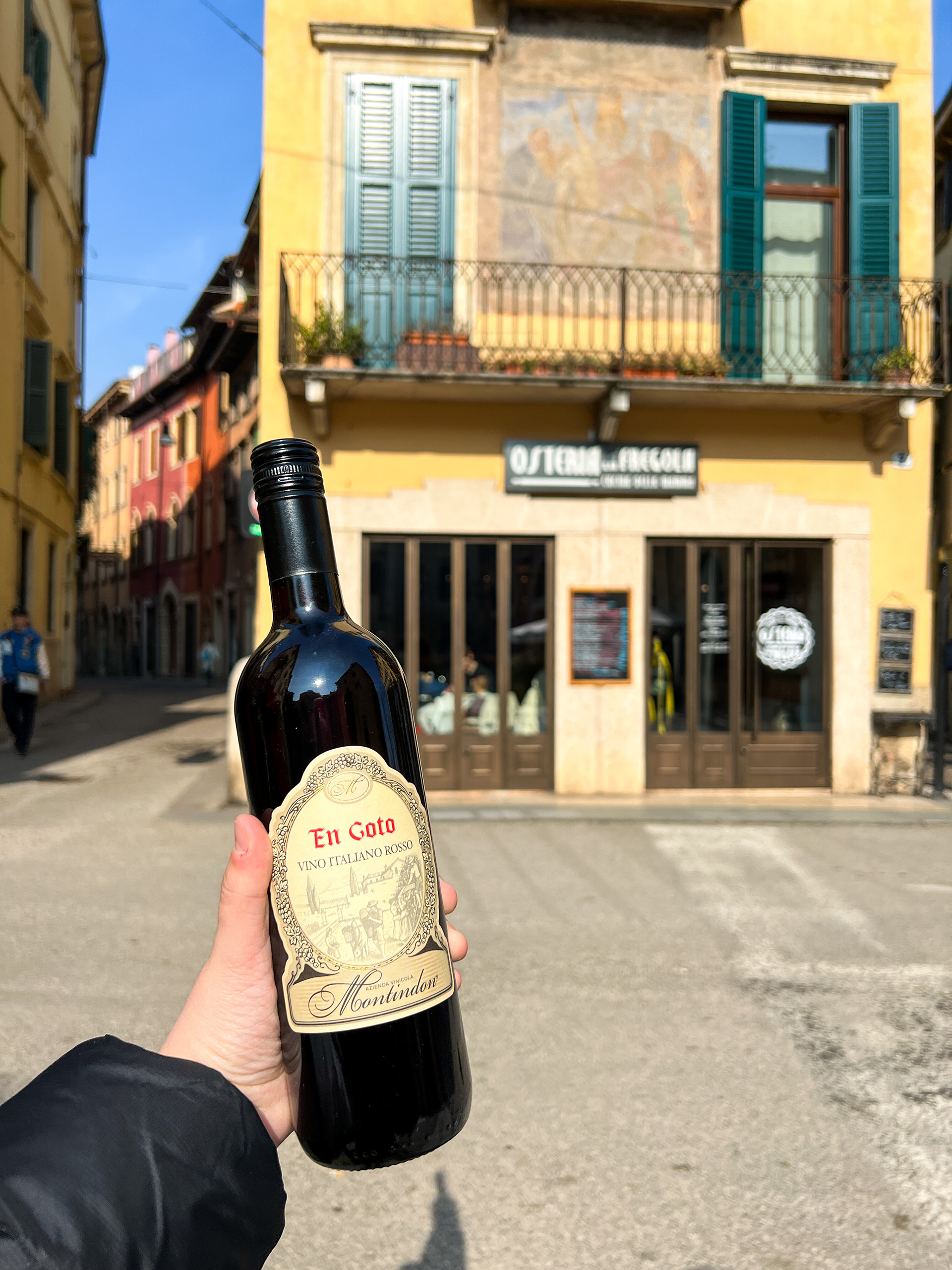
Red wine from Osteria La Fregola

Gelateria la Romana
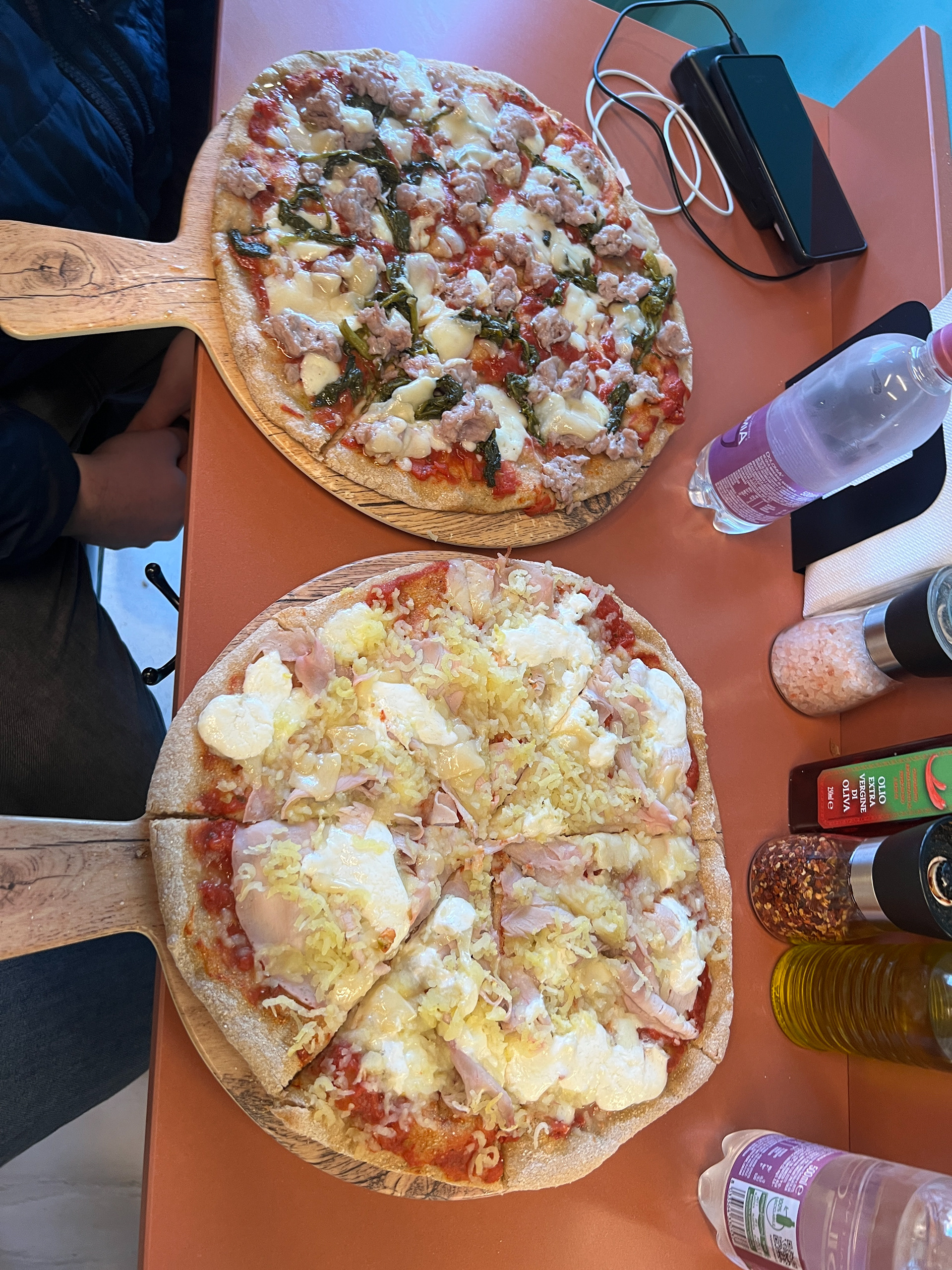
Pizza Da Vincenzo
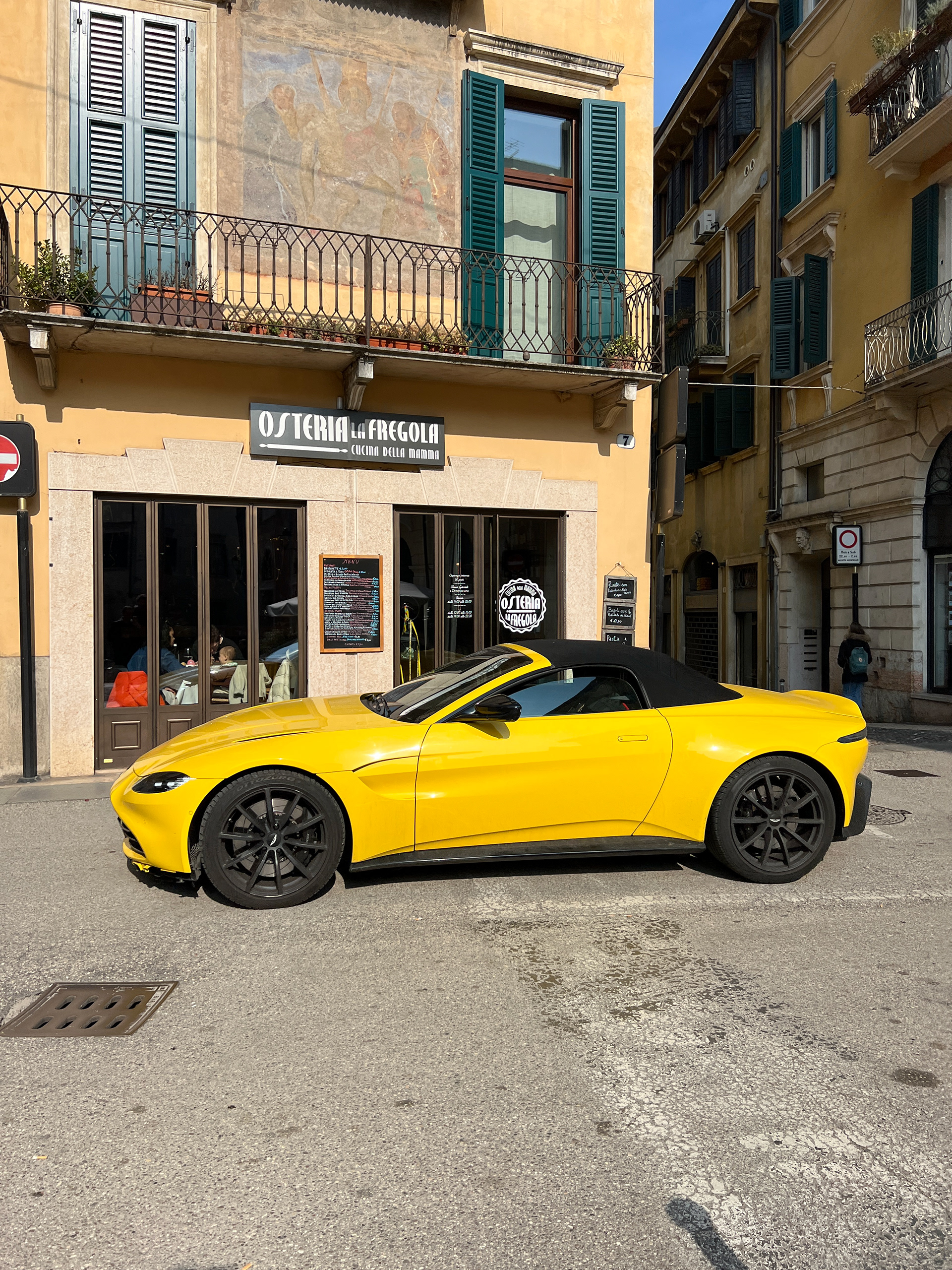
Yellow car in front of Osteria La Fregola
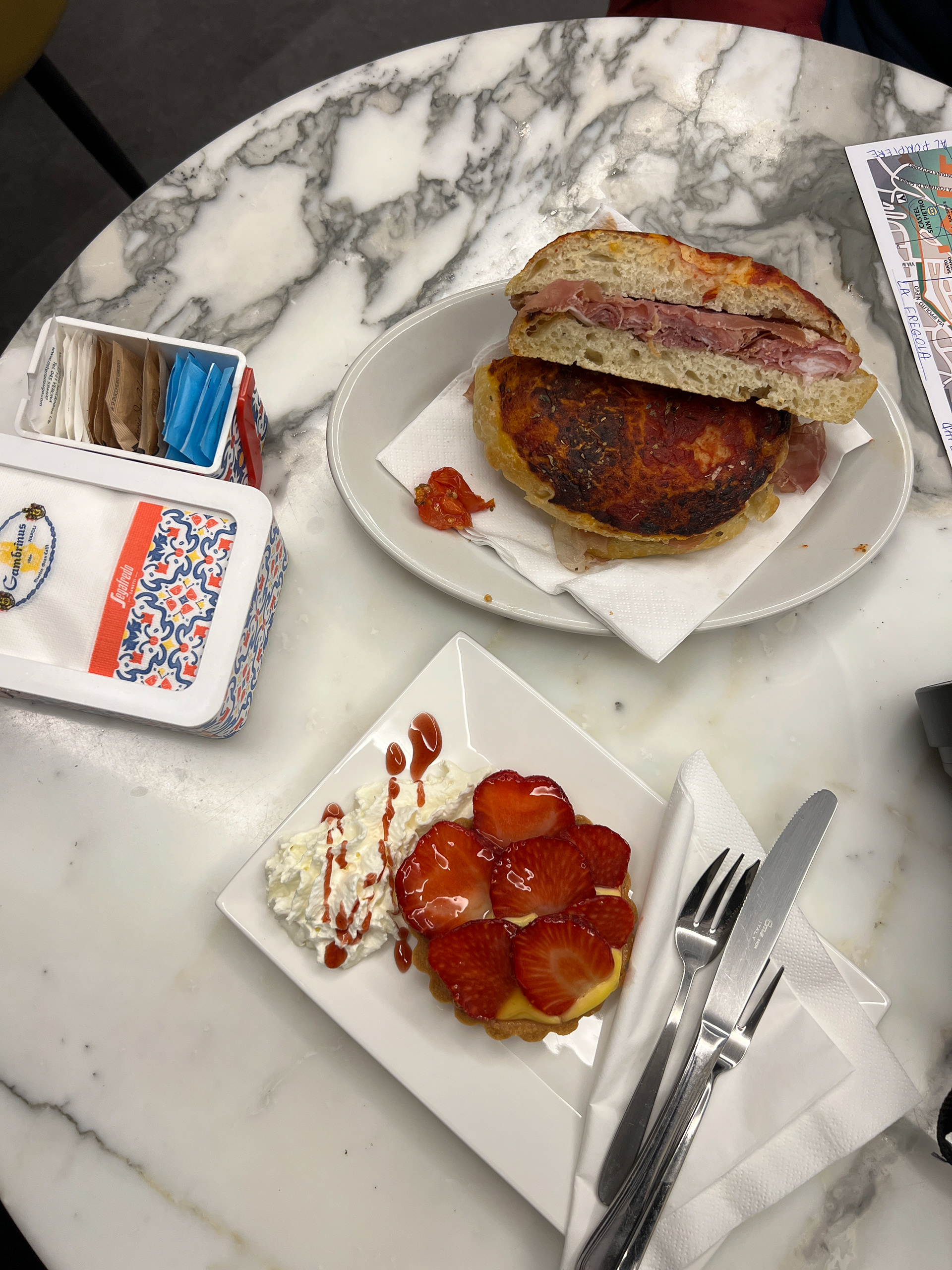
Breakfast at Cafe Martel
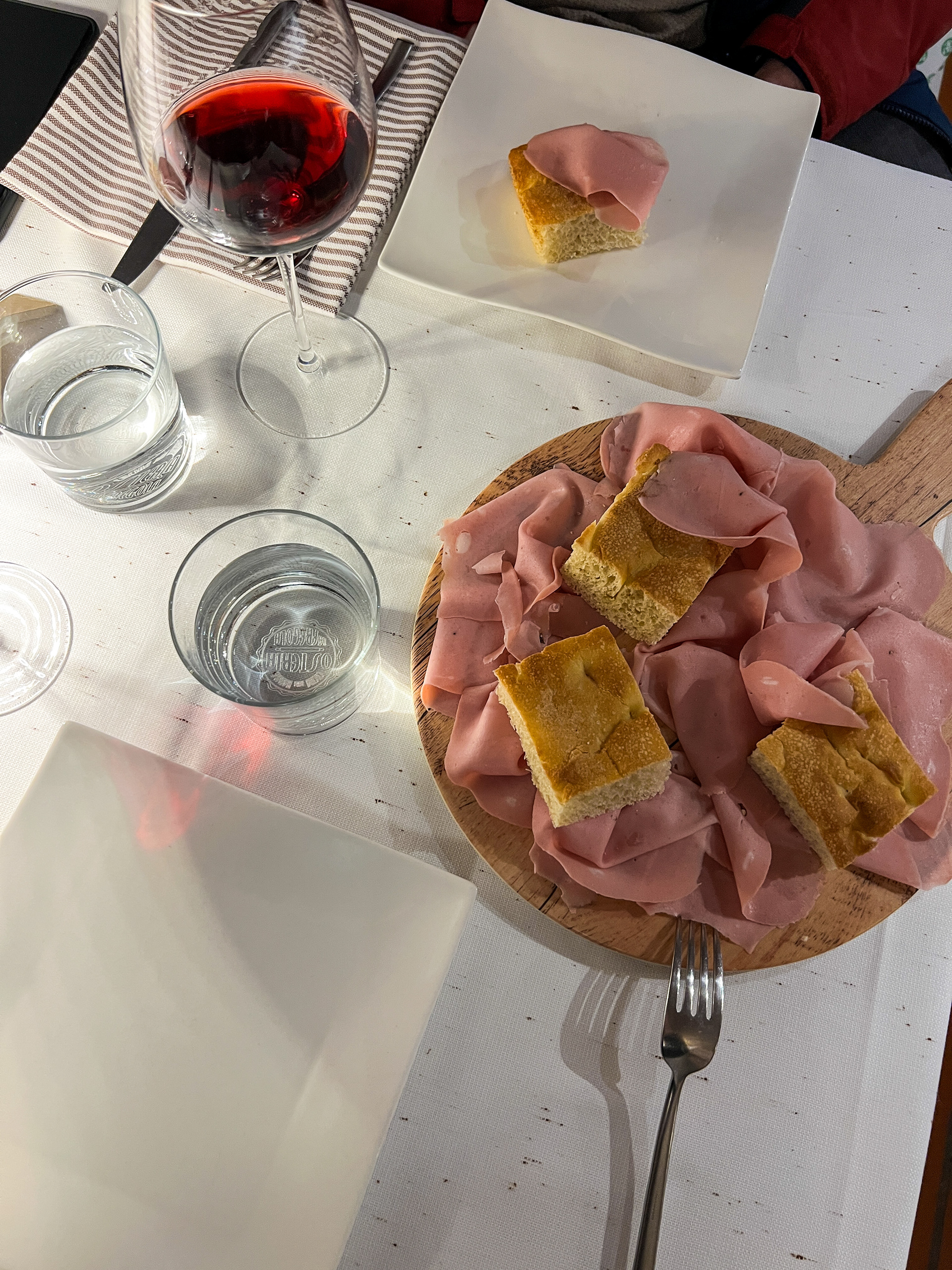
Appetizer at Osteria La Fregola
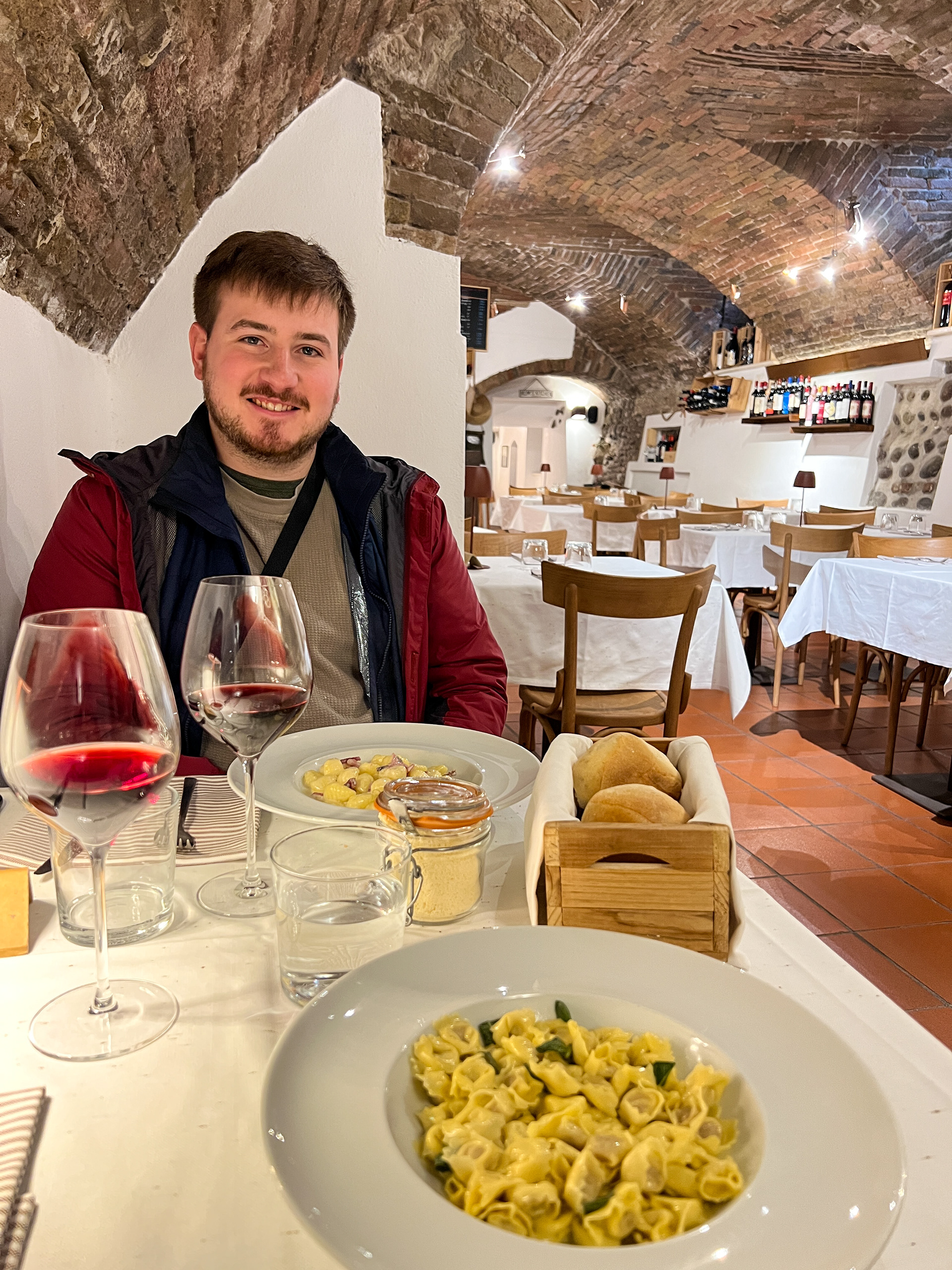
Daniel with dinner at Osteria La Fregola
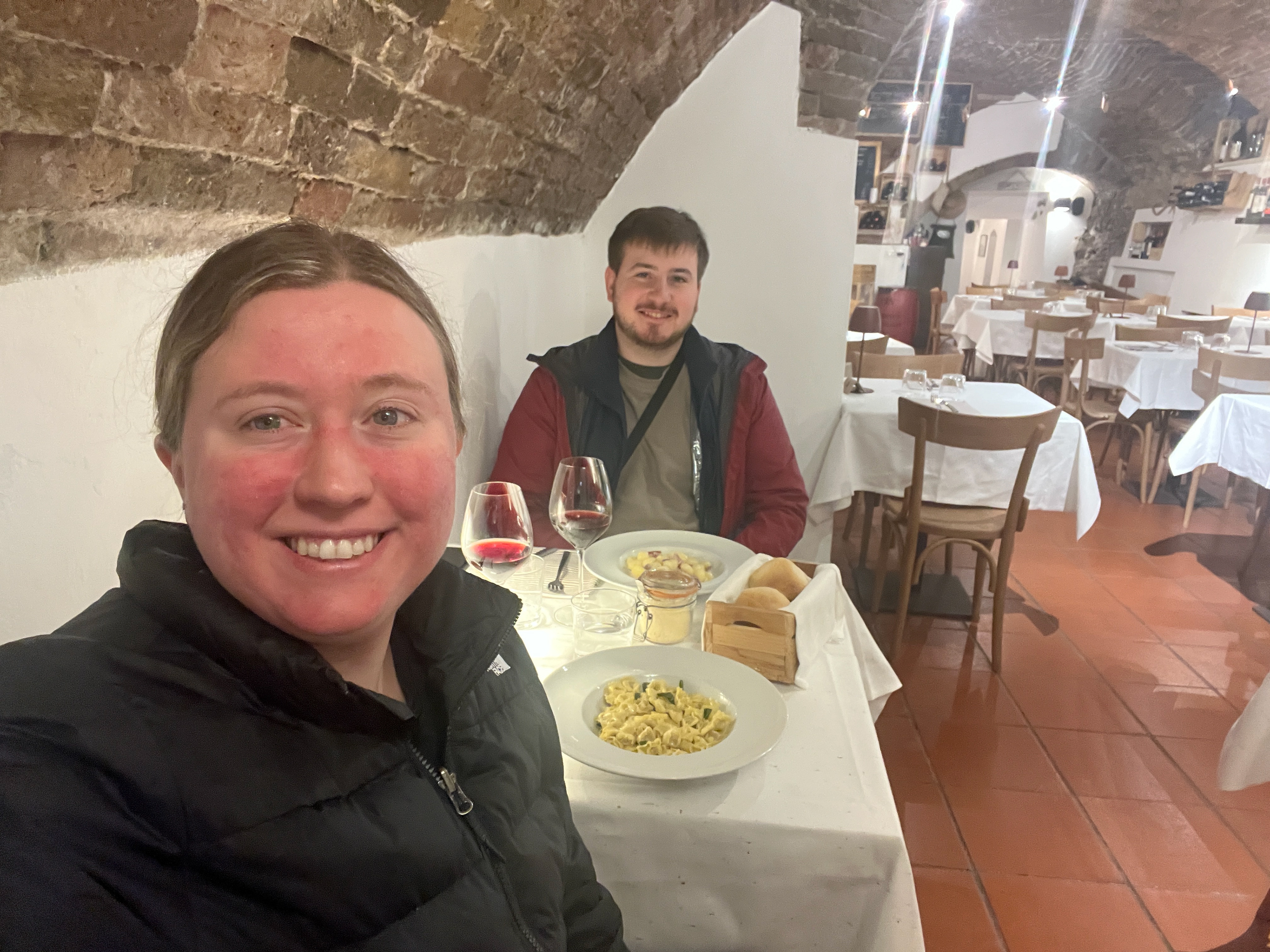
Emilie and Daniel with their dinner at Osteria La Fregola
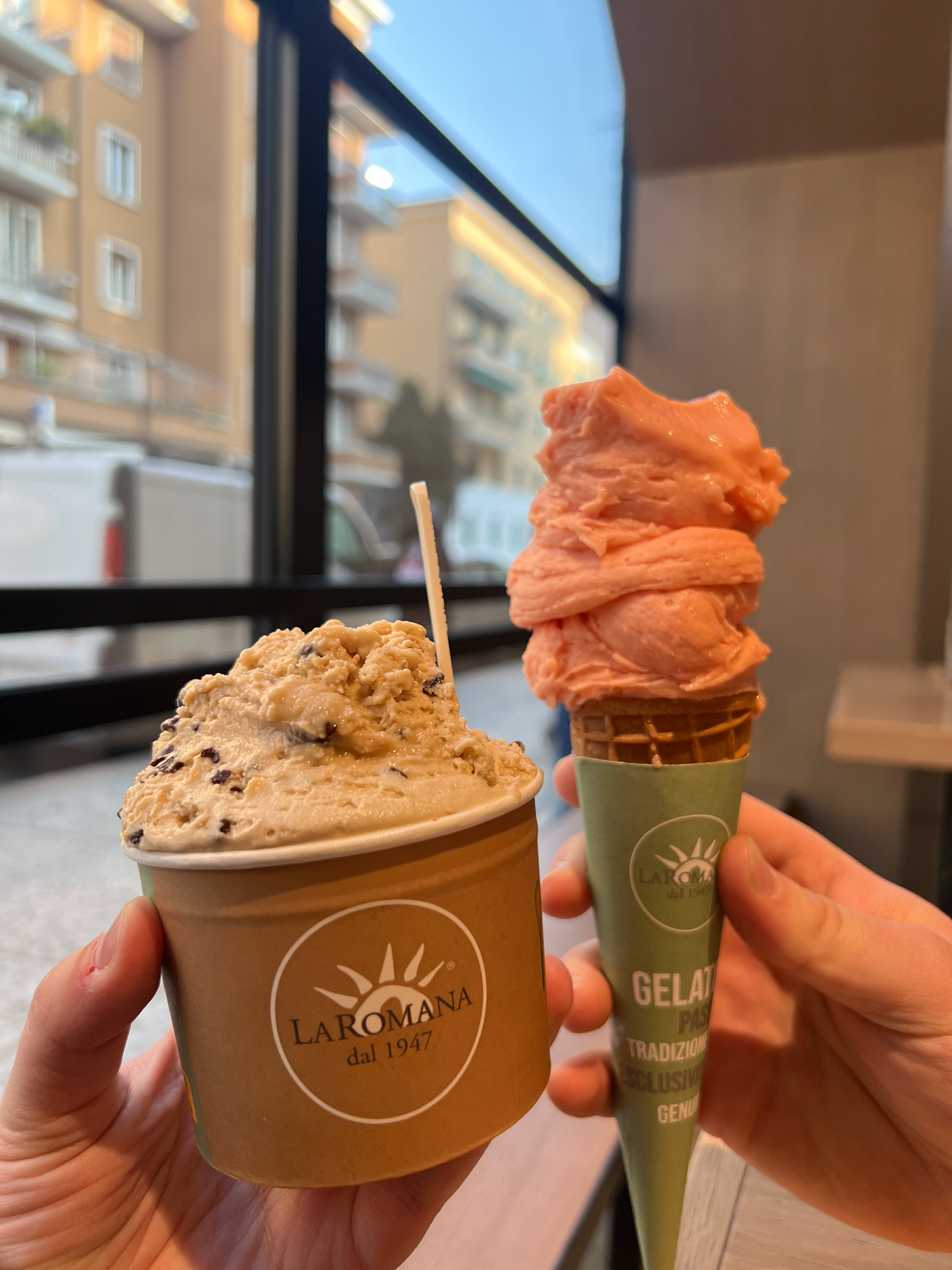
Gelateria la Romana

Menu of Osteria La Fregola
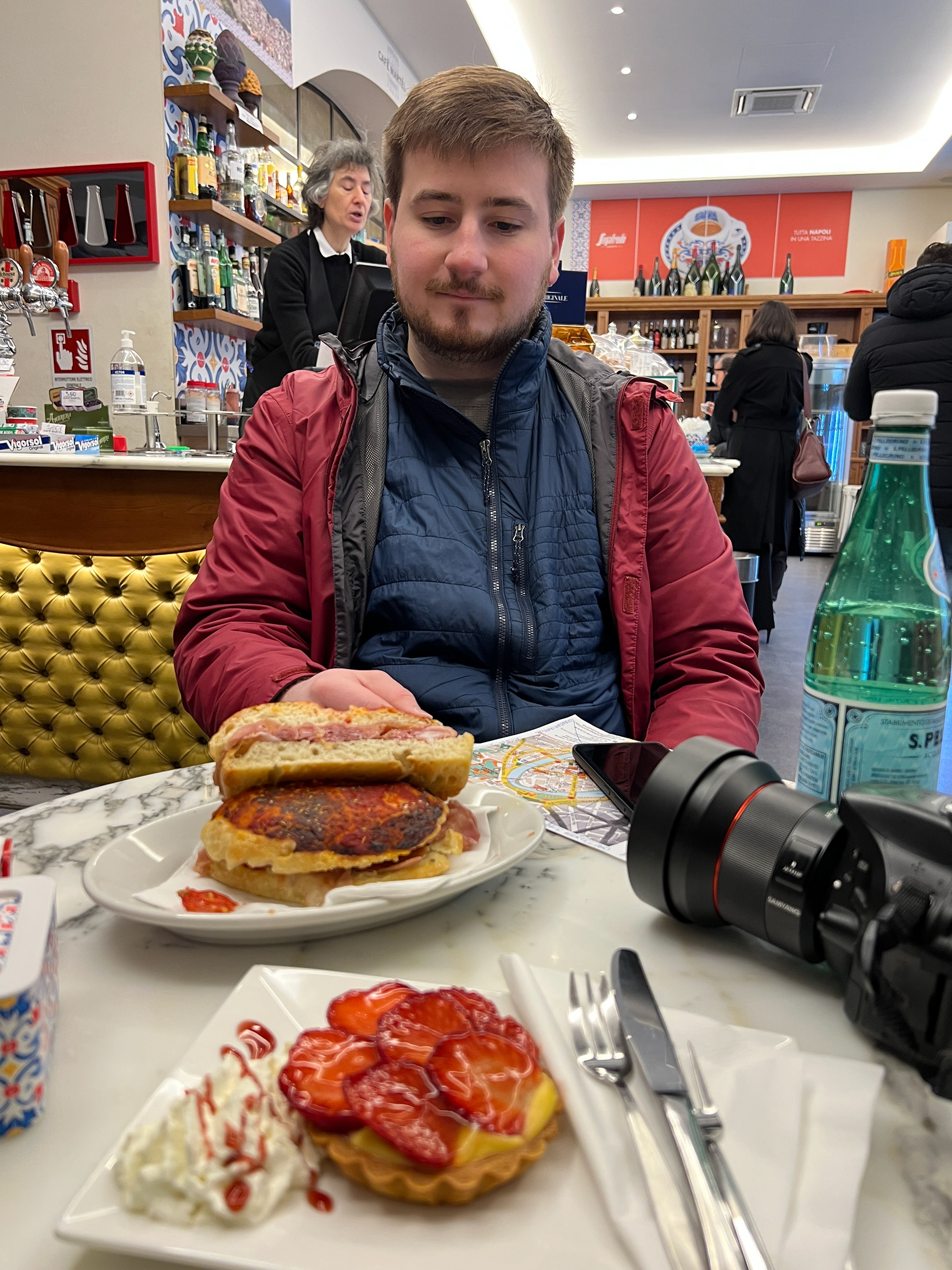
Daniel with breakfast at Cafe Martel
Casa di Giulietta
Verona has this odd connection to Shakespear’s Romeo and Juliet. There is a small balcony where people imagine Juliet would be calling for Romeo, and a statue stands at the main level below it. You can see the balcony for free, and pay to go into the museum and stand up there. We chose not to. We are not sure of the actual connection, but we know Shakespear did not base his play off of this area. However, here are a few pictures!
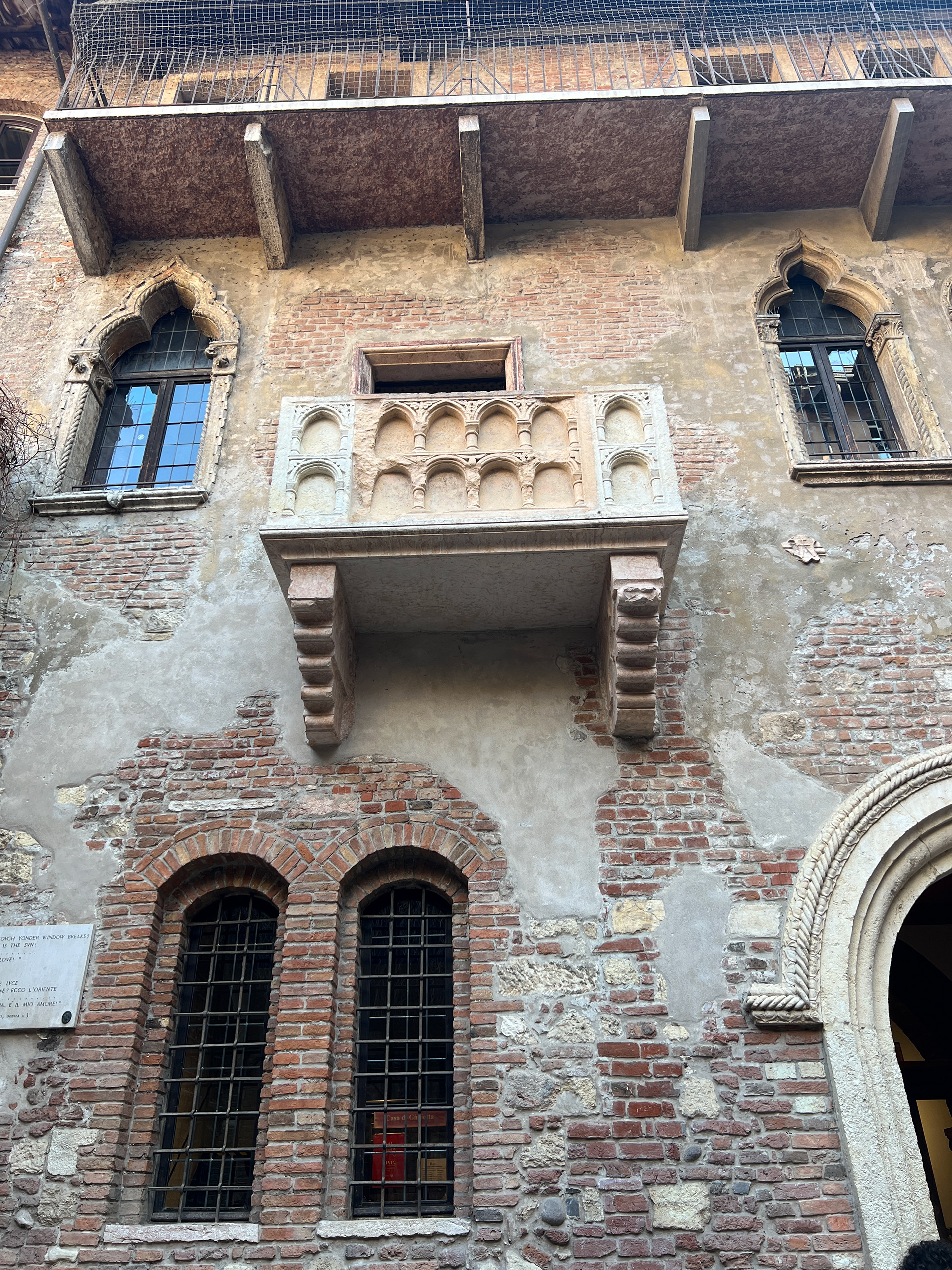
Casa di Giulietta
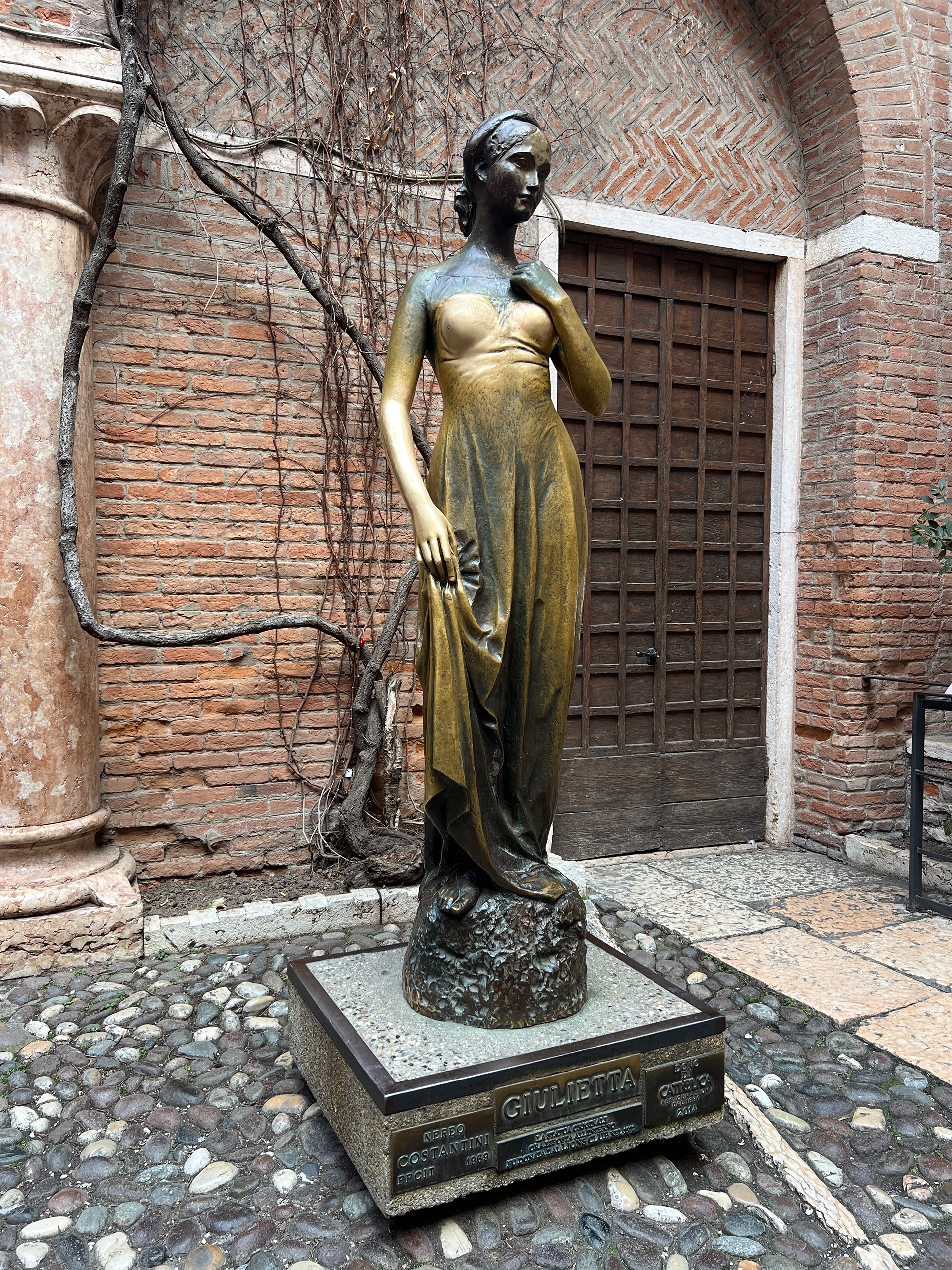
Statue of Juliet
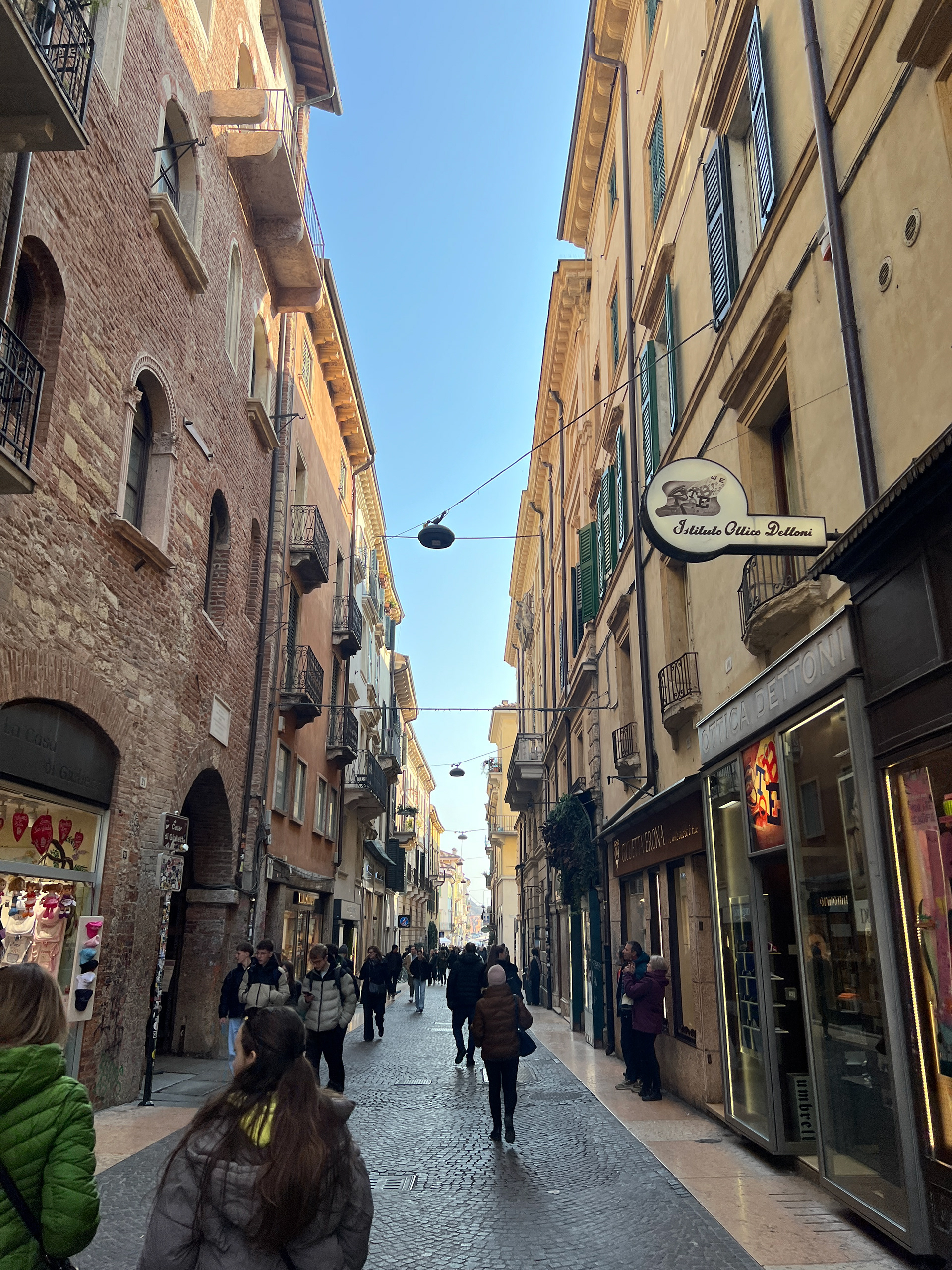
All in all, Verona was a great first trip during our time in Milan. We would recommend visiting Verona! If you had more time than just the one night, or you planned your time better, Venice is not too far from it, so you could really get the most out of this area. However, we did not go to Venice, not yet.
Thank you for reading. Check back for our next post!
– The Hills
